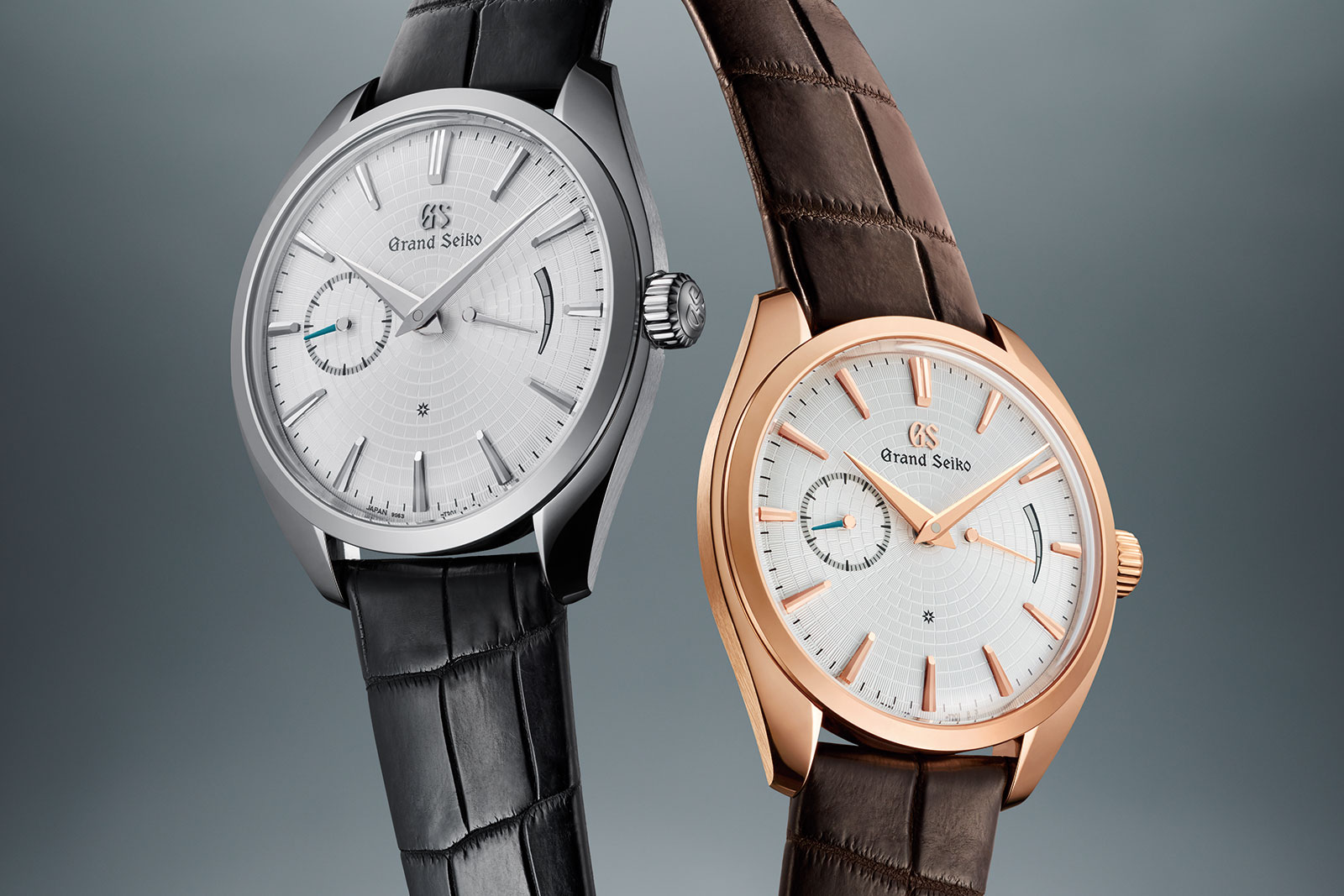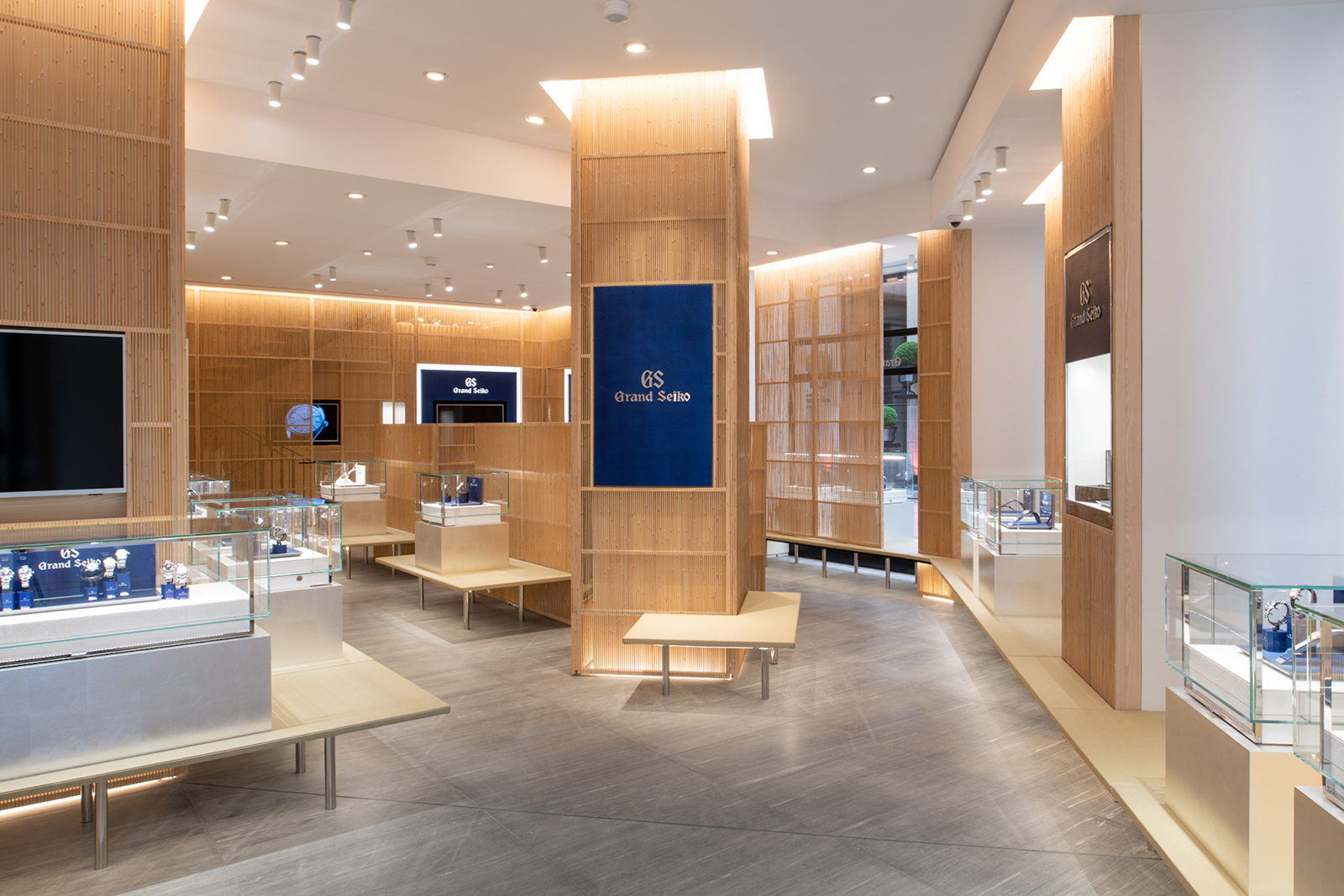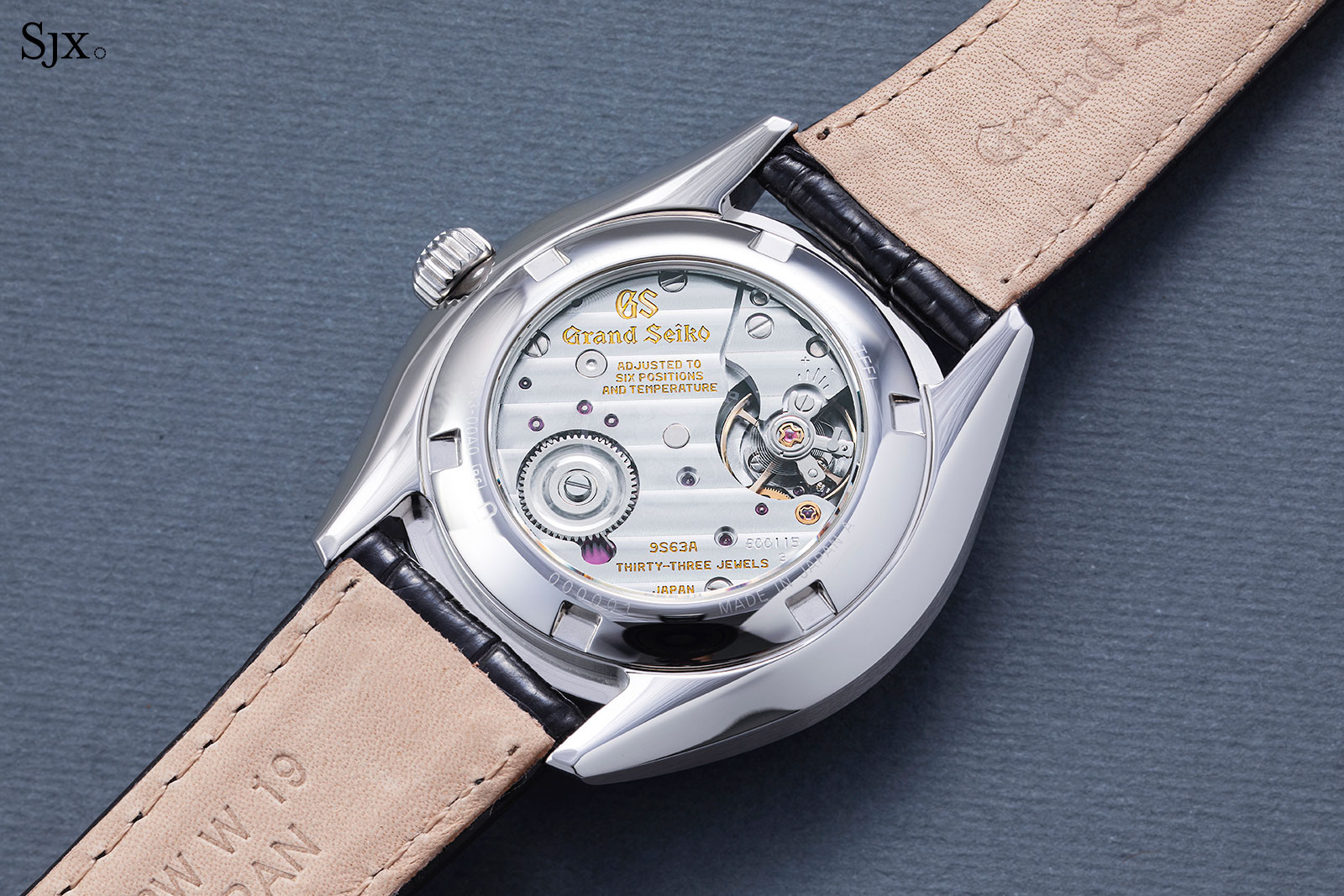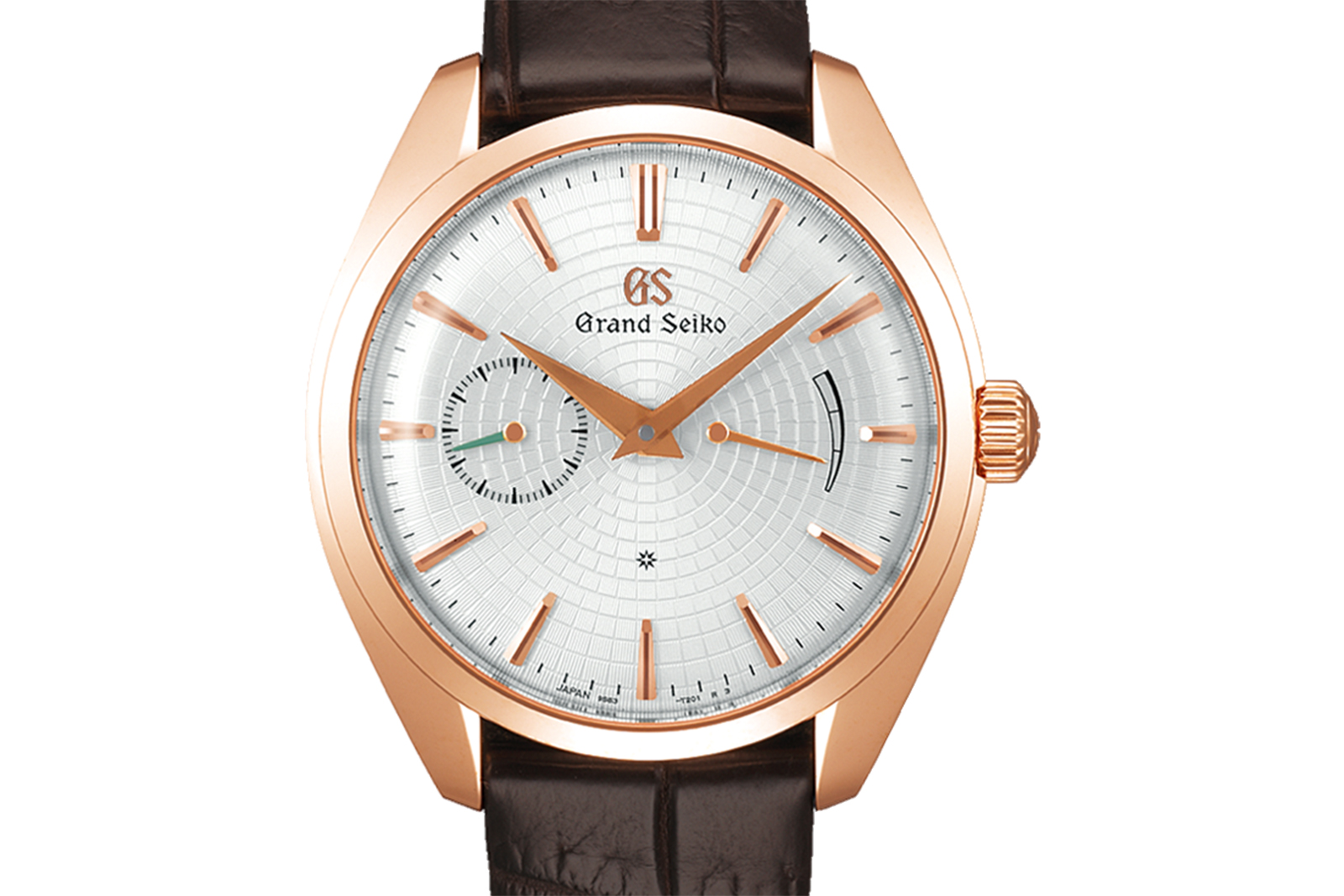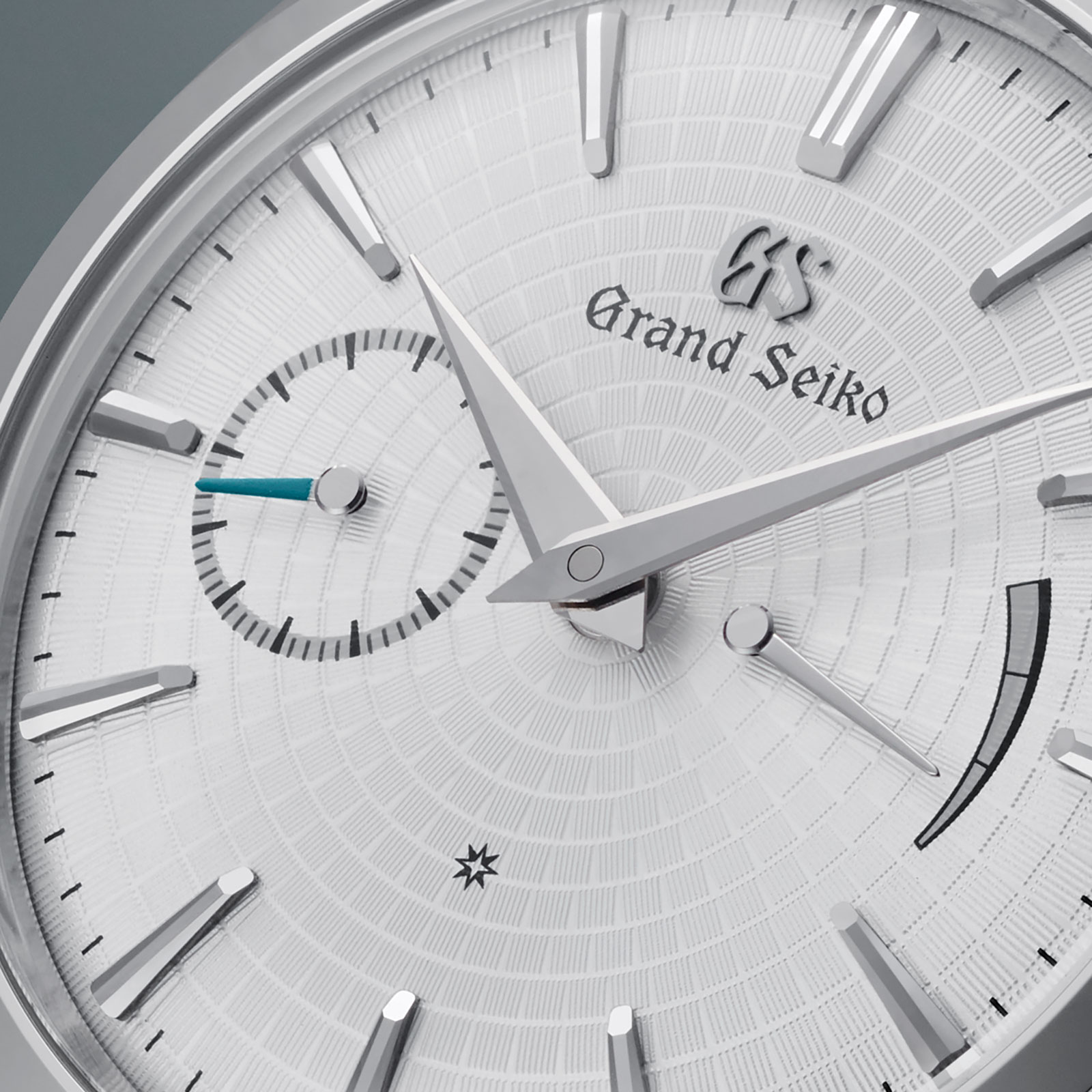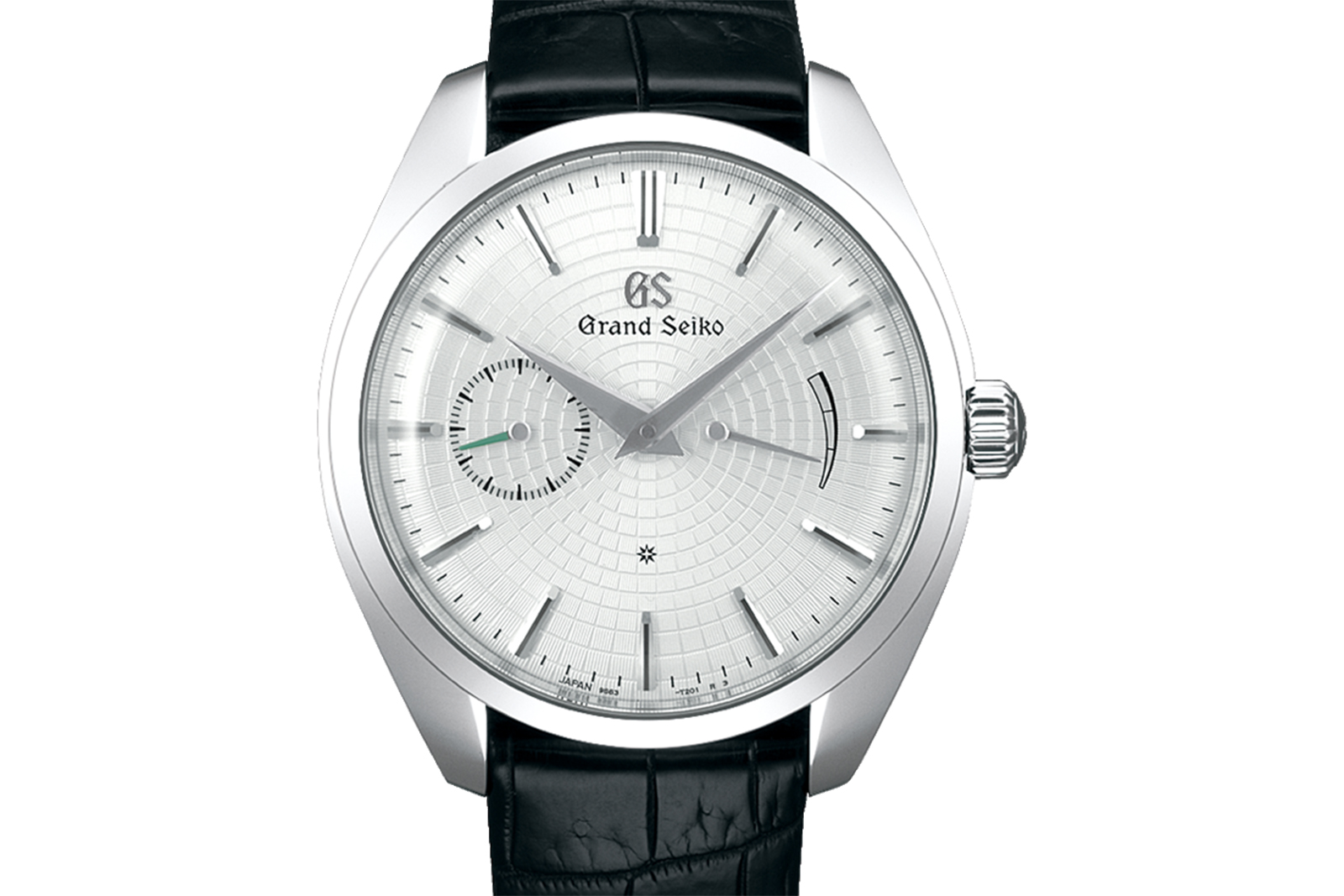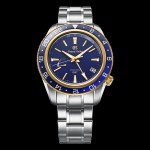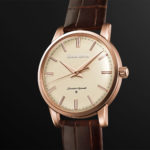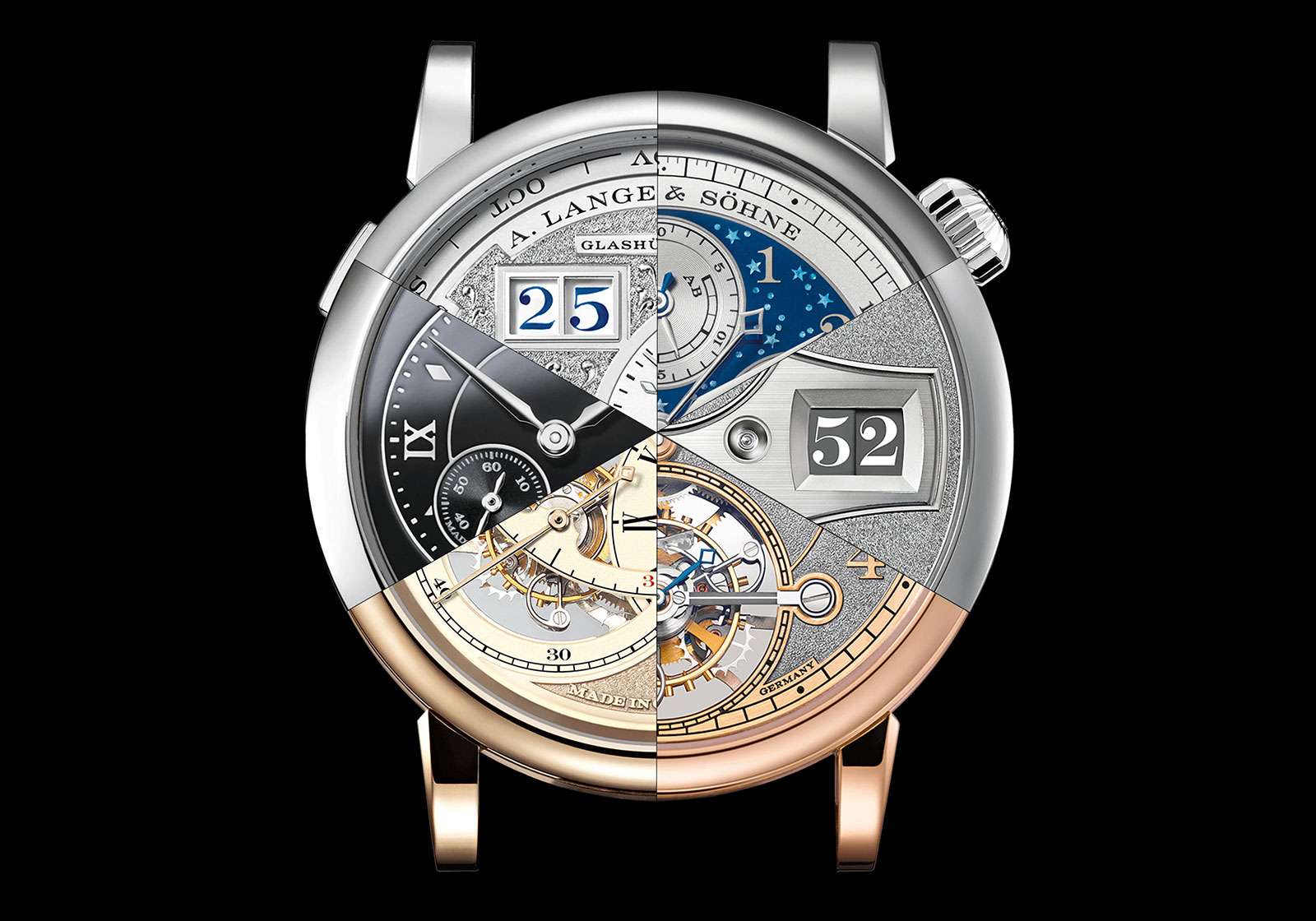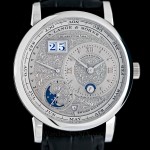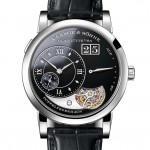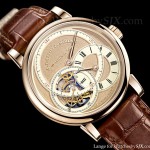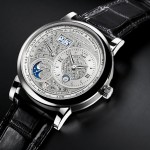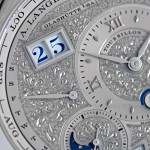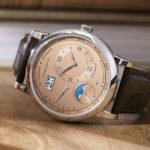When Walter Lange celebrated his 90th birthday in 2014, A. Lange & Söhne marked the occasion with a short interview. Asked how he would define the brand, the great-grandson of Ferdinand Adolph Lange quoted the late Günter Blümlein: “A Lange watch is a fusion of the arts… [and] the unique technology and artisanship to which we are committed.”
Lange has created many special watches since it was re-established in 1994, but one family of timepieces embodies Blümlein’s description – Handwerkskunst.
A line of limited-edition watches, Handwerkskunst – which translates as “craftsmanship” – is defined by traditional artistic techniques of decoration and exemplary hand-finish, a combination that is truly a “fusion of the arts”.
The goal of this article is to provide the context behind the creation of the Handwerkskunst series, and to detail the individual models. The focus will be on the details of each model, how they differ from their standard counterparts, and the realised prices at auction – livened up by my personal experience and opinion.
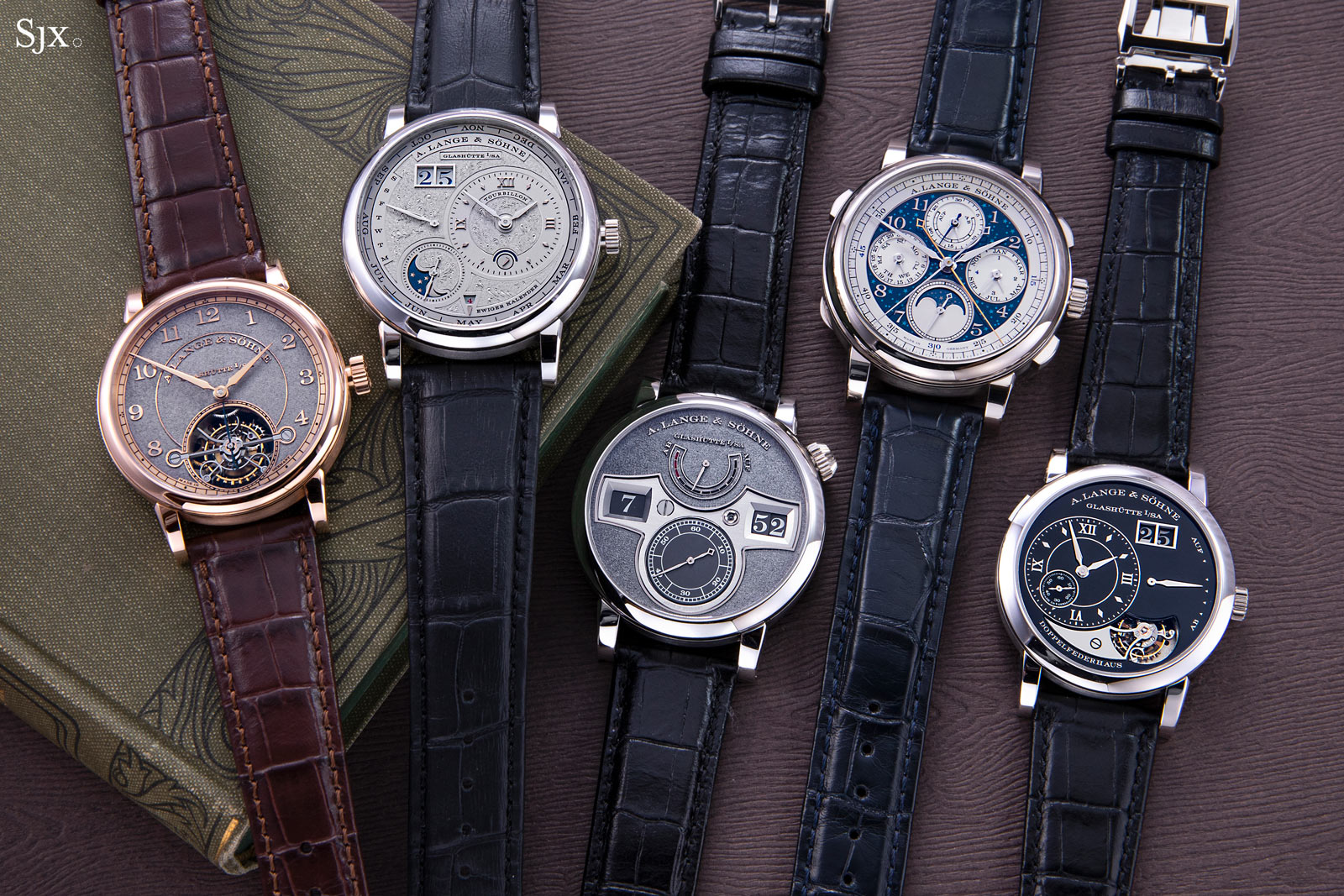
Five of the eight Handwerkskunst models launched to date, without the Richard Lange Pour le Merite, Cabaret Tourbillon, and Datograph
Why handwerkskunst?
I am often asked why I love Lange watches. It’s a long answer, but one reason goes beyond the watch themselves – it is the brand’s determination to preserve and develop the artisanal crafts in Saxony. In fact, Lange is something of a hub for artisans in the Saxony. Lange sponsors Dresden’s museums, grants scholarships to the best watchmakers, and interacts with craftsmen of all vocations across the state, from artisanal chocolatiers to porcelain makers.
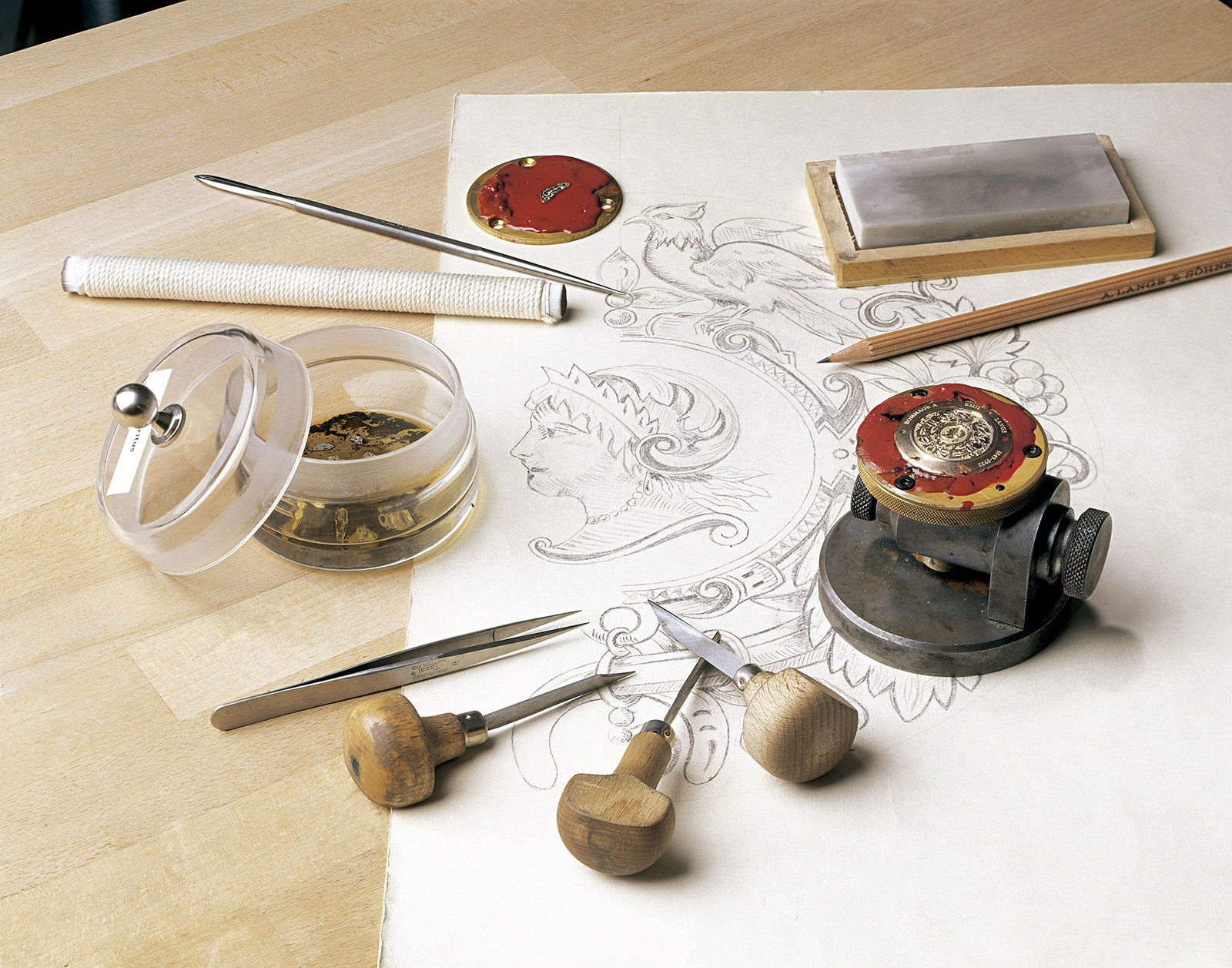
Tools and sketches of an engraver at Lange. Photo – A. Lange & Söhne
Set against this, the Handwerkskunst series is another way of perpetuating the traditional crafts. “Outperforming our already very high level of movement decoration by reviving traditional [techniques], or developing new finishing techniques, which accentuate the character of the respective model,” is how Anthony De Haas, Lange’s head of product development, describes Handwerkskunst.
So far, out of the brand’s large catalogue of potential candidates for the Handwerkskunst treatment, Lange has unveiled only eight models. Considering their success and repute among connoisseurs, there are more to come for sure.
The birth of Handwerkskunst
In some ways, the beauty of Handwerkskunst was born out of a crisis.
Lange & Söhne went through several management changes in its short lifetime. After its co-founder Günter Blümlein unexpectedly passed away in 2001, brand veterans Hartmut Knothe and Dr Frank Müller – who joined the brand in 1995 and 1998 respectively – led the company together until 2002, when Dr Müller departed to take the top job at Glashütte Original. And in 2003, Fabian Krone was appointed the chief executive, after spending much of his prior career at automaker Fiat.
During Mr Krone’s tenure, the brand unveiled exceptional watches, ranging from the Double Split to the Richard Lange Pour le Mérite with its splendid enamel dial. However, the financial crisis hit Lange hard, as it did the rest of the world. The effect on the watch industry was severe – Swiss watch exports declined 22.3% in 2009.
But the recovery in the watch business turned out to be swift, revealing Asia’s immense appetite for fine watches. Swiss watch exports jumped 22.1% in 2010, powered by sales in Hong Kong and China.
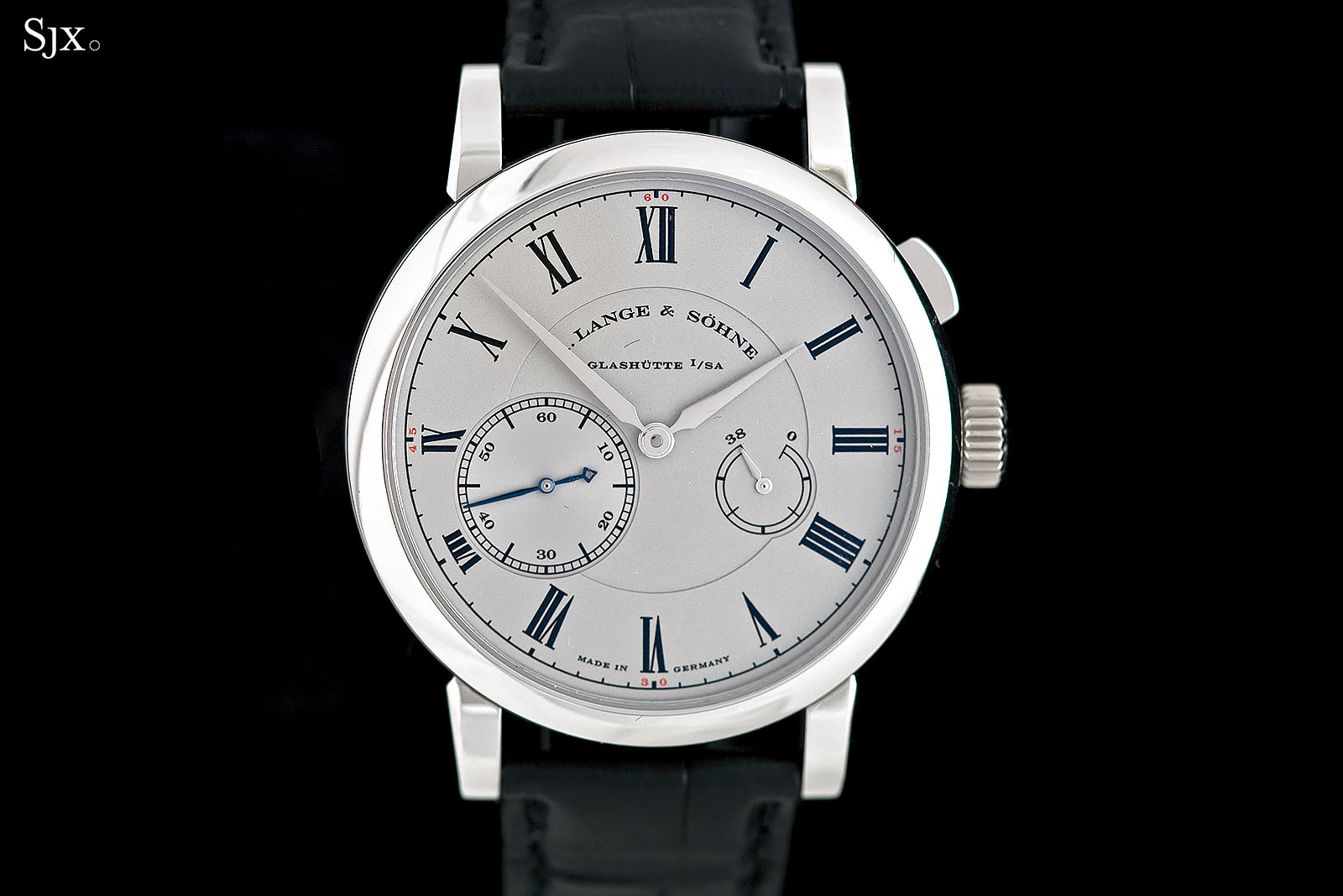
The Referenzuhr in platinum, a limited edition of 50 pieces introduced in 2007, along with 75 examples in pink gold
Lange’s product strategy evolved with the times. In the brand’s early days, most limited editions were often all-new models that were usually equipped with movements constructed from the ground up, like the Referenzuhr or 1815 Emil Lange.
But from 2010, in a more commercially-oriented pivot, the brand began debuting more limited edition watches distinguished by livery, typically with different case metals, dials, or decor. One example was the Homage to F. A. Lange, a three-piece set of honey-gold watches to mark the 165th anniversary since the birth of Ferdinand Adolph Lange.
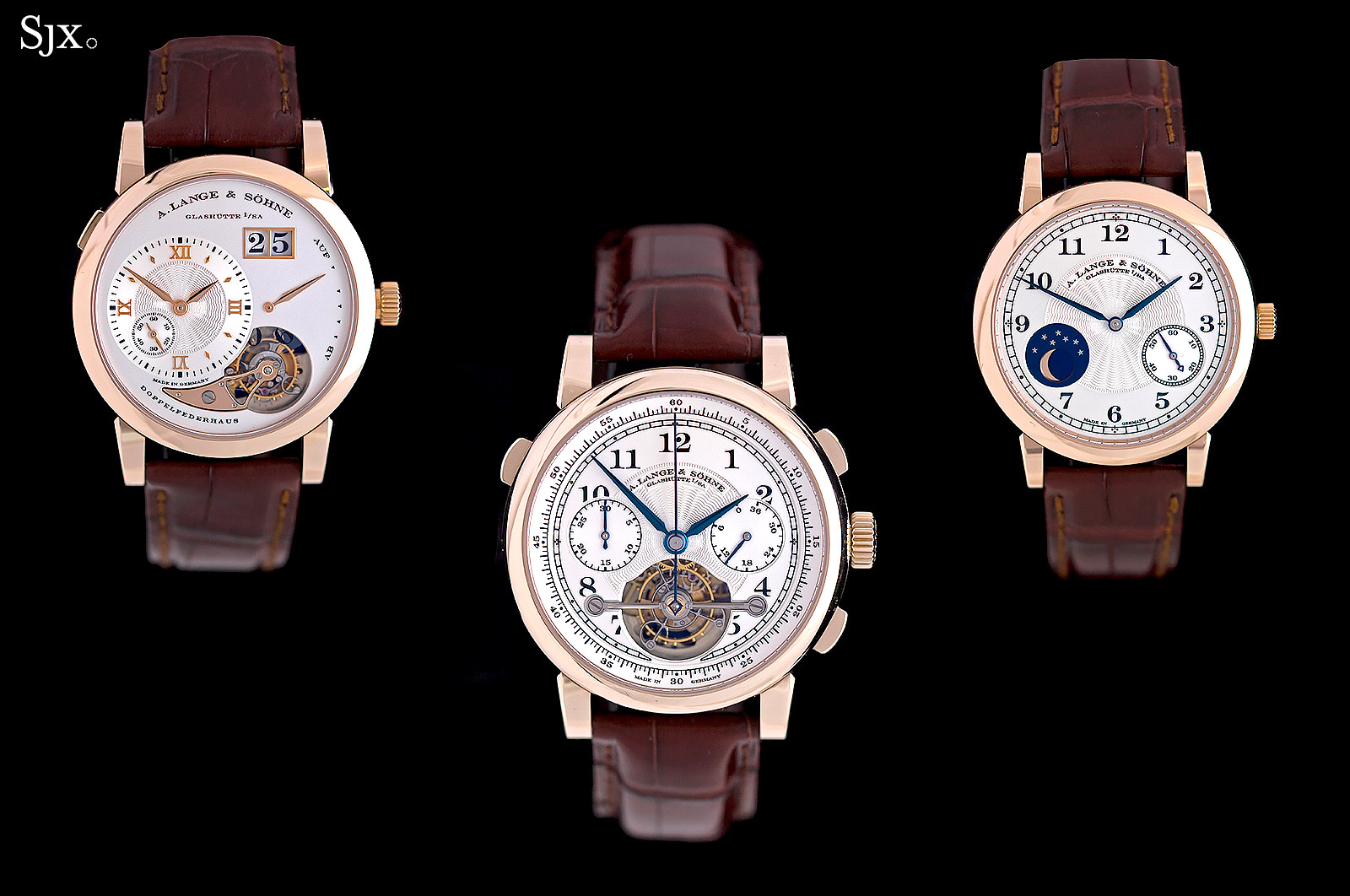
An odd anniversary celebration in 2010 for 165 years
In 2011, one of the most exclusive series to date – one that truly deserves the appellation “special edition” – arrived, the Handwerkskunst.
All the Handwerkskunst models share a few common qualities:
- Due to the extremely finely finished components, each watch is assembled by one specially-trained watchmaker from start to finish.
- Compared to standard models, the assembly of a Handwerkskunst watch requires an additional two to three days on average.
- On some models, the case back ring is wide and sloped instead of the two-step ring found on ordinary models, in order to maximise the space for engraving.
- All the lettering on the movement bridges are hand engraved.
- Each edition is limited to 30 watches or less.
- Except the Zeitwerk and Lange 1 Tourbillon, all Handwerkskunst models are technically identical to the standard-production equivalents.
- Notably, the style and details of the movement finishing got more elaborate as the series progressed, in my opinion.
It is important to note that there is no special timing for the launch of Handwerkskunst editions. Each edition is solely based on the finding the perfect combination of the right model paired with the correct and complementary decorative technique in order to create a coherent story and style.
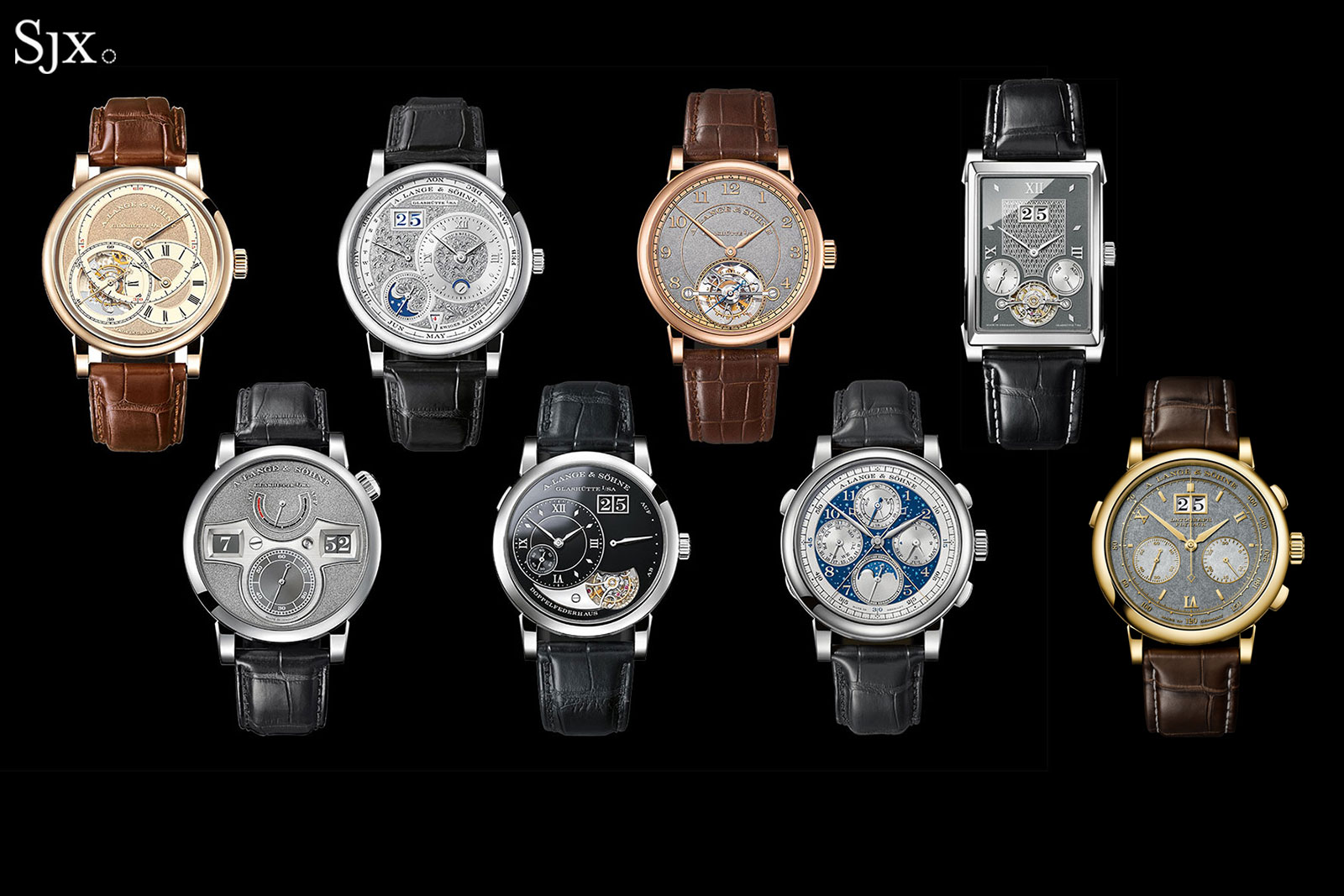
The eight-strong Handwerkskunst collection as of 2024
2011 – Richard Lange Tourbillon Pour le Mérite Handwerkskunst (ref. 761.050)
As contemporary as its overlapping, Venn-diagram dial appears, the Richard Lange Tourbillon Pour le Mérite was inspired by a creation from over 200 years ago. And its birth was all down to a coincidence.
At Lange headquarters, product development head Mr de Haas and Tino Bobe, the factory director, have adjacent offices. When brainstorming for ideas, both of them referred to the seminal Lange reference tome by Reinhard Meis. Soon each realised the other had bookmarked the exact same page in the book – one detailing a pocket watch from from 1807, chronometer no. 93 made by Johann Heinrich Seyffert.
Clockmaker to the royal Saxon court, Seyffert was a key figure in 19th century watchmaking who made the watches that were relied on by explorer Alexander von Humboldt during his expeditions. At the same time, Seyffert played a crucial role in the history of Lange, having been a mentor to Ferdinand-Adolph Lange.
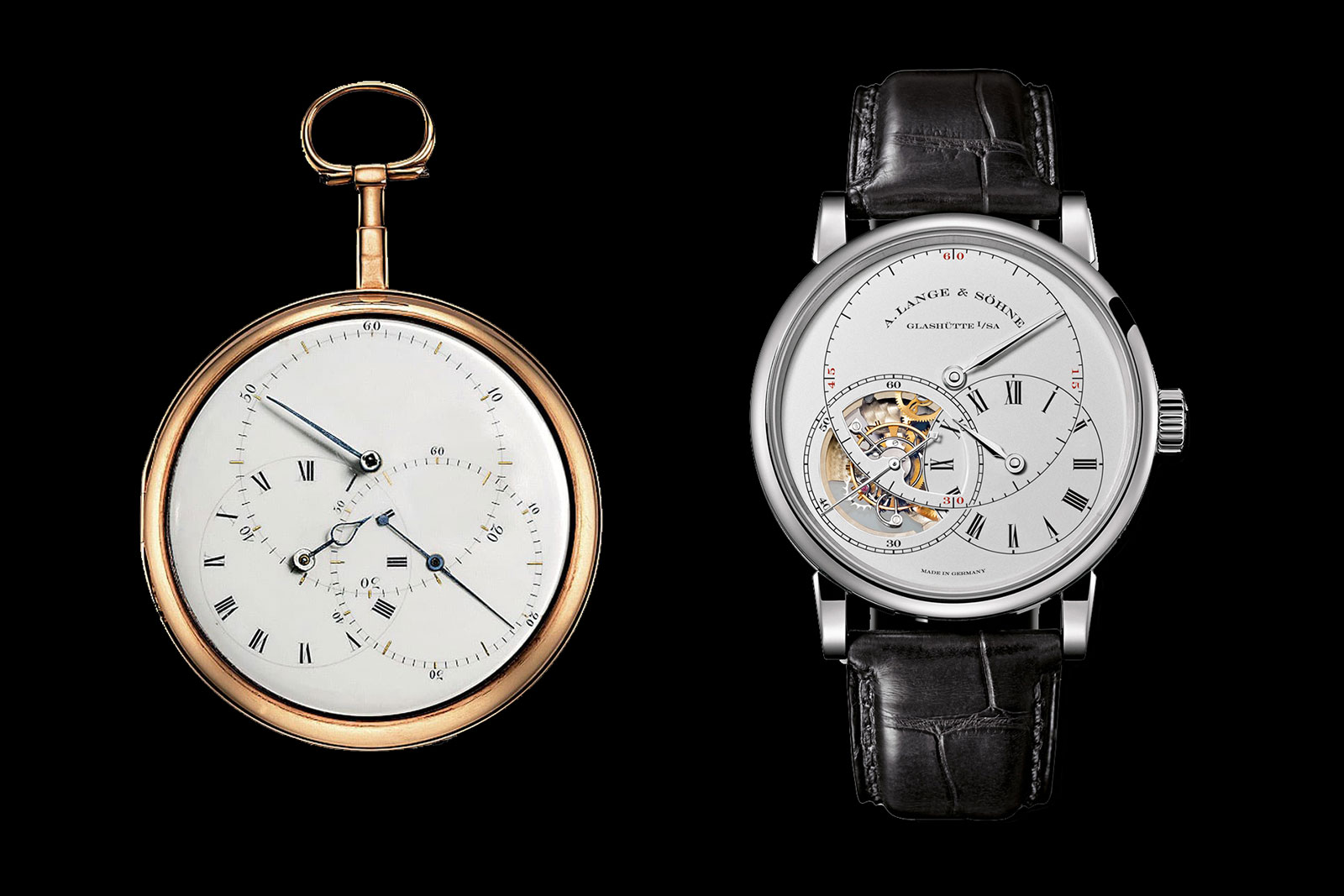
Seyffert’s chronometer no.93 (left), and the watch it inspired. Photo – A. Lange & Söhne
With Seyffert’s no. 93 providing the perfect historical inspiration, the two decided to create a wristwatch by modernising the 19th century pocket chronometer. The result was the Richard Lange Tourbillon Pour le Mérite that was launched in 2011.
A few months later in September of that year, Lange launched the Handwerkskunst version. The watch was but a facelift, but of the very best kind. Marking the birth of a brand-new line, the edition was limited to 15 pieces.
The dial
The case, hands and the dial of the watch are made of honey gold – a proprietary Lange metal that is harder than other gold alloys. To put it in numbers: 18k yellow gold has a surface hardness of 155 HV, and for white gold the value is 210 HV, whereas honey gold measures 300 HV.
Despite the increased hardness, the honey gold dial has been finely engraved with a granular surface, achieved by a technique known as tremblage. The method calls for a sharp-tipped burin to be repeatedly dug into the surface, in a different direction each time, removing tiny amounts of material, to create a randomly dimpled finish. The result is astonishing, with a three-dimensional texture just calls out for the wearer to break the crystal and touch it.
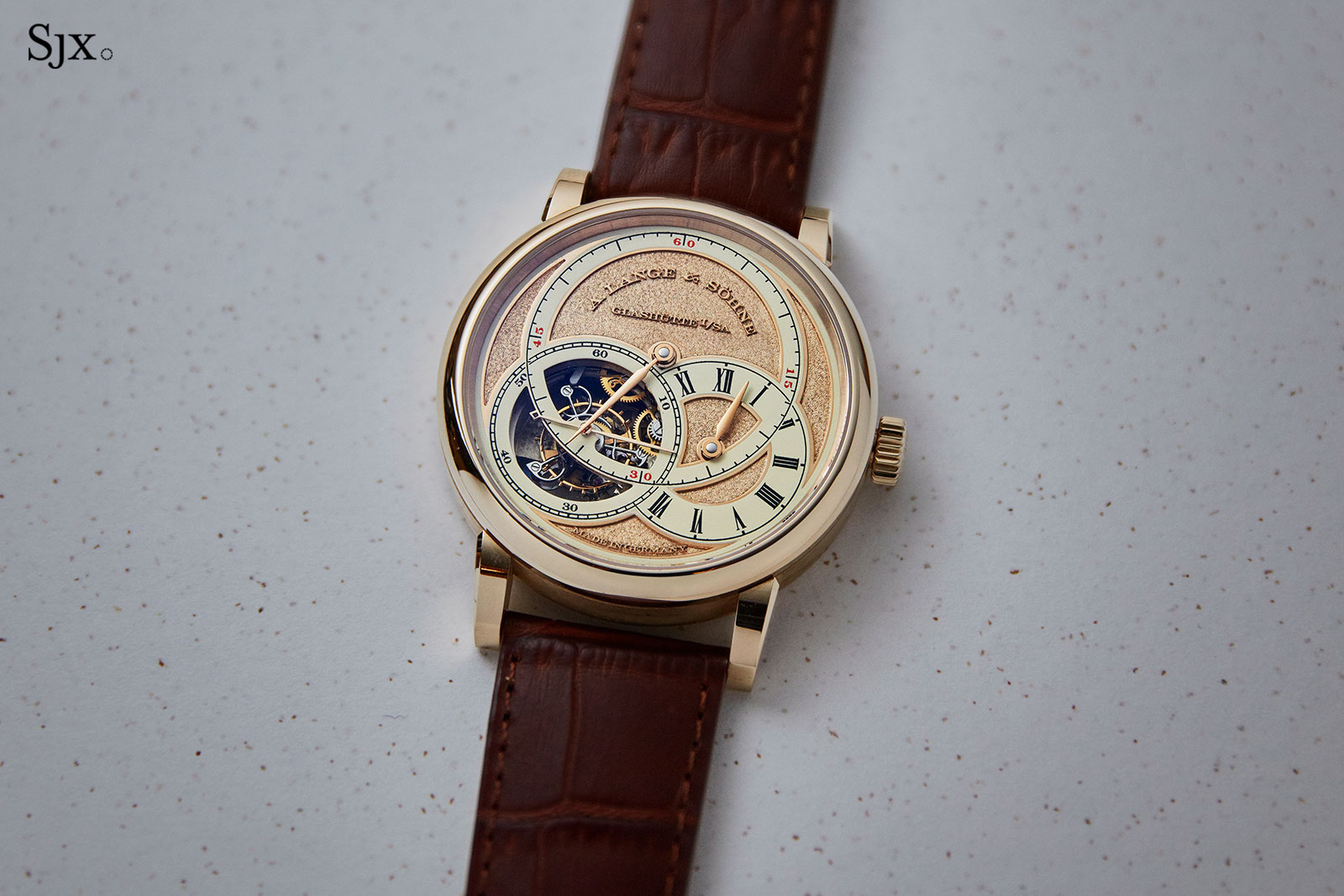
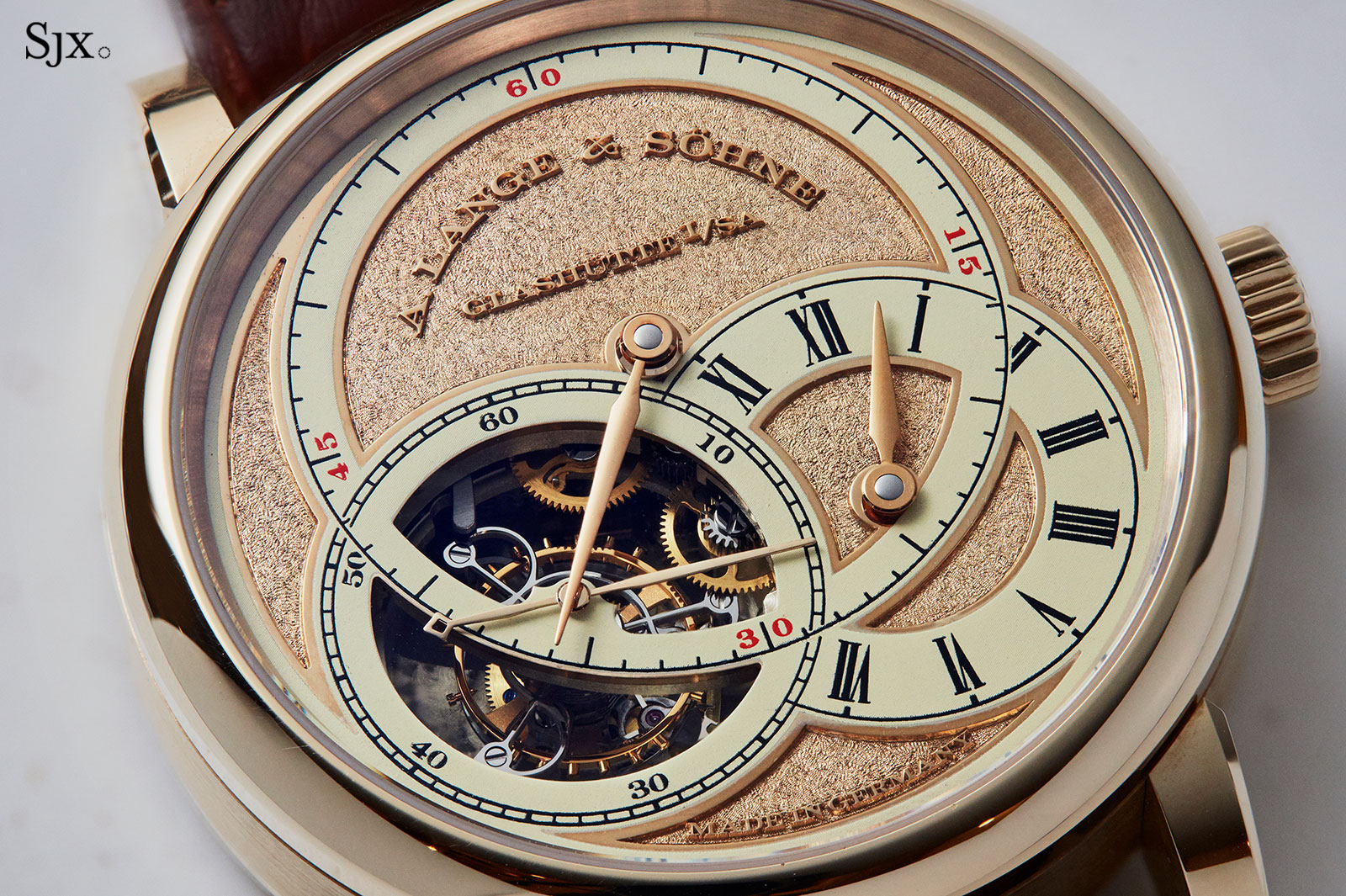
Even the logo is relief engraved, adding to the three-dimensionality. The logo is made bigger than on the standard dial due to the increased space necessary between the logo’s letters in order to accommodate the tip of the burin to engrave the dial surface.
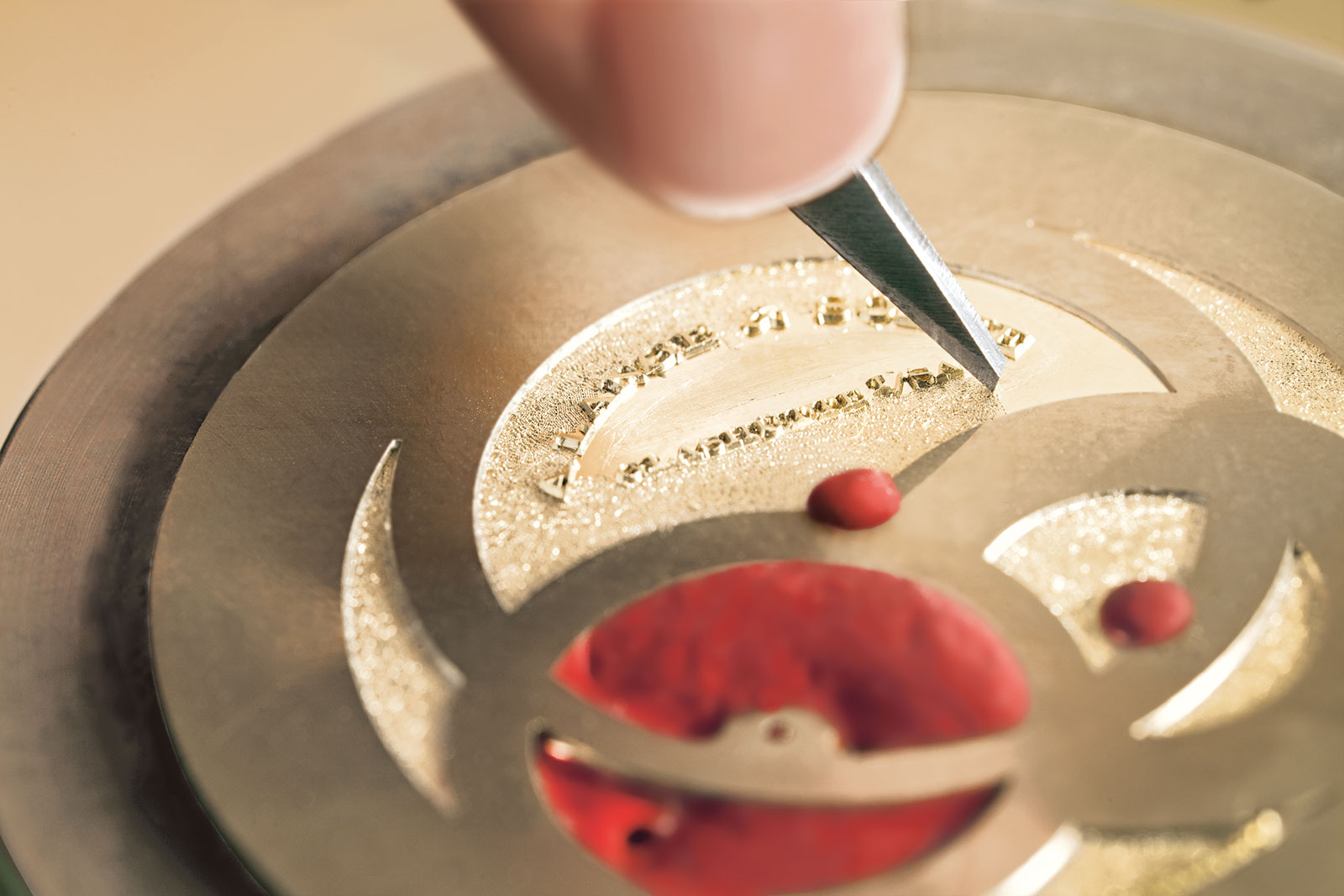
The honey gold dial was engraved to create a seemingly-random, grained surface. Photo – A. Lange & Söhne
The complexity of the tremblage engraving and the hue of the honey gold dial perfectly complement the superbly skeletonised movement, creating a greater harmony of aesthetics than on the standard editions. The visual coherence demonstrates how the Handwerkskunst decoration is not just a gimmick or haphazard add-on, but is chosen with perfect composition of the whole in mind.
The L072.1
The movement in the standard Richard Lange Tourbillon Pour le Mérite is already spectacular. Generous skeletonisation of the three-quarter plate that reveals the fusée and chain, and the beautifully finished tourbillon, are enough to love it. Ironically, in the Handwerkskunst edition, the decorative treatment falls a bit short on the movement.
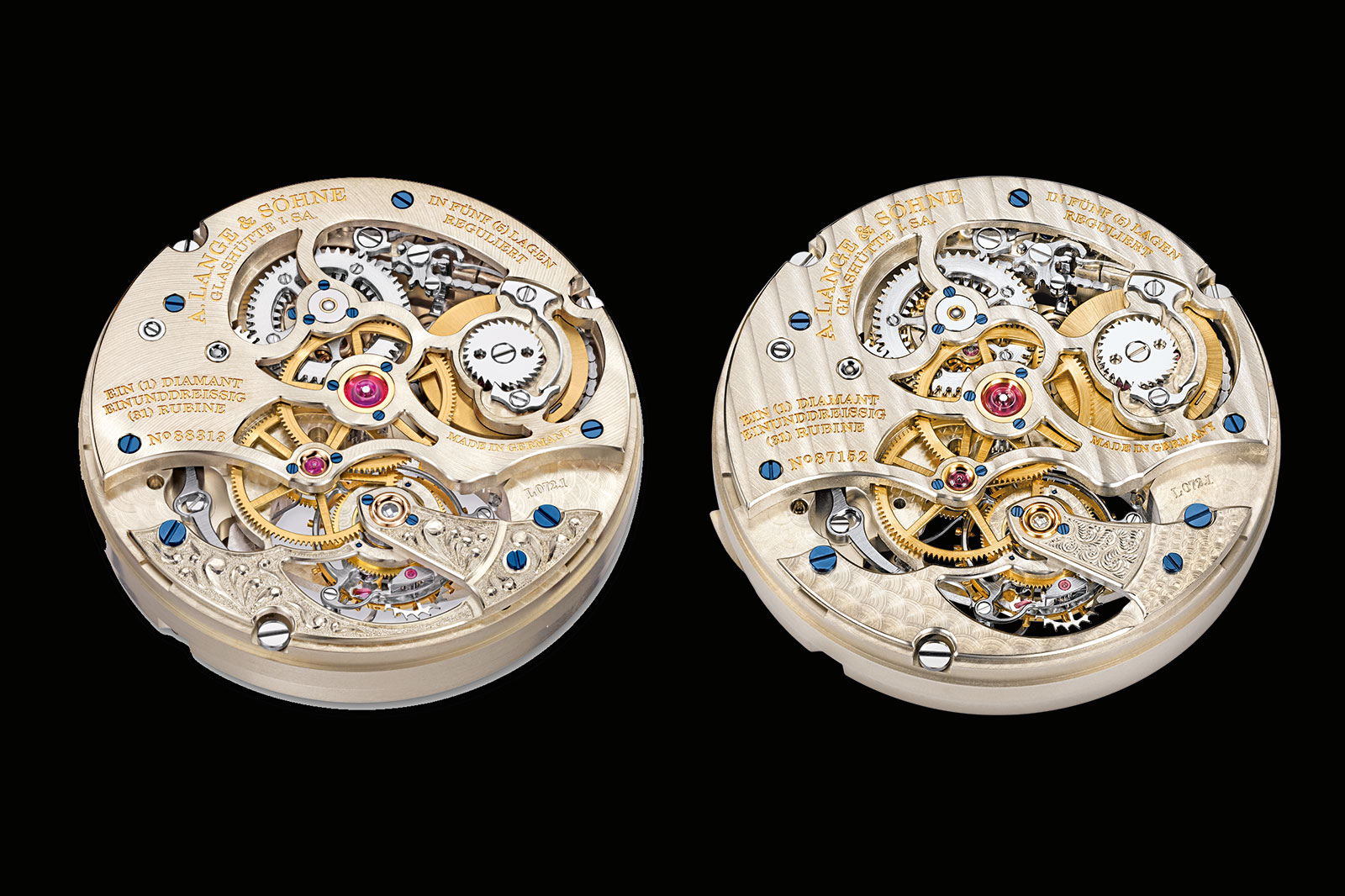
The Handwerkskunst movement (left), and the standard L072.1. Photo – A. Lange & Söhne
In addition to the decoration on the standard version, the fourth-wheel bridge and the entirety of the tourbillon cock relief engraved on the Handwerkskunst. At the same time, the three-quarter plate is finished with a spiral graining known as solarisation, which replaces the standard striping – and that’s it. You might ask, what more do you want?
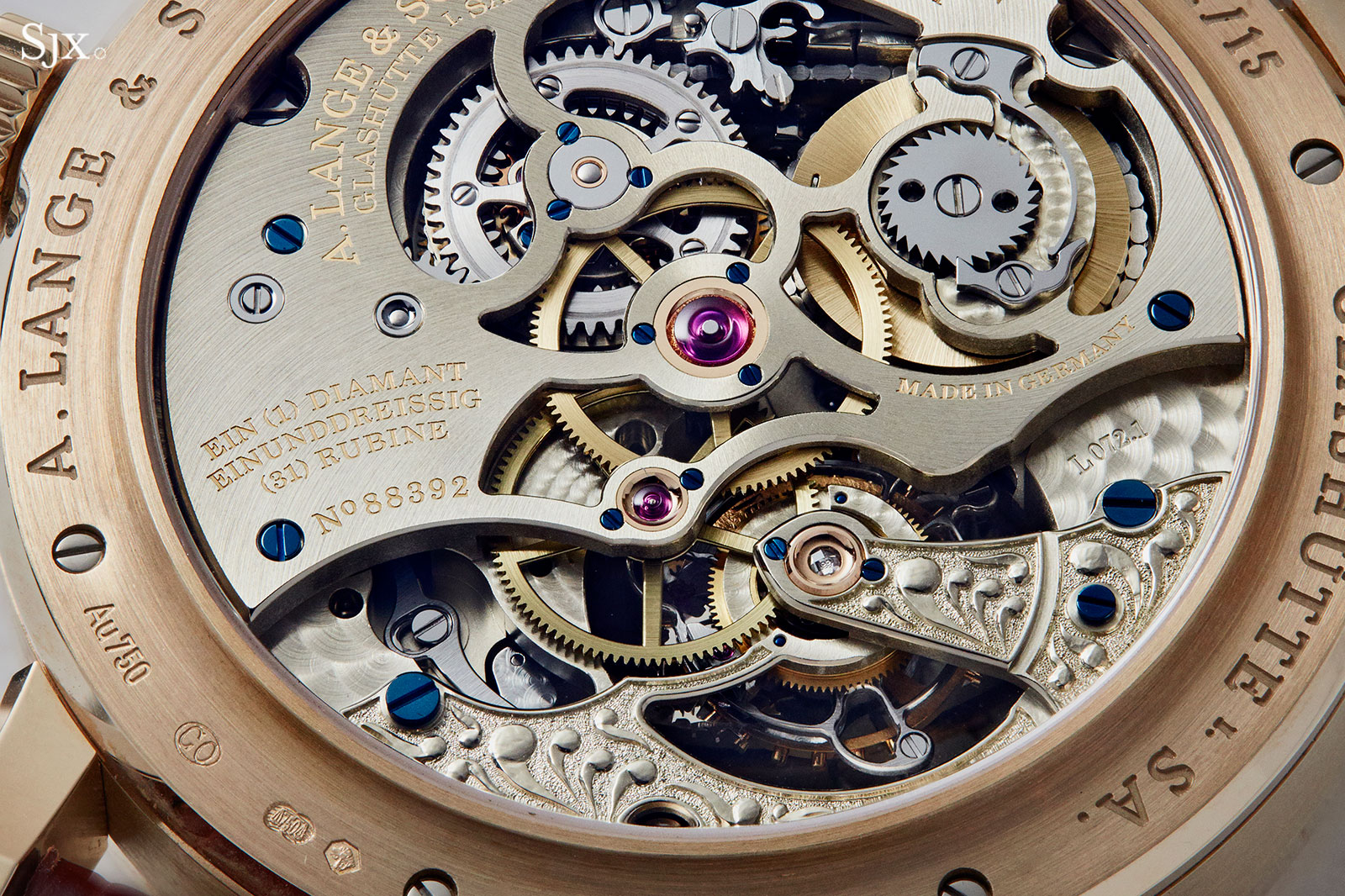
A splendid movement that gives great joy, yet saddens due to unrealised potential – almost all the bevel corners of the main plate are rounded
As seen above; a common critique of the awesome L072.1 was the lack of inward corners on the bevelled edges of the three-quarter plate, a detail that requires a process that requires handwork with special tools rather than hand-operated machines. To an extent, it is understandable that Lange did not implement such decoration on the standard version, but why the Handwerkskunst version also suffers from the same shortcoming is baffling.
Interestingly in later Handwerkskunst models, such as the Lange 1 Tourbillon, such shortcomings were corrected, and the movements thoroughly differ from the standard versions.
The Market
The price of the Handwerkskunst edition was US$244,000, while the standard version in platinum was US$233,600 in 2011.
To date, the Richard Lange Tourbillon Pour le Mérite Handwerkskunst has appeared at auctions six times; four at Sotheby’s, and the balance at Christie’s. Note that one example, No. 02/15 was offered twice, first in 2015 where it did not sell, and then again in 2018 when it did.
Generally, the realised prices have been below, but quite close to, the original retail price. I believe it has performed quite well on the secondary market because the standard model is utterly plain, but the Handwerkskunst edition has so much going on, making it truly special.
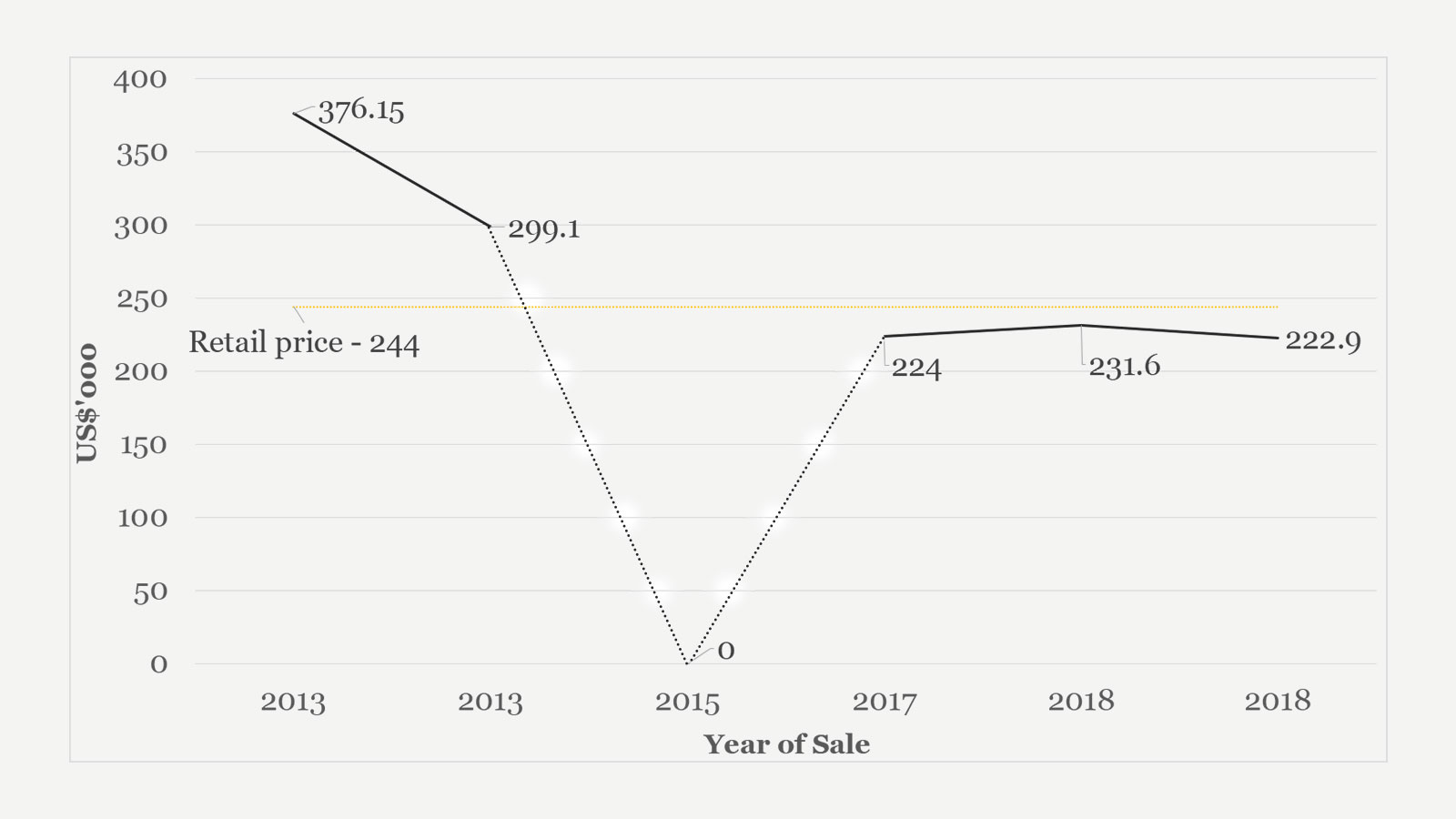
Realised prices at auction, inclusive of buyer’s premium
2012 – Zeitwerk Handwerkskunst (ref. 140.048)
Zeitwerk – the first idea for a digital display dates back to Blümlein – is quite possibly the most ground-breaking design that came from a big, established brand in recent decades. Revolutionary – and controversial – when it was launched in 2009, the Zeitwerk took time to be accepted, and today it is the icon of the brand for many collectors. Its technical complexity, mechanical architecture, as well as contemporary design with traditional roots, certainly deserves such acclaim.
The Zeitwerk is so special that the mode line has its own department in the manufacture. Every Zeitwerk is crafted and serviced there, and only there, by the expert team of 20 people, with each watchmaker being responsible for one watch from start to finish.
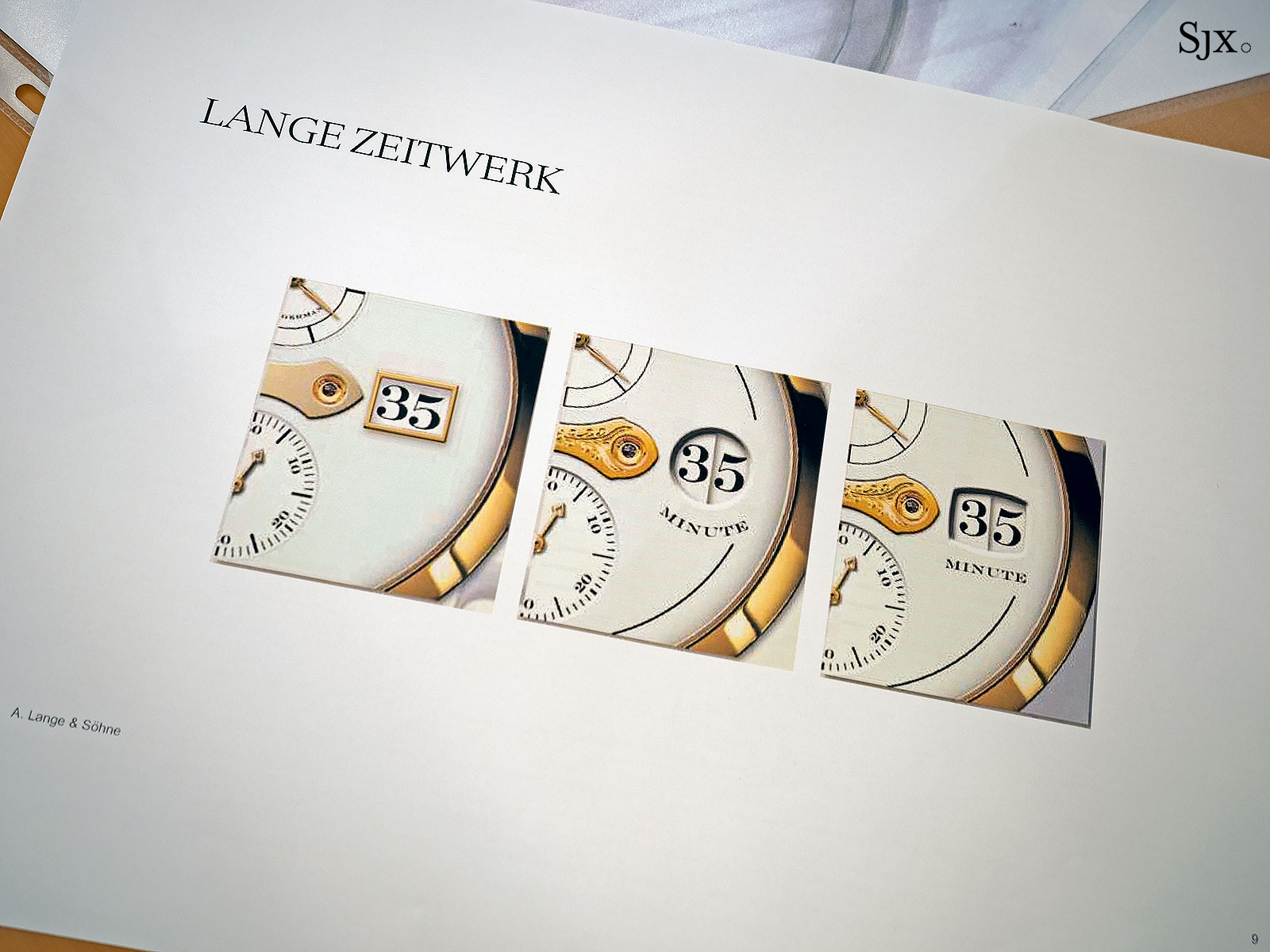
Early designs for the Zeitwerk
Following the launch in 2009, Lange did not hold back and swiftly expanded the family with the Zeitwerk Luminous Phantom (ref. 140.035) a year later, and the Zeitwerk Striking Time in 2011. With the Zeitwerk’s success firmly established, the logical decision was made to keep the ball rolling, and in 2012 the baroque Handwerkskunst version arrived.
The dial
The main dial is made of black-rhodium plated white gold and finished with tremblage engraving – the execution is astonishing. It is no wonder each dial took over two weeks to finish, as only the most experienced engravers could perfect the dial.
This is another example where the decorative technique was chosen for aesthetic cohesiveness. Tremblage applied to black-rhodium coated gold goes hand-in-hand with the Zeitwerk’s contemporary look as well as the updated movement decoration for the Handwerkskunst.
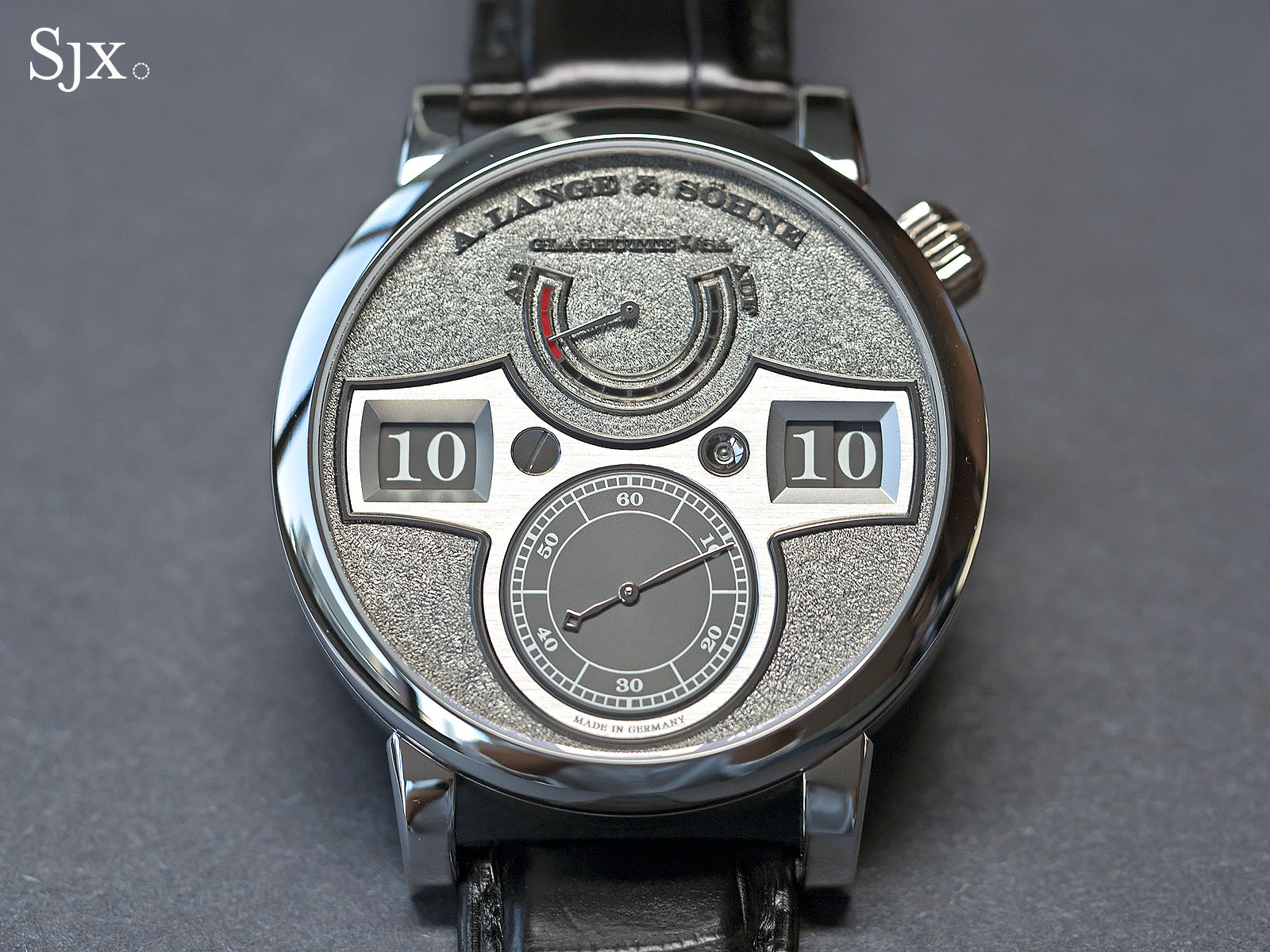
Traditional in craft, contemporary in design, perfection in execution
The wing-shaped time display bridge is made of German silver and its purity creates a great harmony with the complex engraving. Its geometric shape makes the watch less ornate and masterfully preserves the modern look of the Zeitwerk.
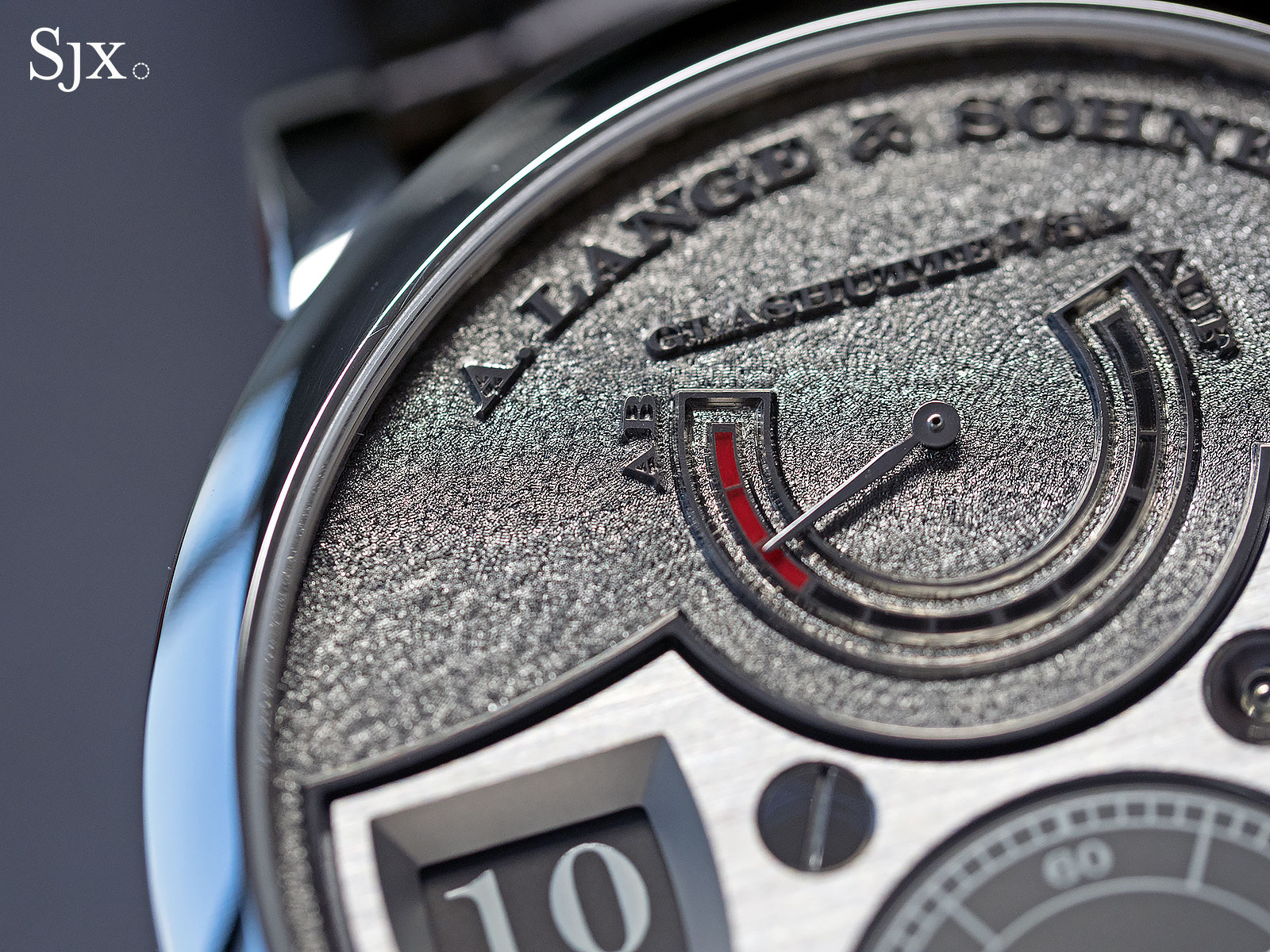
Finished with tremblage engraving, the dial has its logo and lettering in high relief
The L043.4
With Zeitwerk Handwerkskunst, the brand stepped up its decoration game. What makes this edition even more special is the technical update the movement received, a tiny but important detail that pretty much sums up why I love Lange; more on that later.
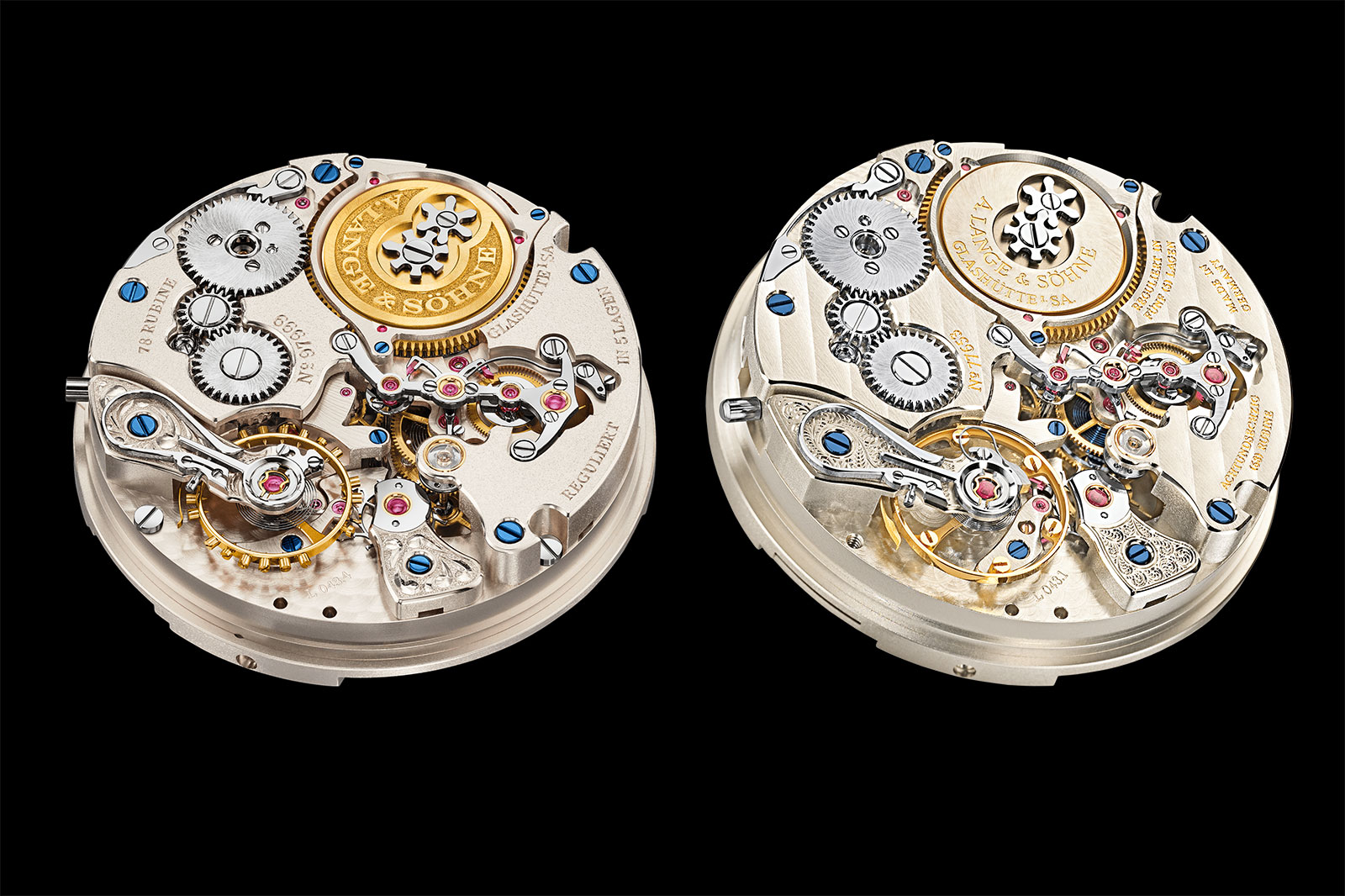
The L043.4 of the Zeitwerk Handwerkskunst (left), and the standard L043.1. Photo – A. Lange & Söhne
The three-quarter plate is endowed with a granular surface and hand-engraved lettering, while the brand signature on the mainspring barrel is relief engraved, which requires the engraver to chisel the motif out of the material, resulting in letters that appear embossed. It is a gorgeous sight.
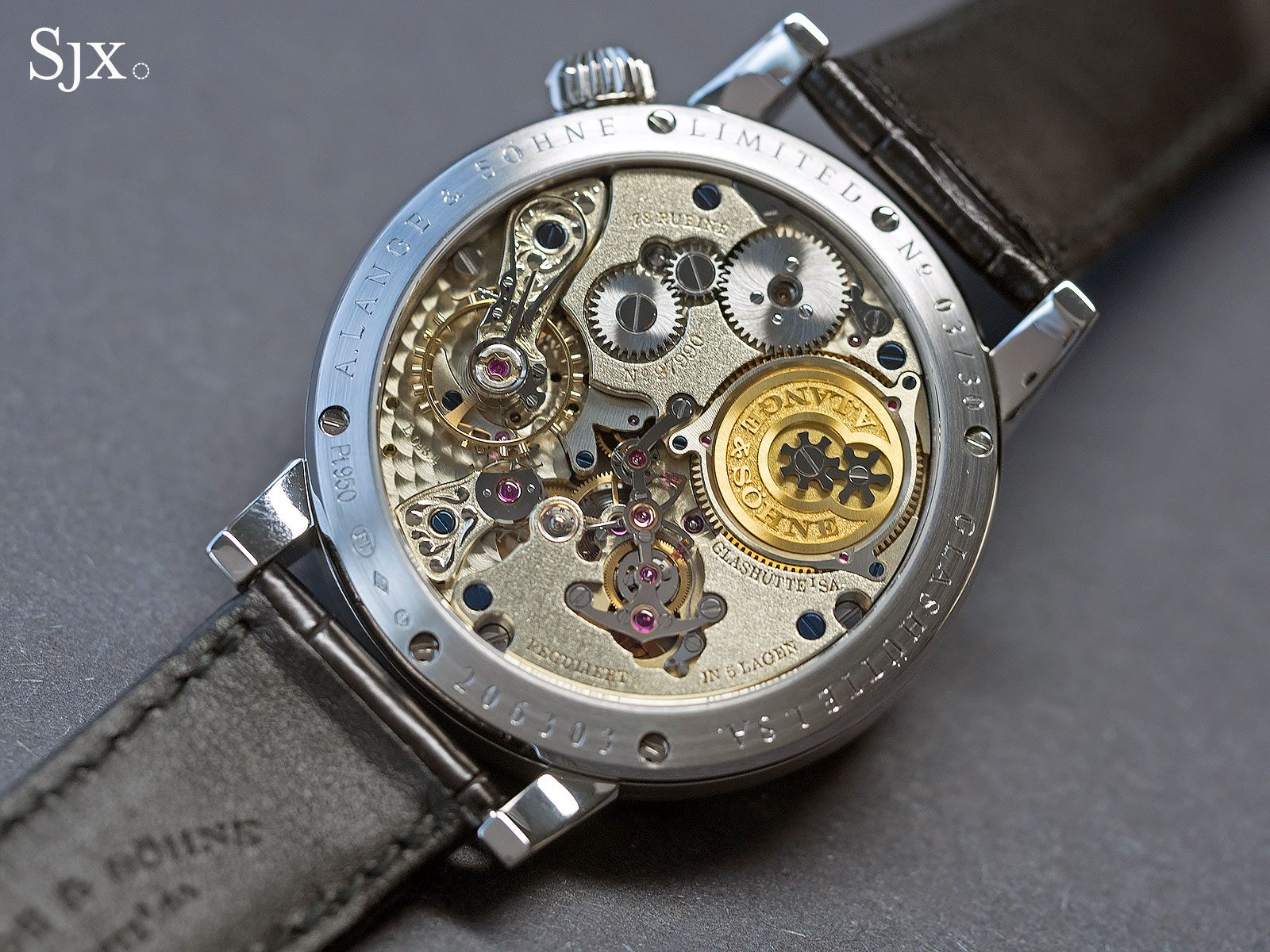
Note the frosted three-quarter plate, as well as the sloped case-back ring instead of regular two-step back
The standard Zeitwerk movement is L043.1. Deciphering the numbers is easy. The first two digits refer to the year the movement was conceived, 2004, and the third number denotes the order in which it was conceived that year, making this the third movement of 2004. And the last digit refers to the iteration of the movement, hence “1” for the original Zeitwerk movement. But the Zeitwerk Handwerkskunst movement is L043.4, meaning it is an entirely new variant of the movement – and the reason lies in the escapement.
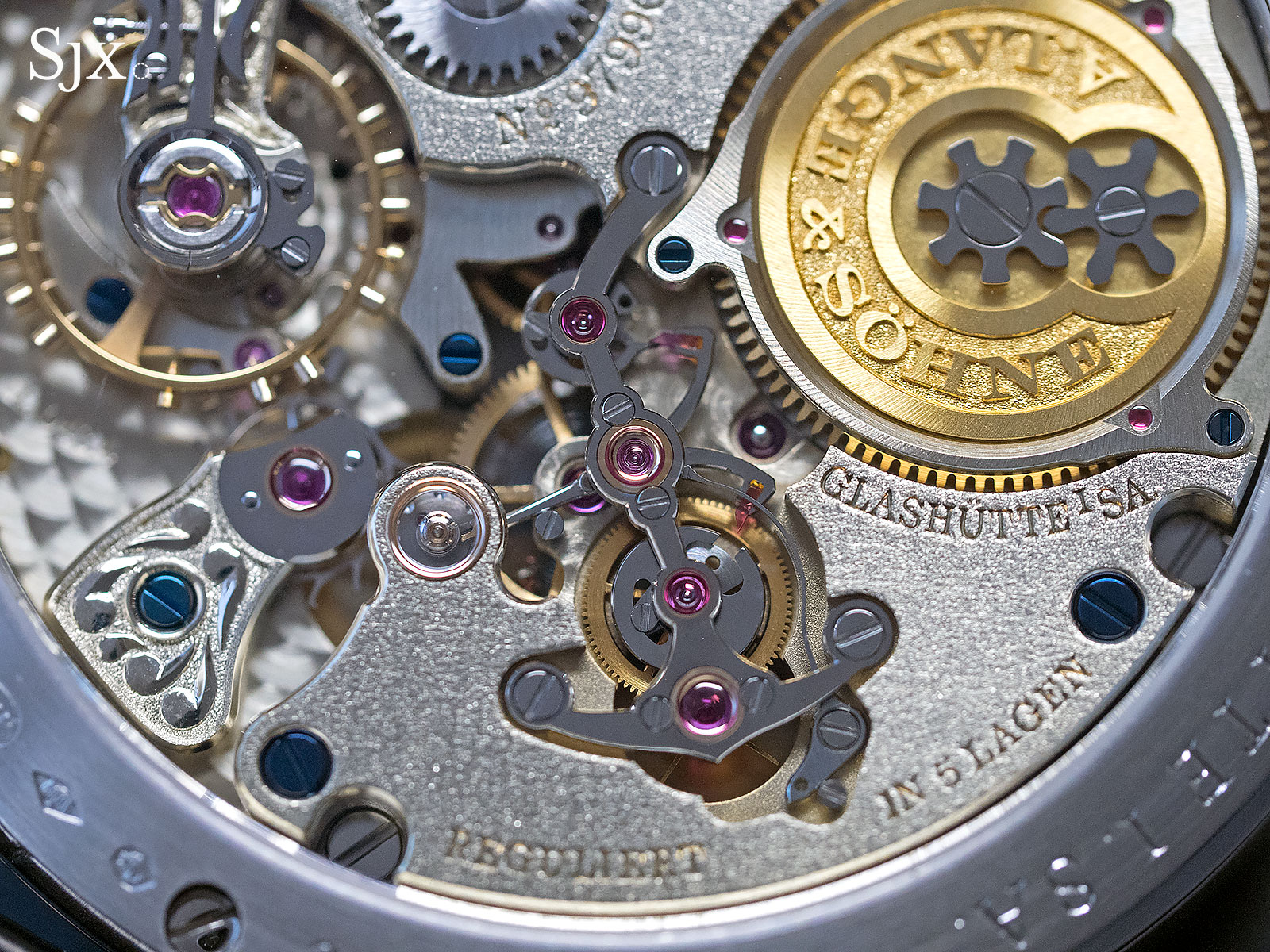
The infamous, black-polished remontoir bridge alongside the superb hand engraving
Both the escape wheel and pallet lever in the L043.4 are forged from solid gold via a hammering process to increase their surface hardness. But more importantly, they are not conventional escapement parts, instead the L043.4 is equipped with the Glashütte lever escapement, which was invented by Ferdinand-Adolph Lange in the mid-19thcentury.
How the Glashütte lever escapement ended up in the movement of a 21st century limited edition is a story in itself. Due to the decline of high-end watchmaking in Glashütte after the second world war, there are few people left who know how to produce the Glashütte pallet lever.
But because the product development department was determined to integrate this historic element into the already-amazing timepiece, the persistent people of Lange finally found a 92-year-old lady who taught them how to make it on a lathe. Then they trained the watchmaker who was set to assemble the Zeitwerk Handwerkskunst, who spent days making the first example of the Glashütte pallet lever. It took him months to finish 30 perfect Glashütte pallet levers.
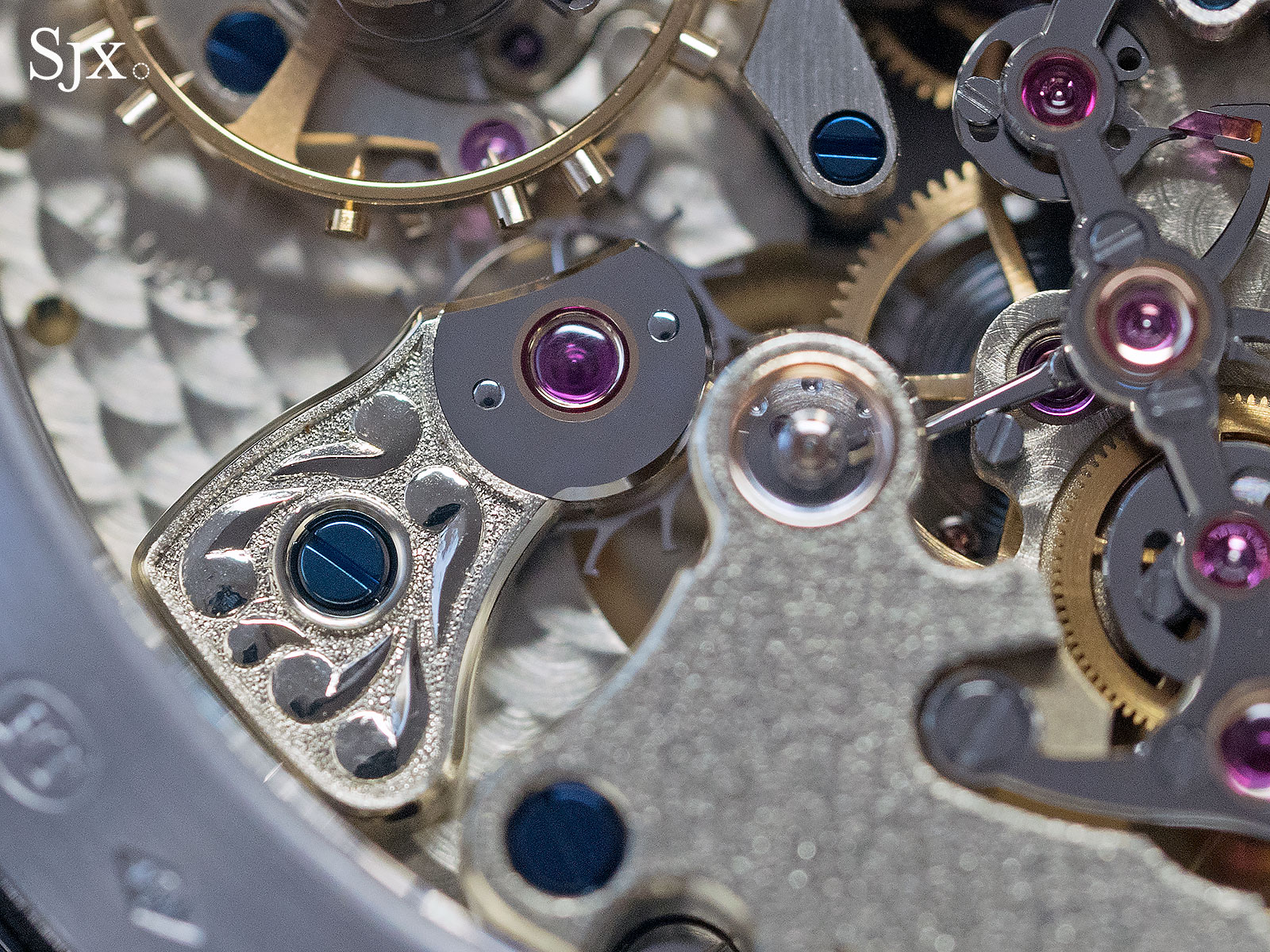
Note the balance with regulating screws instead of the standard adjustable weights, and the gorgeous relief-engraving on the escape-wheel cock
The reason for the tedious production lies in the complexity of its construction. The Glashütte lever escapement has several key differences with the conventional Swiss lever escapement.
In the Swiss lever escapement, the pallet jewels are secured to the pallet fork with shellac, while the Glashütte pallet lever holds the pallet jewels in something akin to a three-sided cup.
Also, the German invention has pallet jewels that are almost cylindrical and feature curved faces, with the protruding curved surfaces being the only part of the jewels visible from above. The advantage of the Glashütte lever lies in superior energy transmission and less surface wear over time, as the curved pallet jewels counteract the risk of deformation and increase the lift of the escapement.
The major problem with the Glashütte lever is it cannot be adjusted once assembled. So the lever has to be removed for regulation, which requires time and great skill. The complexity of the process is why the Swiss lever escapement, which is far easier to adjust, is the default in the standard Zeitwerk movement.
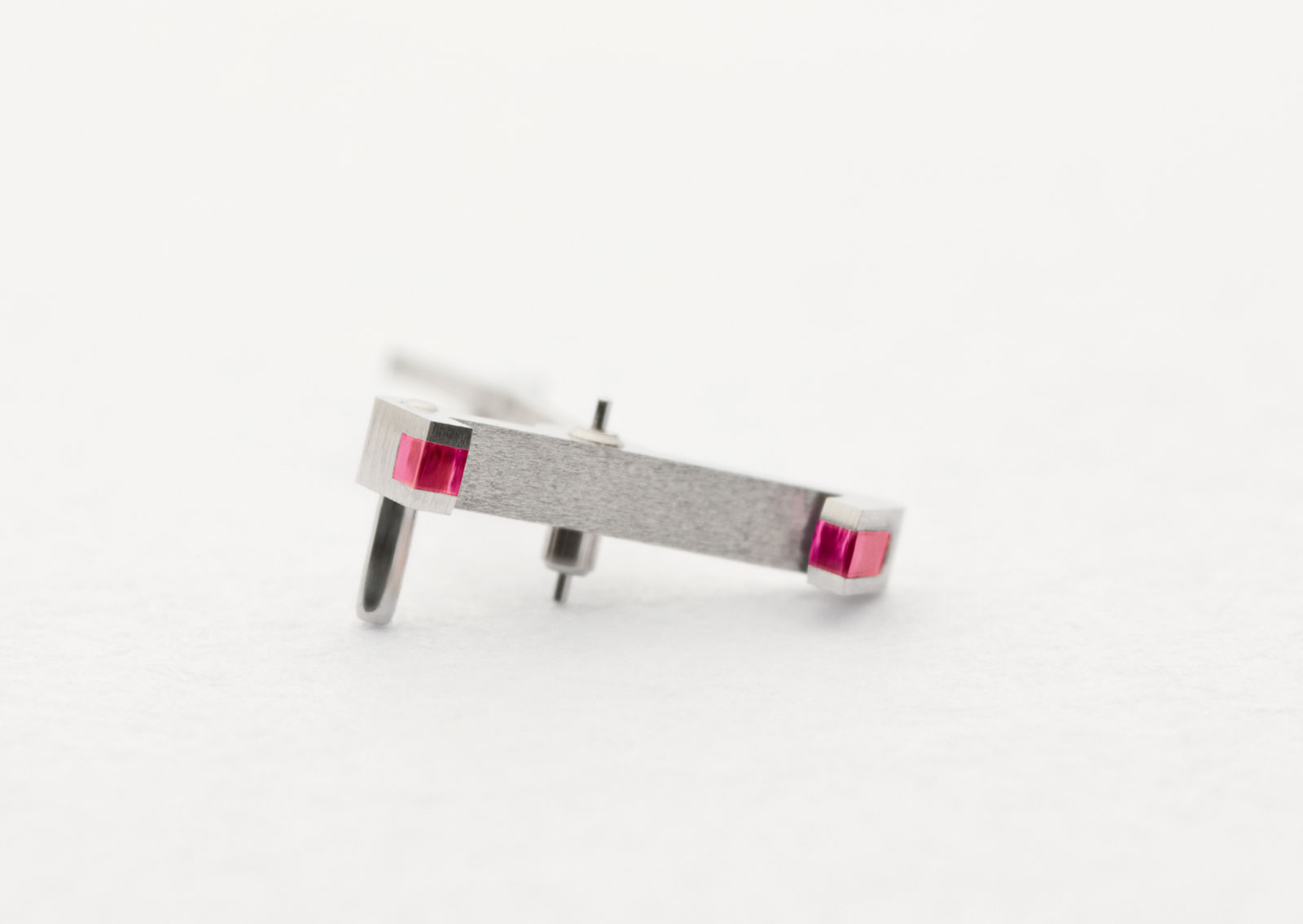
The Glashütte lever has short pallet jewels fully integrated into the pallet lever. Photo – A. Lange & Söhne
Due to drastic differences in the assembly, oiling, and regulation of the L043.4 as compared to the standard movement, only two watchmakers in the Zeitwerk department have the training to service the Zeitwerk Handwerkskunst.
As Robert Hoffmann, head of the Zeitwerk department, once told me, whenever one of the Handwerkskunst editions returns for servicing, everyone leaves their workbench and rushes over to the service bench to admire this stunning piece of art.
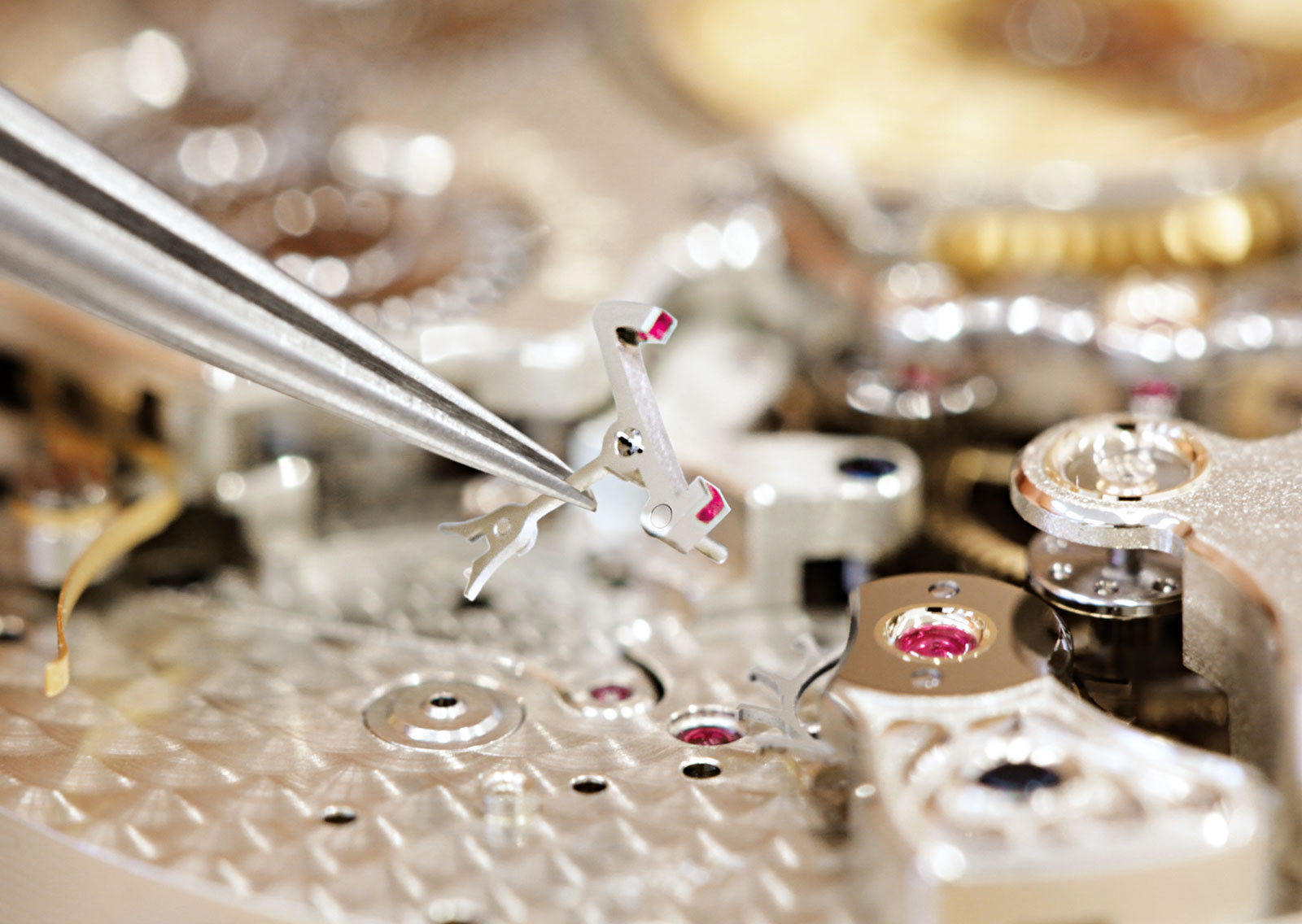
Installing the Glashütte lever. Photo – A. Lange & Söhne
Such stories about the tiniest yet all-important detail are what make watches more than just an agglomeration of metal. Watchmaking, above all, is emotional and collecting is about the feelings the watches evoke. Stories where manufactures connect with their past in a purposeful way delivers something more valuable than the material itself. They give historical context to the joy of the ownership and Zeitwerk Handwerkskunst perfectly illustrates this.
The market
The Zeitwerk Handwerkskunst has gone under the hammer eight times between 2015 and 2019. It is the most accessible Handwerkskunst edition in terms of availability, as one or two seem to be offered for sale every year, either at auctions or private dealers.
When launched, the Zeitwerk Handwerkskunst was priced at a sizeable premium compared to the standard platinum version – US$110,00 against US$83,200. But the watch has consistently sold for more than the original retail price, occasionally selling for a hefty chunk over retail, with a peak price of over double retail, US$241,000, in 2015.
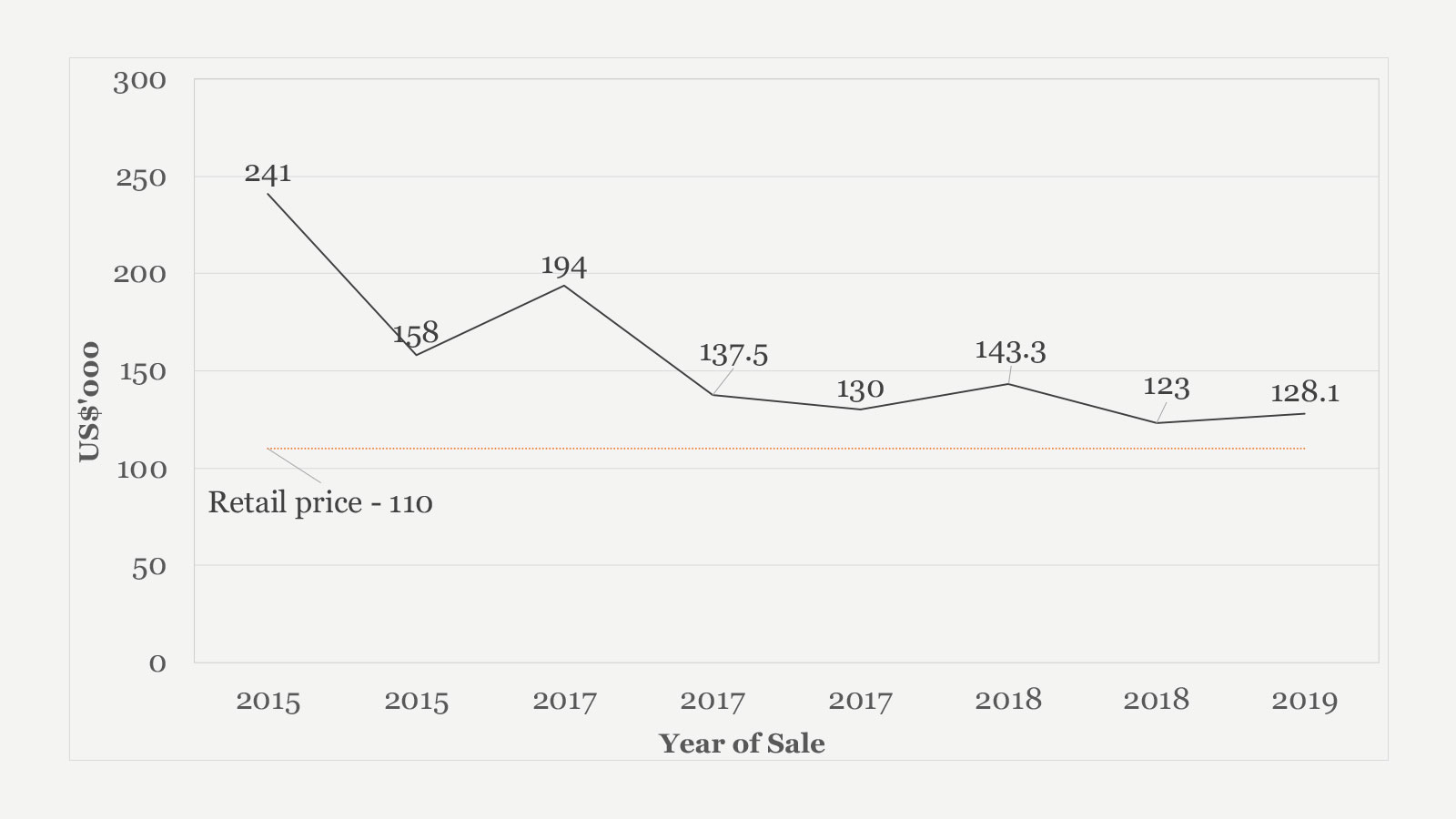
Realised prices at auction, inclusive of buyer’s premium
The Zeitwerk’s desirability is down to two reasons. One is the fact that the Zeitwerk in general is famous – it is an iconic Lange model – and widely liked, even in its standard versions. And it is also the most affordable Handwerkskunst model to date. So even when it sells for more than its original retail price, the Zeitwerk Handwerkskunst is still within reach for more collectors, as compared to the more complicated and expensive models.
2013 – Lange 1 Tourbillon Perpetual Calendar Handwerkskunst (ref. 140.048)
The Lange 1 Tourbillon Perpetual Calendar was introduced in 2012 in platinum as a limited run of 100 pieces. The very definition of stealth, the watch packs exceptional complexity beneath the subtle appearance.
The idea of incorporating a perpetual calendar in the Lange 1 once again originates with Günter Blümlein. But after several attempts, it was found to be impossible to implement a calendar display without disrupting the meticulously-arranged dial of the Lange 1. Yet, as it is the very nature of Lange, the product development team pressed on and tried to achieve what was deemed impossible. After years of development, Mr de Haas and his team accomplished the marvellous.
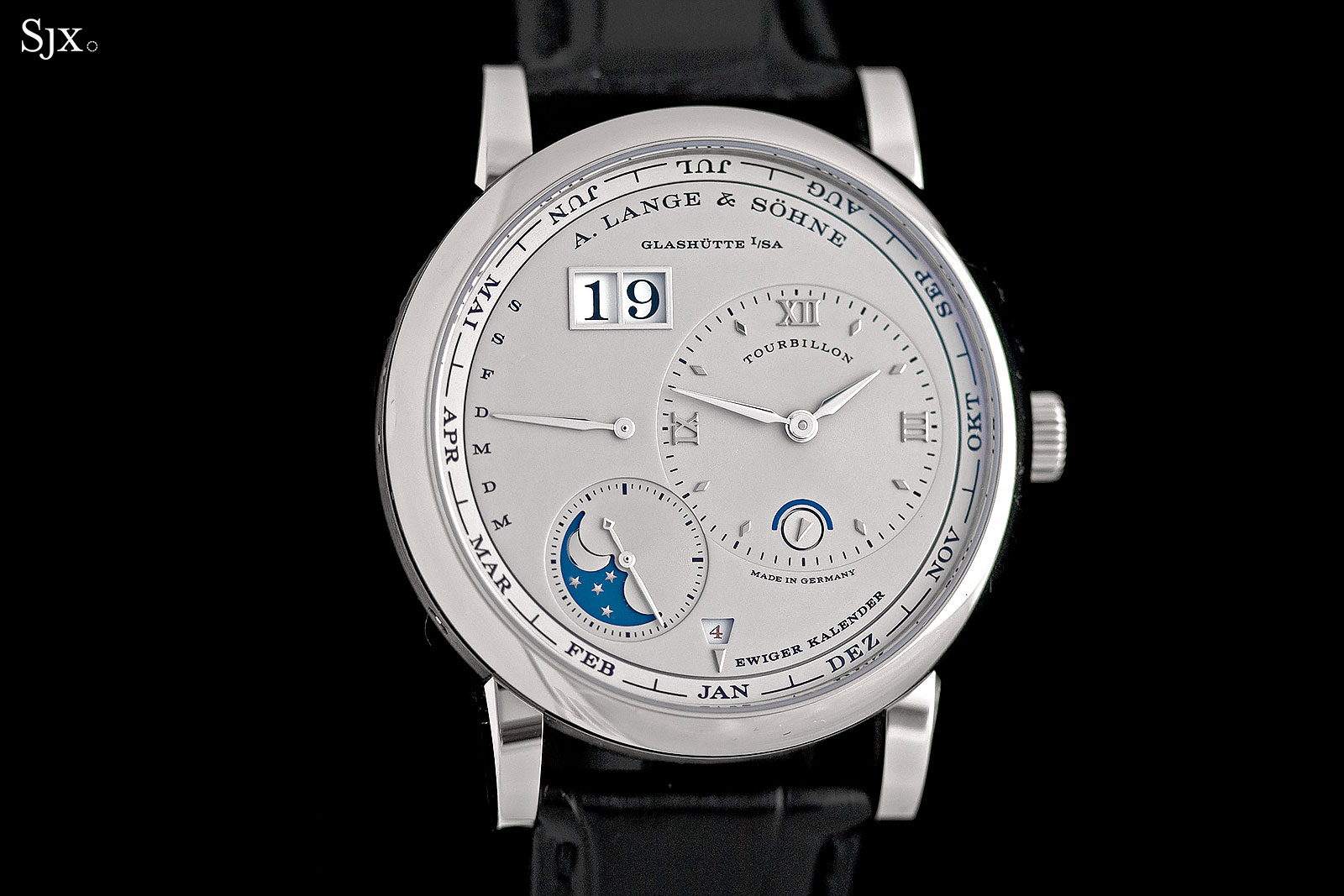
One of the ultimate stealth complications in its original guise
If you ever have the chance to ask Mr de Haas which watch he is proudest of, he is probably going to reply: the Lange 1 Tourbillon Perpetual Calendar, because even Günter Blümlein and his team could not find a way to do it. But note that I did not ask him this question after the launch of the Odysseus.
And then in 2013, the Lange 1 Tourbillon Perpetual Calendar Handwerkskunst was introduced during Watches & Wonders in Hong Kong. Limited with 15 pieces, it was quite possibly the most baroque of the series, yet no less charming than its simpler siblings.
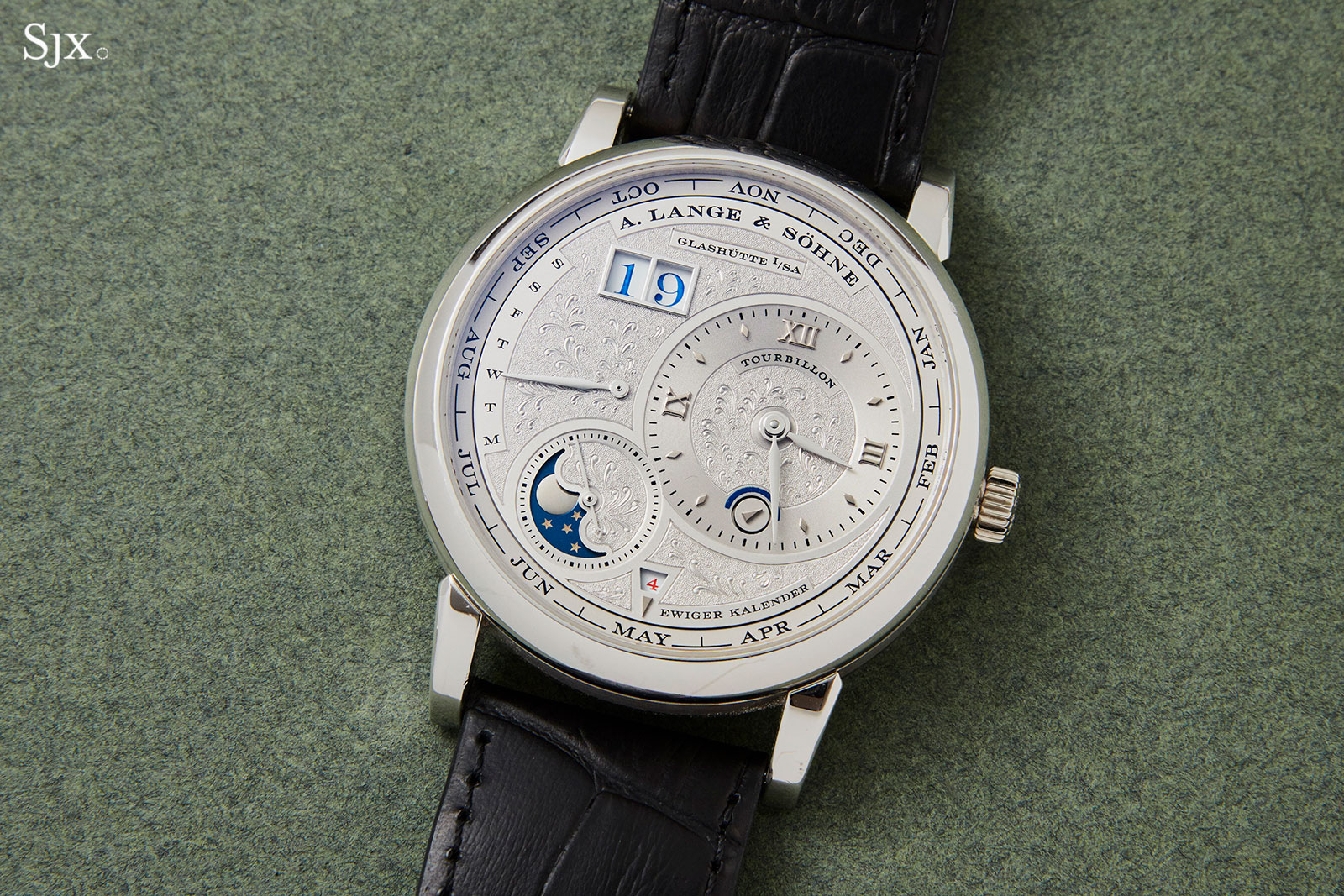
The dial
Made of solid white gold, the dial is decorated with a combination of tremblage and relief engraving. It’s made up of a relief-engraved floral pattern, echoing the motif found on the balance cock of every Lange movement, against the granular background.
Moreover, the numerals of the outsized date are hand-painted, and the tell-tale signs of hand painting are apparent. As with the engraved balance cock on each Lange movement that’s the signature of the engraver, the addition of calligraphy is well suited to a Handwerkskunst edition.
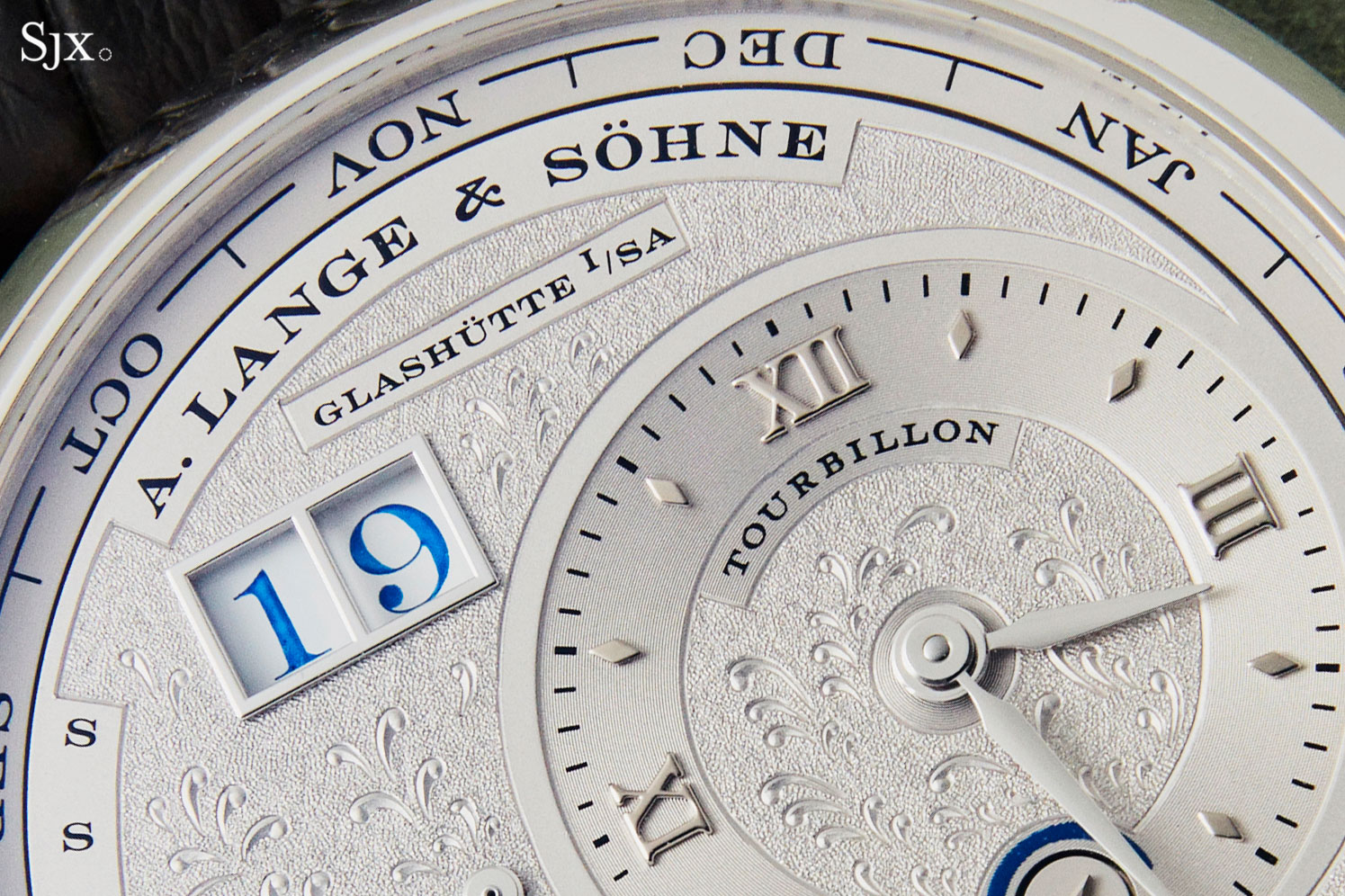
The dial is decorated with both relief- and tremblage engraving, while the numerals of the big date are hand painted
The patience and amount of time required to decorate the dial alone is more than it takes to put together some other complicated watches from start to finish. Although the ostentatious look might be unattractive to some, the handwerks goes into each one of these dials deserves a round of applause.
And as a side note to potential owners of the watch: when the prototype was first unveiled in 2015, it had deep relief engraving on the dial. However, the engraving was less pronounced on the production models, a change made for aesthetic reasons, making it helpful to look at photos of production examples rather than the prototype. Also, as Mr De Haas often points out, each engraver has an individual style, making each dial different.
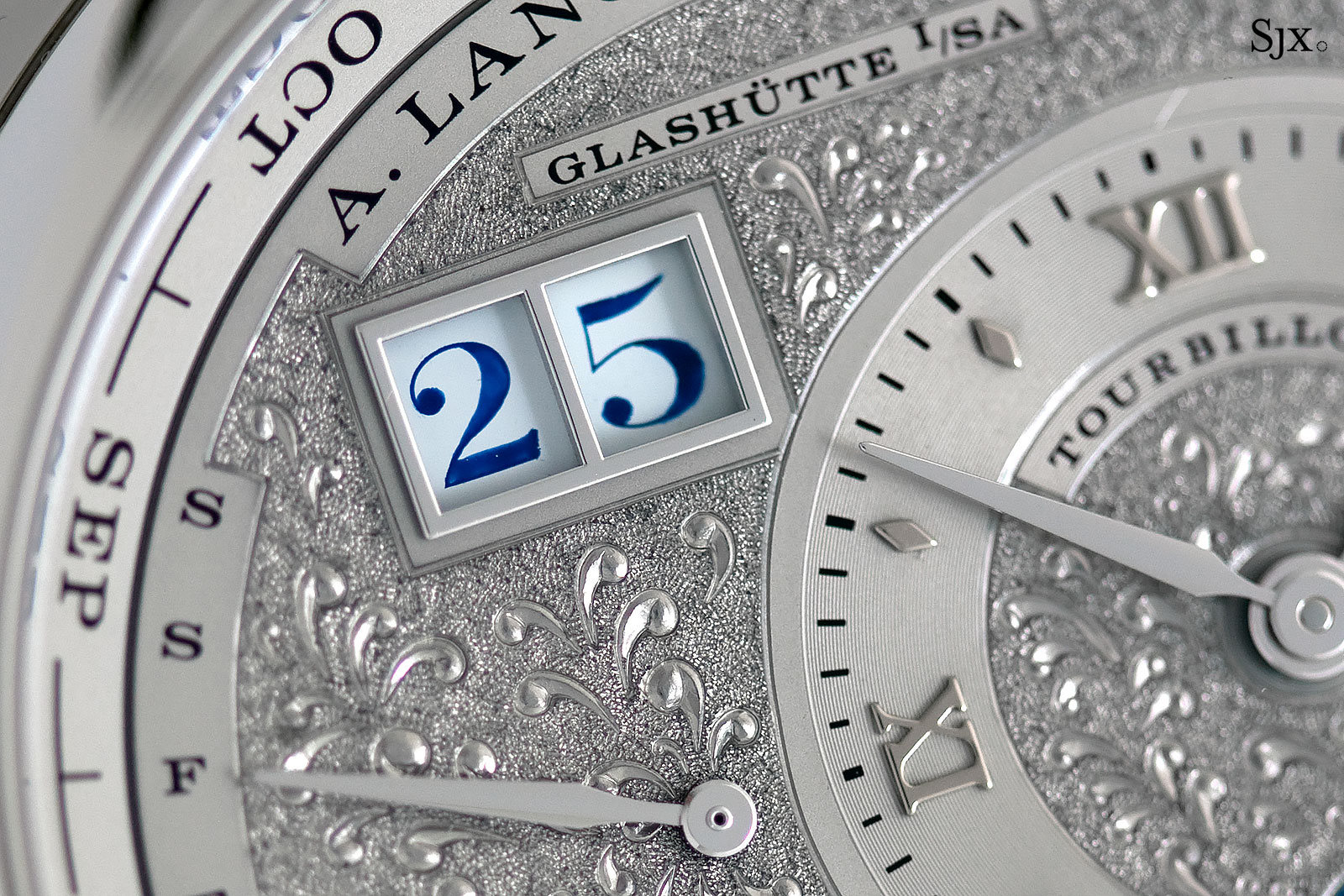
The dial of the prototype with its more pronounced engraving that is larger and deeper
The L082.1
The L082.1 movement is what makes Lange 1 Tourbillon Perpetual Calendar more expensive than a powerhouse like the Datograph Perpetual Tourbillon. For one, the movement was built as an integrated perpetual calendar rather than relying on the classic, but simpler, modular construction. This was done due to unusual and patented arrangement of the calendar displays, which were a necessity so as to preserve the Lange 1’s dial proportions.
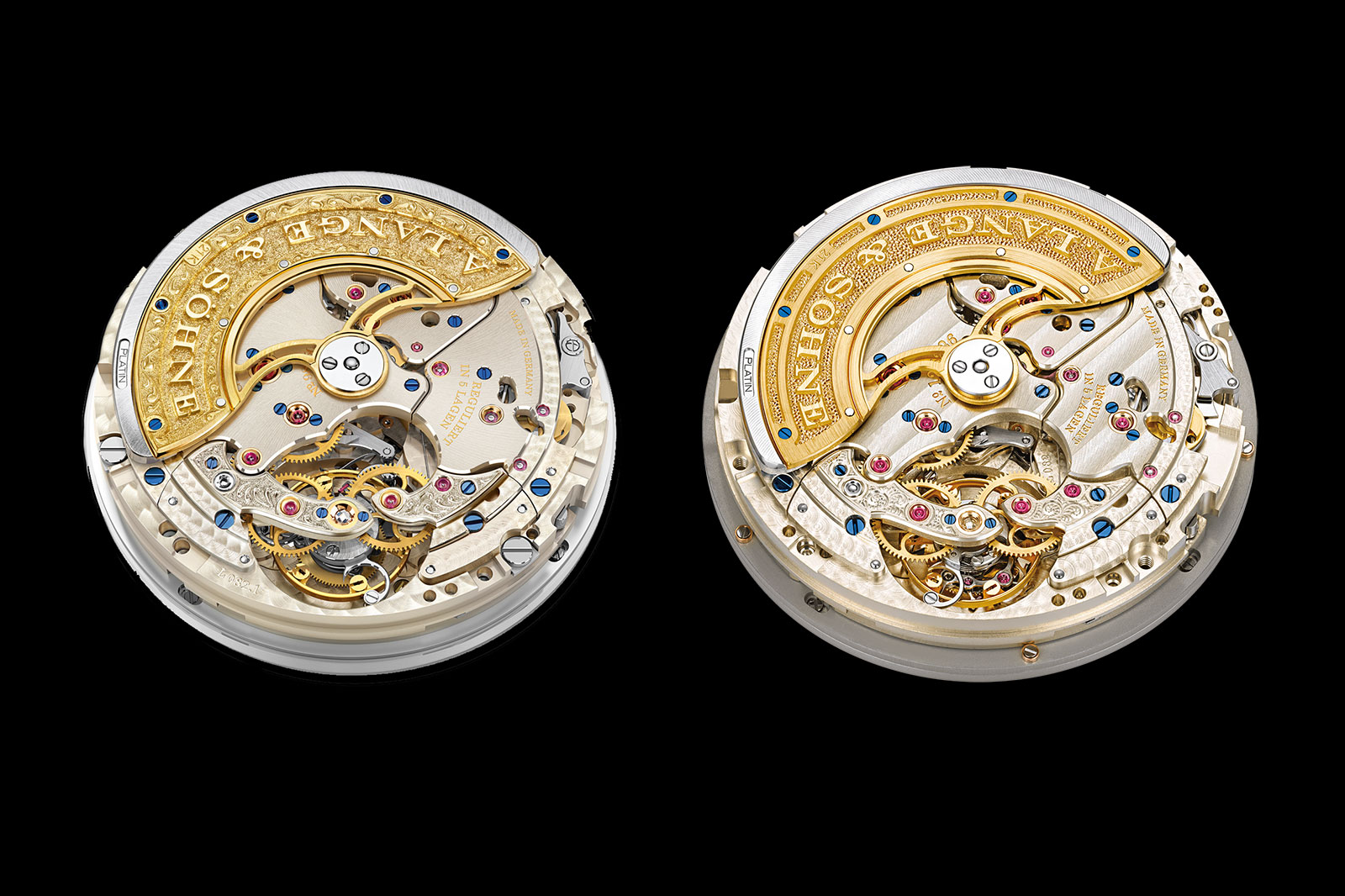
The Handwerkskunst version (left), and the standard L082.1. Photo – A. Lange & Söhne
On the Handwerkskunst version, the solid gold rotor as well as the tourbillon and the fourth wheel cocks are relief engraved. Additionally, the three-quarter plate is solarised instead of striped. Apart from these two elements, there is no other visual differences between this and the movement in the standard model.
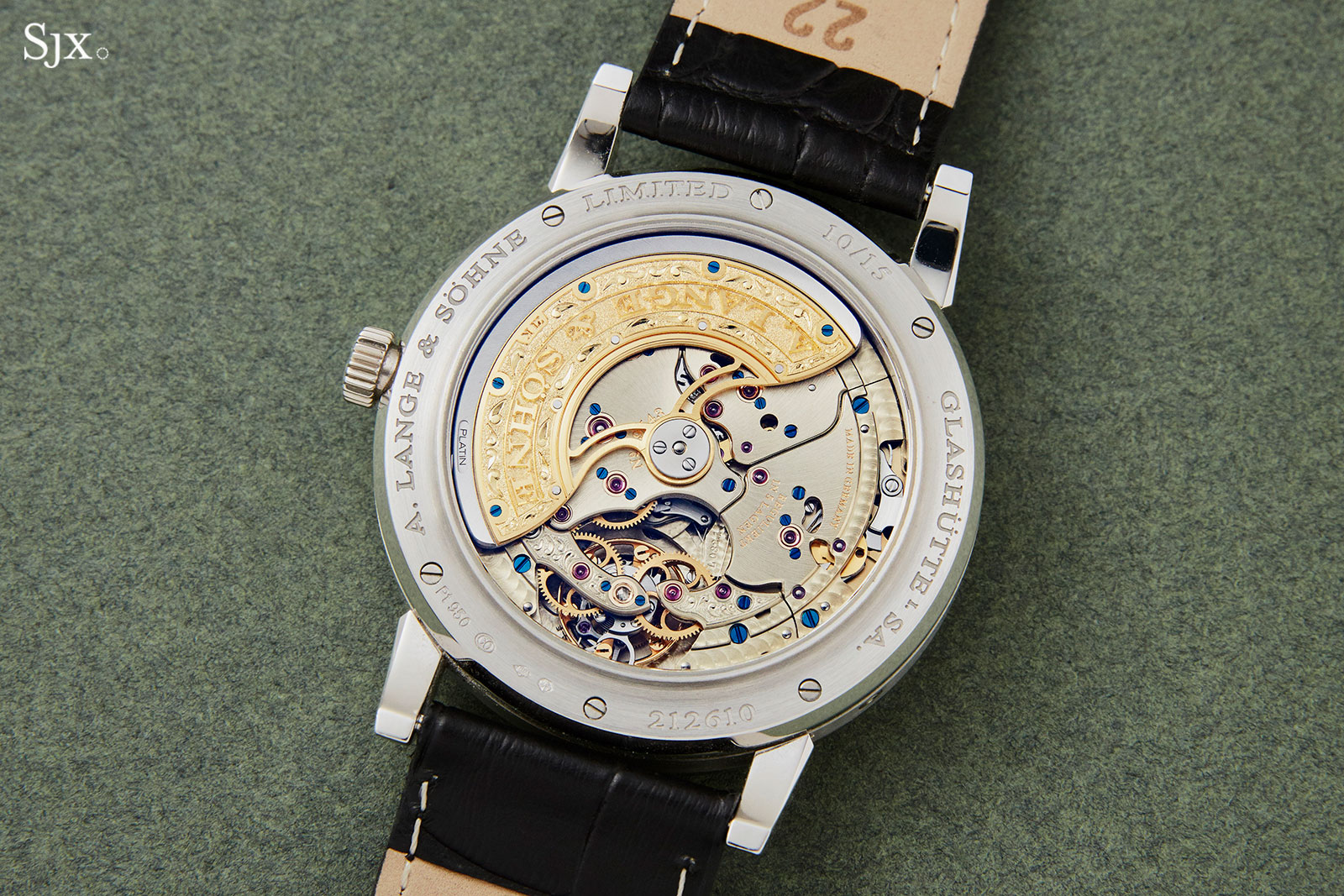
The L082.1 of the Lange 1 Tourbillon Perpetual Calendar Handwerkskunst
The tourbillon sits at the six o’clock and is finished to perfection. As a technical complement to its beauty, the tourbillon is also endowed with Lange’s patented hacking mechanism. But despite all of that finery, one question has been lingering amongst collectors since it was launched: why install a tourbillon that is hardly visible, but at the same time makes the watch so incredibly expensive?
You can see more detailed explanation of the caliber L082.1 on SJX’s article, here.
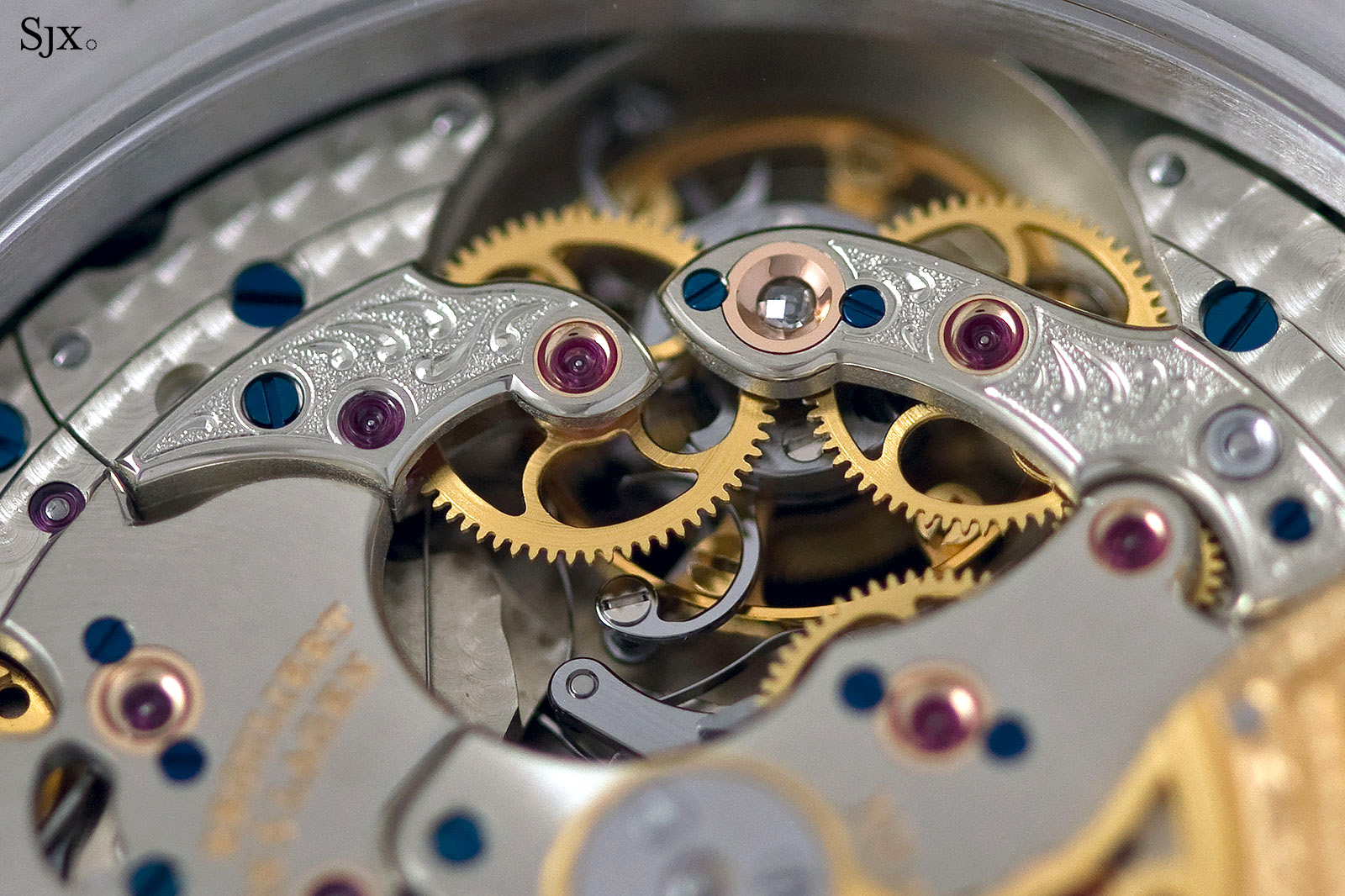
Brilliantly decorated, with a hidden tourbillon
The market
The Lange 1 Perpetual Calendar Tourbillon Handwerkskunst had a launch price of US$357,000, which was about 10% more than the limited-edition platinum version.
The model has surfaced twice at auction. First no. 10/15 sold at Dr Crott in 2016 for US$321,000, and then no. 09/15 sold at Sotheby’s in 2018 for a steep discount to retail, with an all-in price of US$191,200.
The weakness of the Handwerkskunst model at auction can be understood by looking at the appeal of the standard model. The Lange 1 Tourbillon Perpetual Calendar in general gets neither the recognition nor the acclaim it deserves, which is necessary to protect its value in the secondary market. At the same time, producing a relatively high number of them, with a total in the low hundreds, could also add to its woes.
At the same time, I would argue the Handwerkskunst edition is too baroque, and the decoration – even though it is incredibly fine in execution – does not distinguish the watch enough visually to make it more appealing than the original version.
2014 – Lange 1 Tourbillon Handwerkskunst (ref. 704.048)
The origins of the Lange 1 Tourbillon lie, once again, with Günter Blumlein. An anecdote about its birth comes from my friend, the collector who goes by the handle L951.1 on Instagram.
According to him, when Günter Blümlein came up with the idea of including a tourbillon in the Lange 1, Reinhard Meis, then Lange’s chief designer, objected because the basic principle of the Lange 1 was not to mix any of the indications. Eventually, Blümlein handed Mr Meis an ultimatum: either do it or you’re fired.

Günter Blümlein (left) and Walter Lange, with the Ferdinand Adolph Lange memorial behind them. Photo – A. Lange & Söhne
Mr Meis did it, and six years after Lange was re-established in 1994, the brand debuted its second tourbillon model at the turn of the millennium.
Neither the timing nor the complication was a coincidence – the watch harked back to one of the most important Lange pocket watches of all the time, the Jahrhunderttourbillon no. 41000, or Centennial Tourbillon, which was lavishly decorated in enamel and engraving. Once owned by Germany’s richest man, the watch set a record that still stands for the most expensive German watch ever sold at auction after it sold for 1.5 million Deutsche marks in 1992.
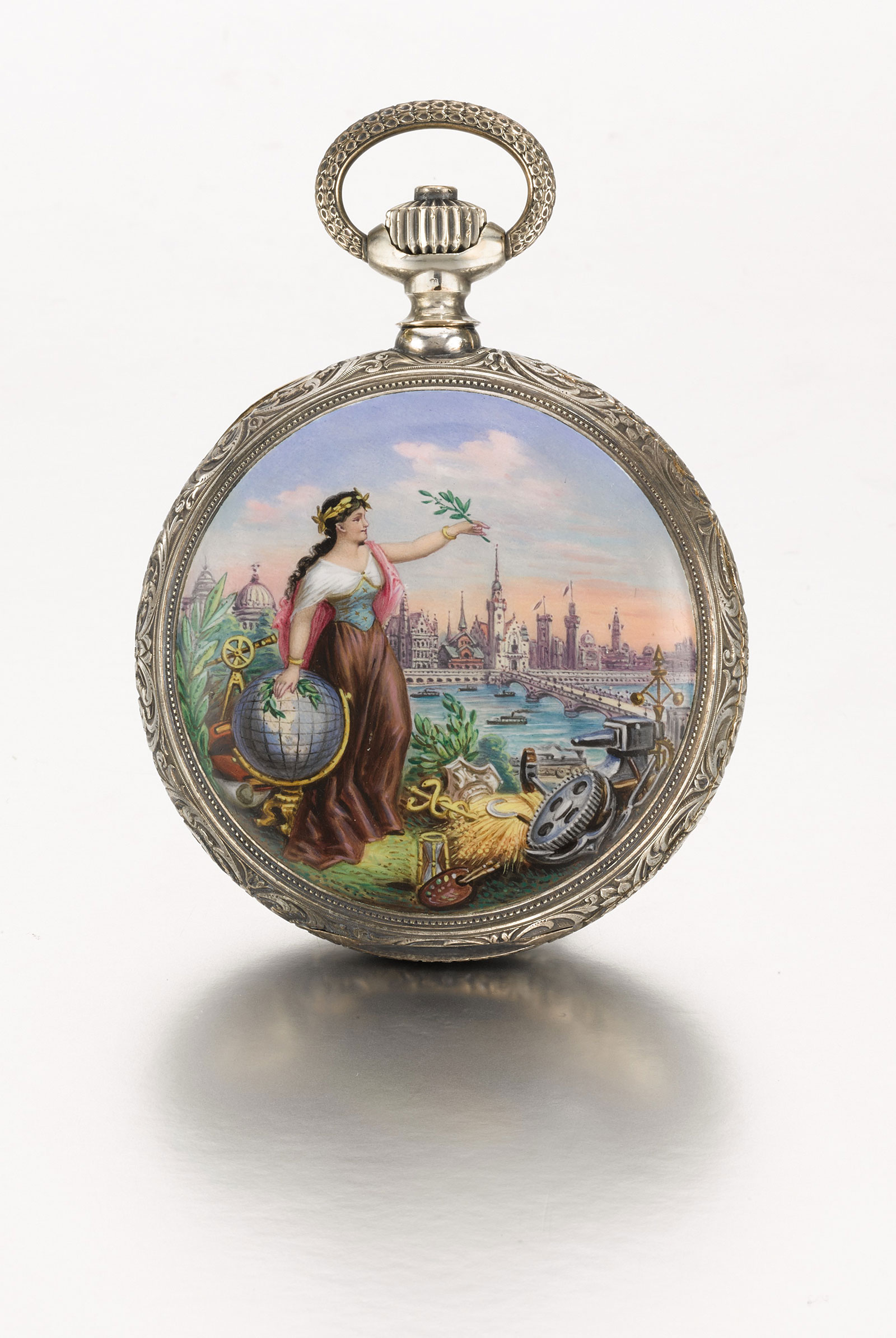
The spectacular no. 41000 pocket watch was sold at Dr Crott in 1992. Photo – Sotheby’s
The Lange 1 Tourbillon was officially produced in five different versions: platinum (150 pieces), pink gold (250 pieces), honey gold (150 pieces), Handwerkskunst (20 pieces), and Lange 1 Tourbillon 25th Anniversary (25 pieces).
The Lange 1 Tourbillon Handwerkskunst was introduced in 2014 to celebrate the 20th Anniversary of the introduction of the Lange 1’s introduction in 1994, and as you will find out below, the “Handwerkskunst” title is thoroughly deserved.
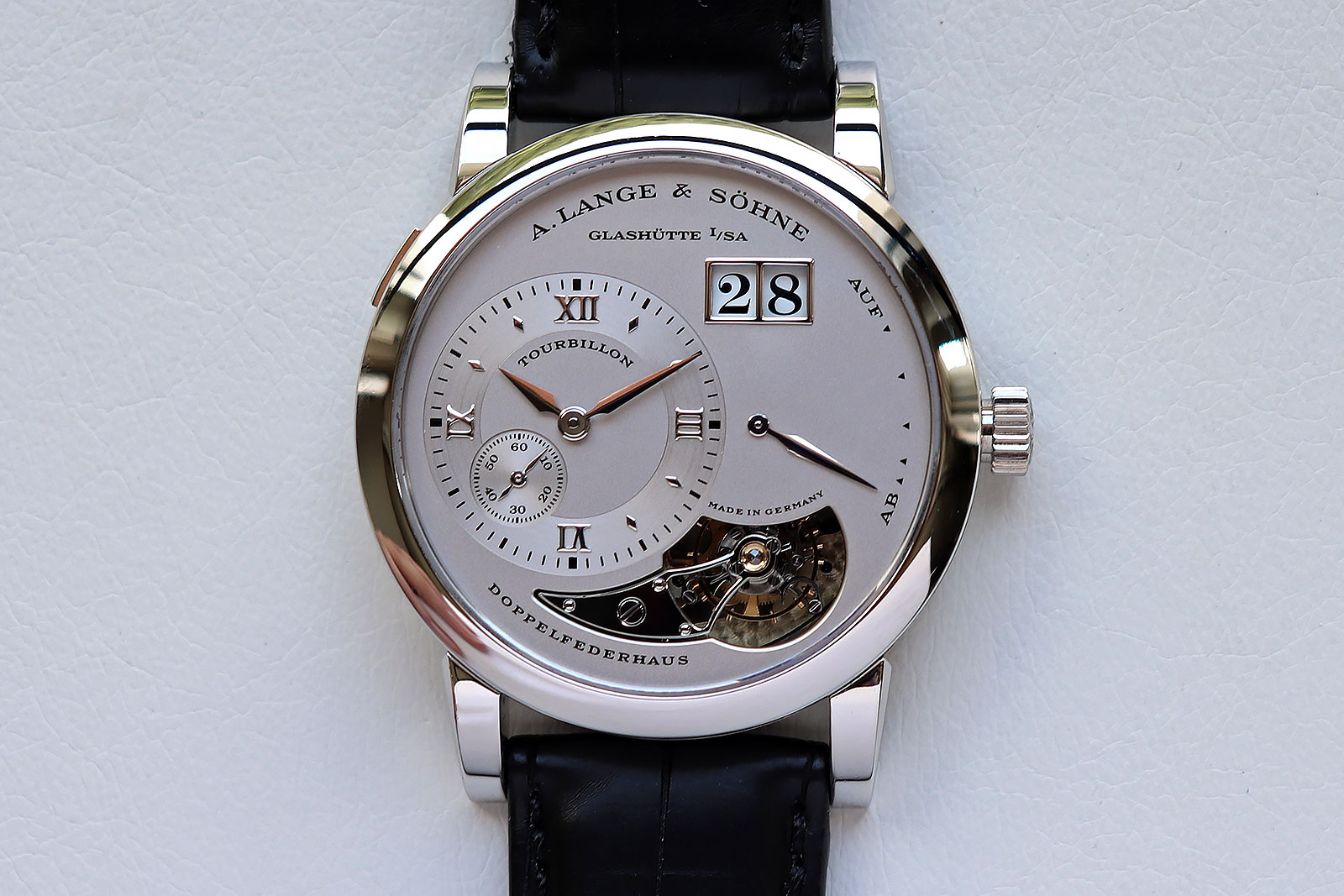
The original Lange 1 Tourbillon in platinum. Photo – the author
The dial
The Lange 1 Tourbillon Handwerkskunst breaks from the ornate mould of the series. Instead, it is endowed with a fabulous black enamel dial that is captivating and often impossible to photograph.
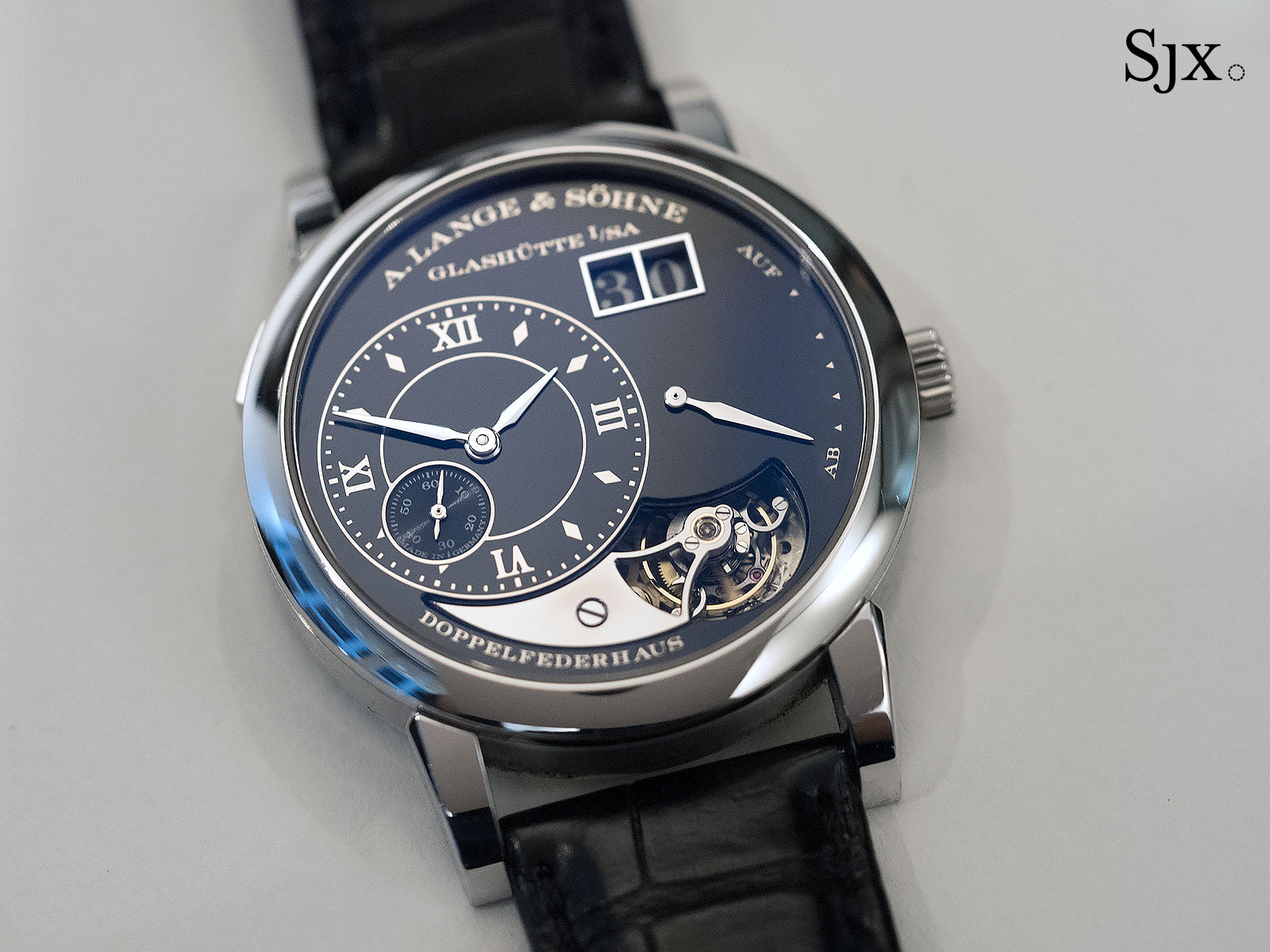
Lange watches with enamel dials have always been special and rare. The first such watch was the Langematik Anniversary of 2000, which took the brand years to complete due to slow production of the dials. It was followed by Richard Lange Pour le Mérite in 2009, and then the six examples of the Grand Complication in 2013, and finally the Lange 1 Tourbillon Handwerkskunst.
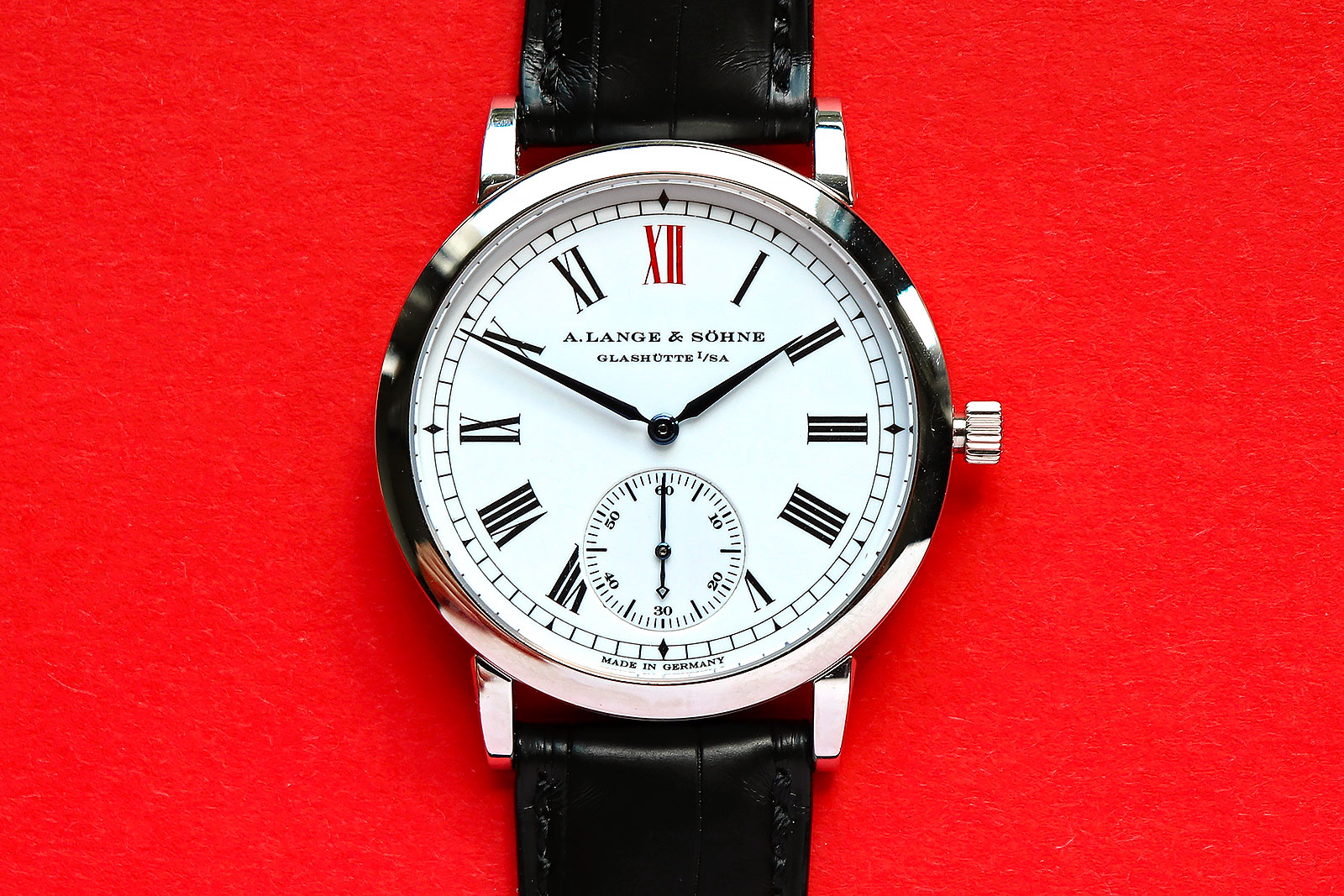
The Langematik Anniversary. Photo – the author
Essentially coloured, powdered glass, enamel is typically mixed with water and painted over the surface to be decorated. It’s then fired in an oven to melt the glass powder, fusing it to the surface, creating a smooth, glossy finish. The process is repeated as many times as needed to achieve the desired colour and depth.
But each trip to the oven means a crack, bubble, or deformation might form, and the entire dial has to be discarded. According to Lange, up to a dozen dials have to be made to get just one single, perfect dial. The rejection rate is even higher when enamel is applied on a relief-engraved surface, such as on the 1815 Rattrapante Perpetual Calendar Handwerkskunst (which we’ll detail further down).
Until the Lange 1 Tourbillon Handwerkskunst, Lange outsourced the production of enamel dials to specialists in Switzerland. But for the black enamel dial of the Handwerkskunst, the brand trained one of its engravers in the art of enamel, allowing it to bring the know-how of the ancient art in-house. The engraver-turned-enameller did a perfect job, upon close inspection of the black enamel dials I can surely say they are perfectly made.
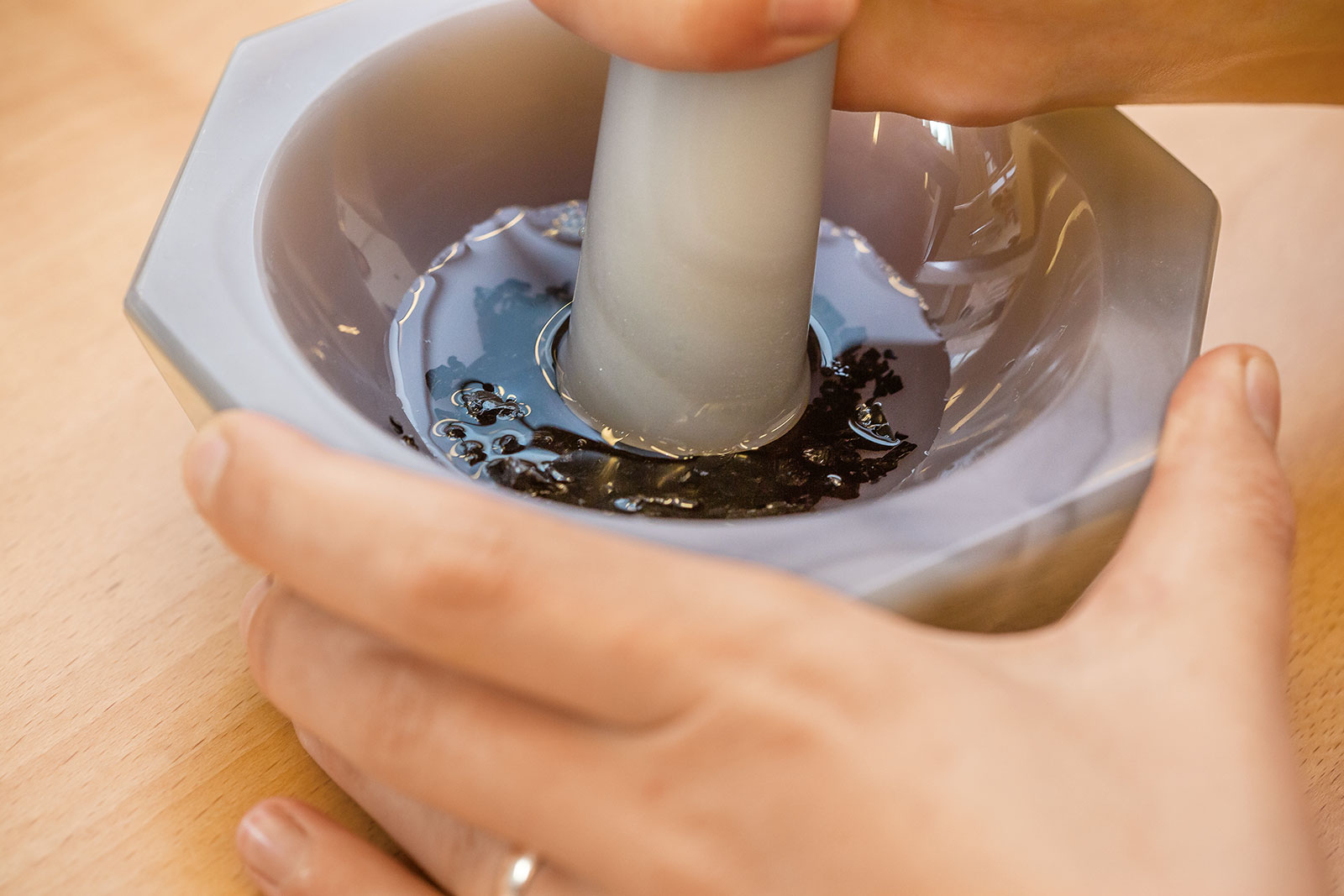
Grinding the enamel into powder. Photo – A. Lange & Söhne
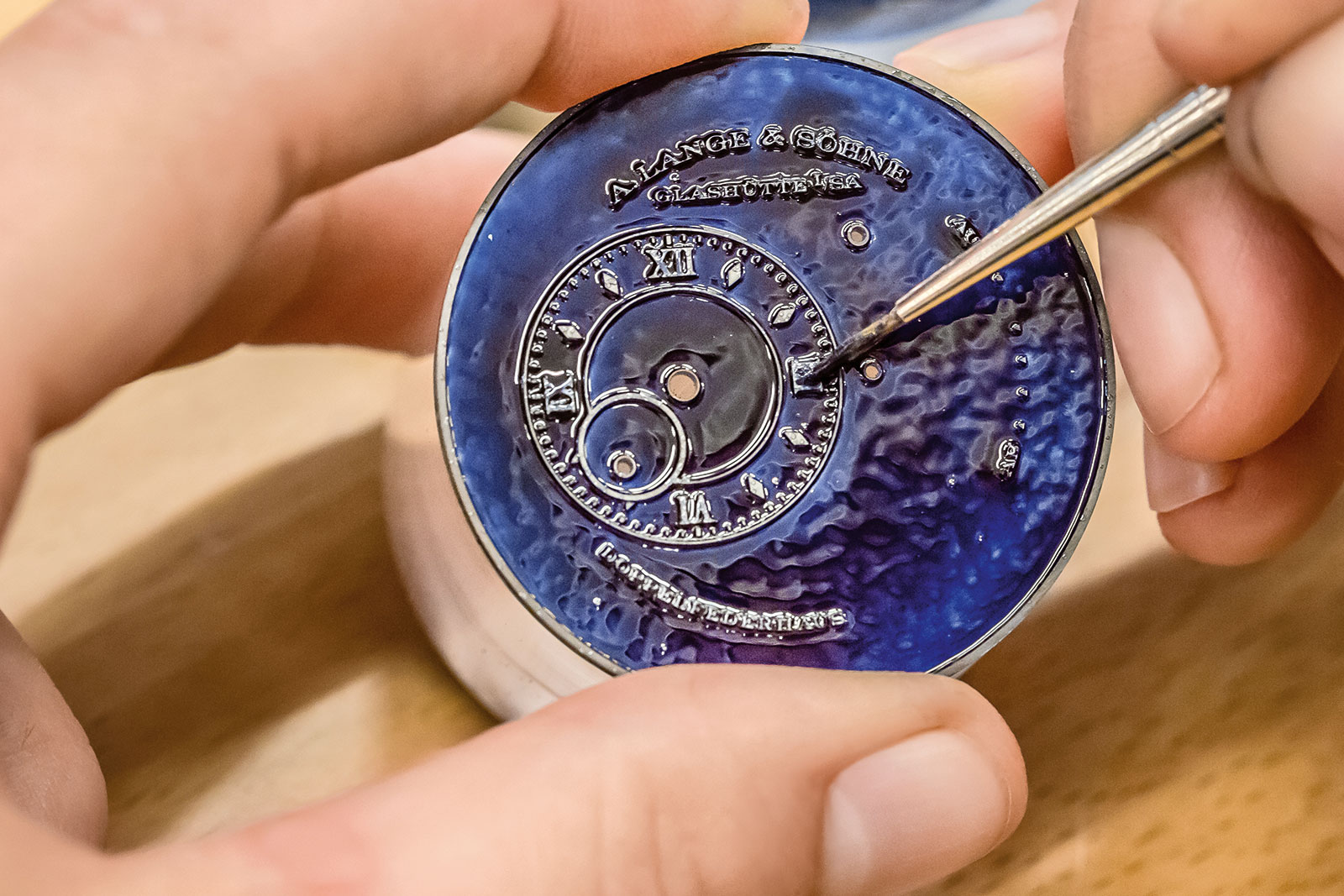
Painting the liquid enamel onto the dial. Photo – A. Lange & Söhne
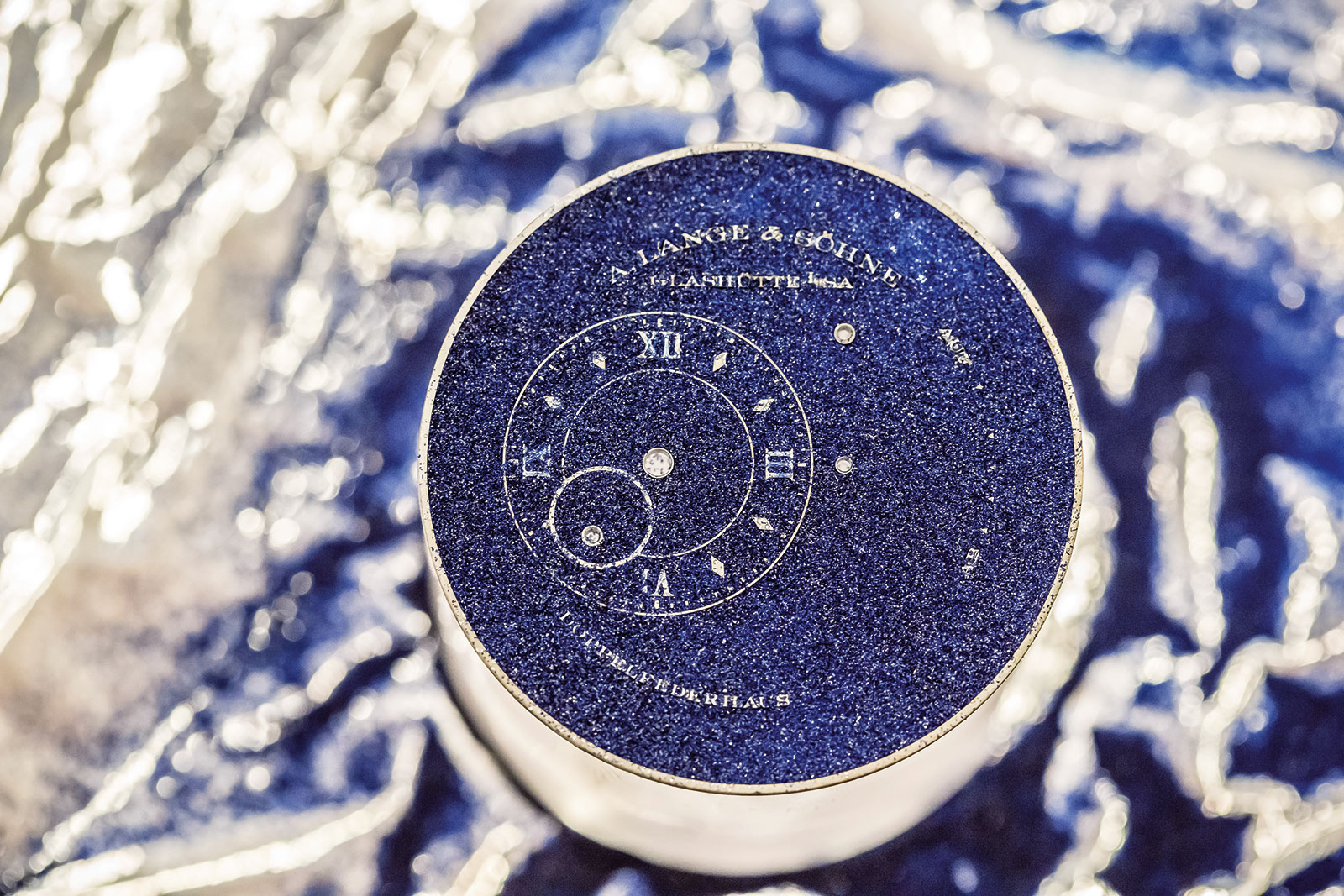
The dial after the initial firing, after which it will be painted with another layer of enamel and fired again, a process that is repeated multiple times. Photo – A. Lange & Söhne
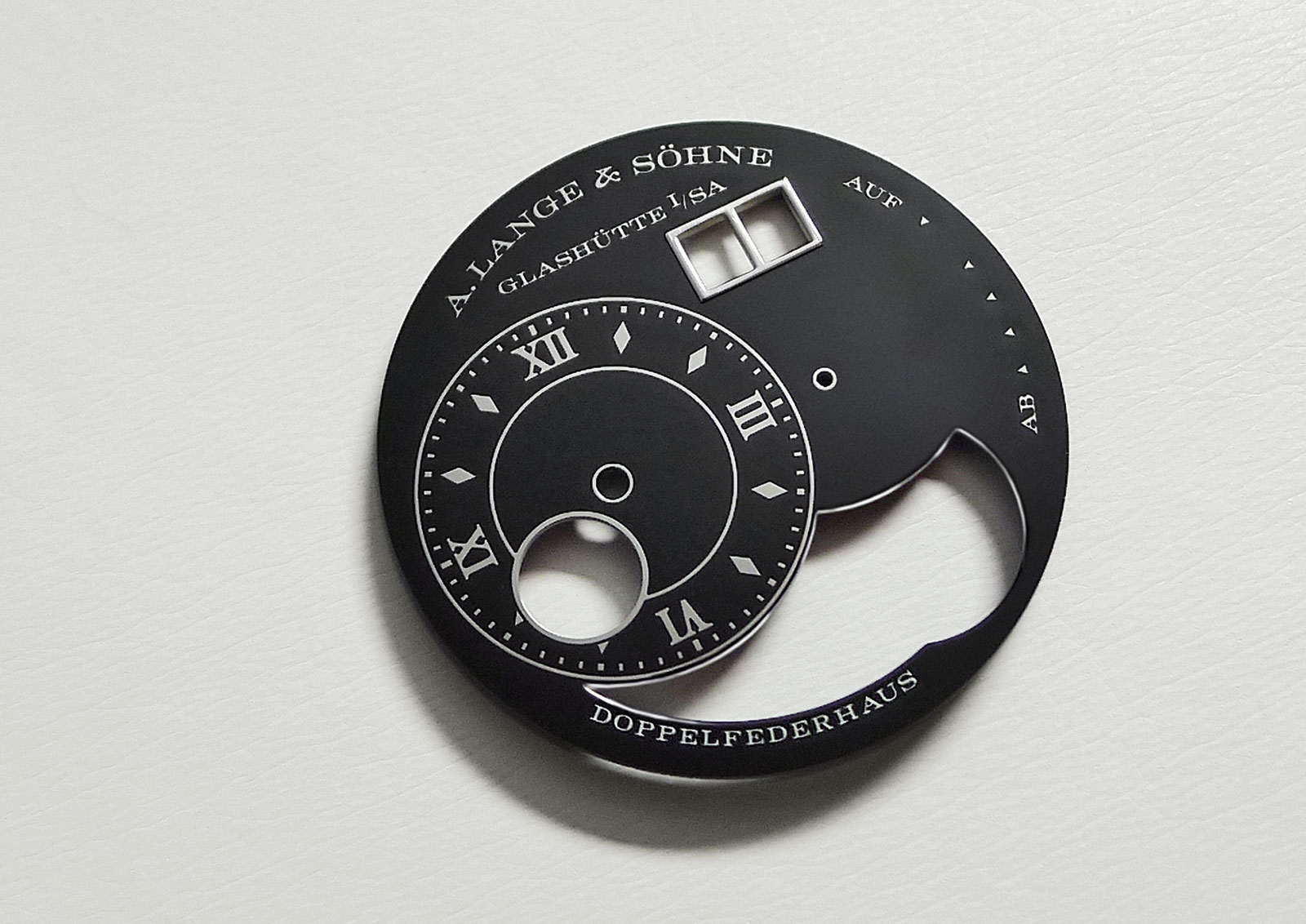
The main dial is black enamel on a white gold base, while the sub-dial for the seconds is a separate piece made of silver. Photo – A. Lange & Söhne
As with the standard model, the tourbillon cock is exceptionally finished with black polishing, with the pivot of the tourbillon sitting in a diamond end stone. Interestingly, the edge of the tourbillon cage is obscured by a curved edge of the main dial. Meant to hide the disc for the date display, the curved section was eliminated in Lange 1 Tourbillon Honey Gold model, revealing the entirety of the tourbillon cage as well as the date disc, so it is unusual to see it return here.
In terms of finishing, one omitted detail is the lack of inward corners within the tourbillon cock, but that is made up for by the fact that inward corners are abundant on the back.
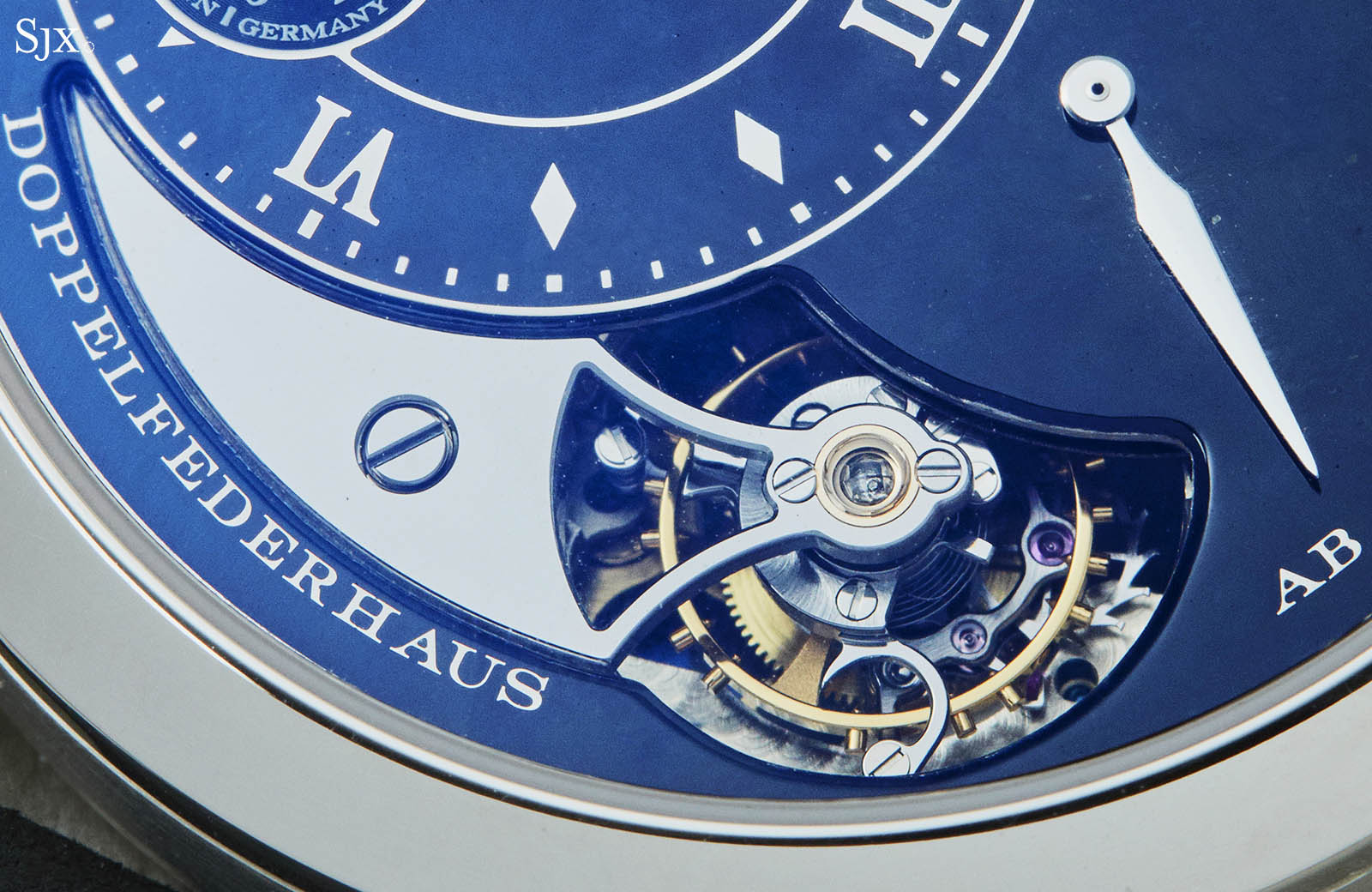
The tourbillon cock containing the diamond end stone, and next to it the thick layer of enamel visible on the edge of the aperture
The L961.3
The technical difference between L961.1 of the first standard model and the L961.3 of the Handwerkskunst edition the hacking-tourbillon mechanism that was invented by Lange and introduced in 2008 in the Cabaret Tourbillon.
In terms of decoration, the difference between the Lange 1 Tourbillon and earlier Handwerkskunst models is radical and thought provoking.
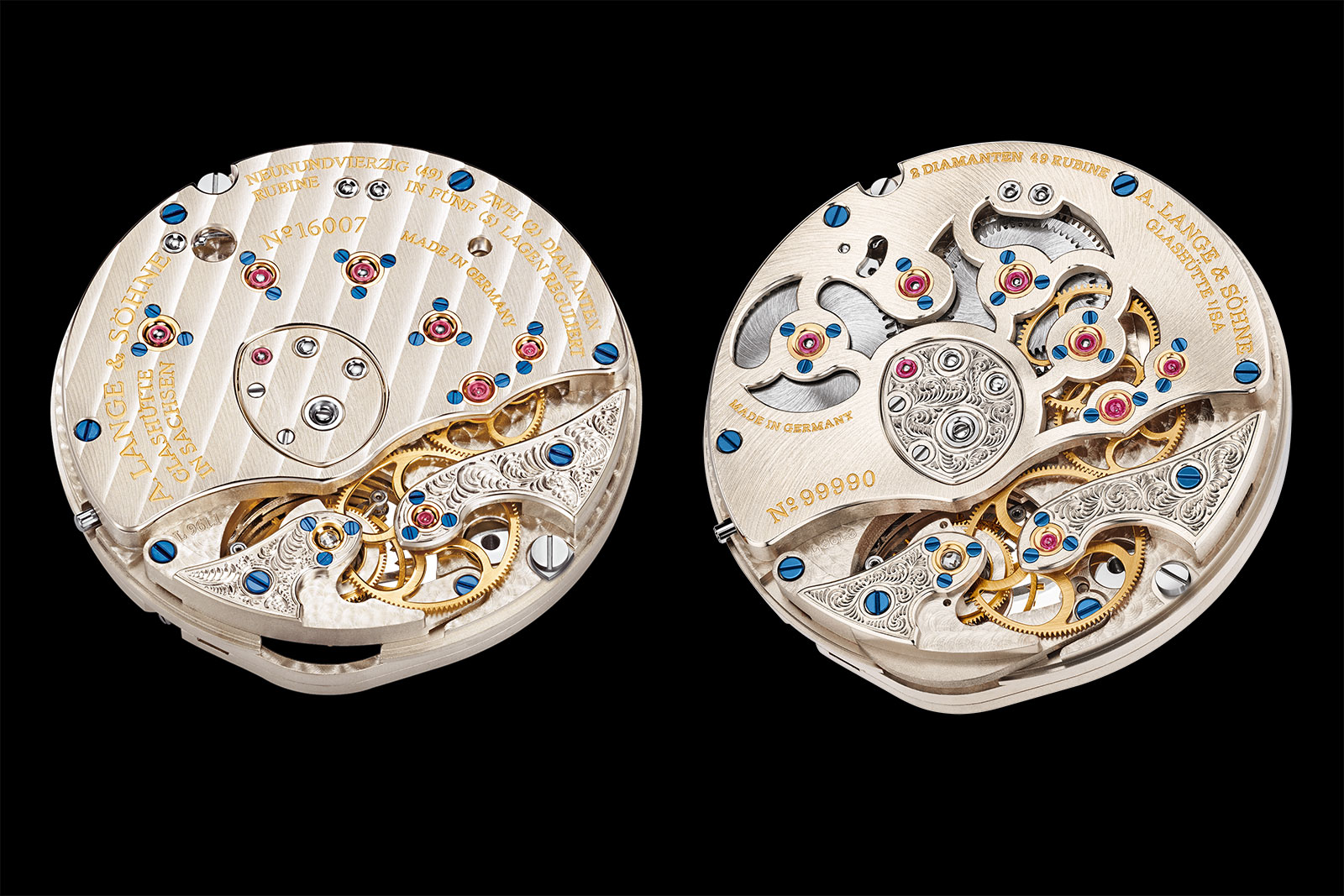
The standard L961.1 (left), and the Handwerkskunst L961.3. Photo – A. Lange & Söhne
While the standard movement features the classic, full three-quarter plate, the L961.3 is lusciously open worked, showing off mesmerising hand finishing everywhere – a stark difference between the standard and Handwerkskunst editions that’s absent in preceding watches of the series.
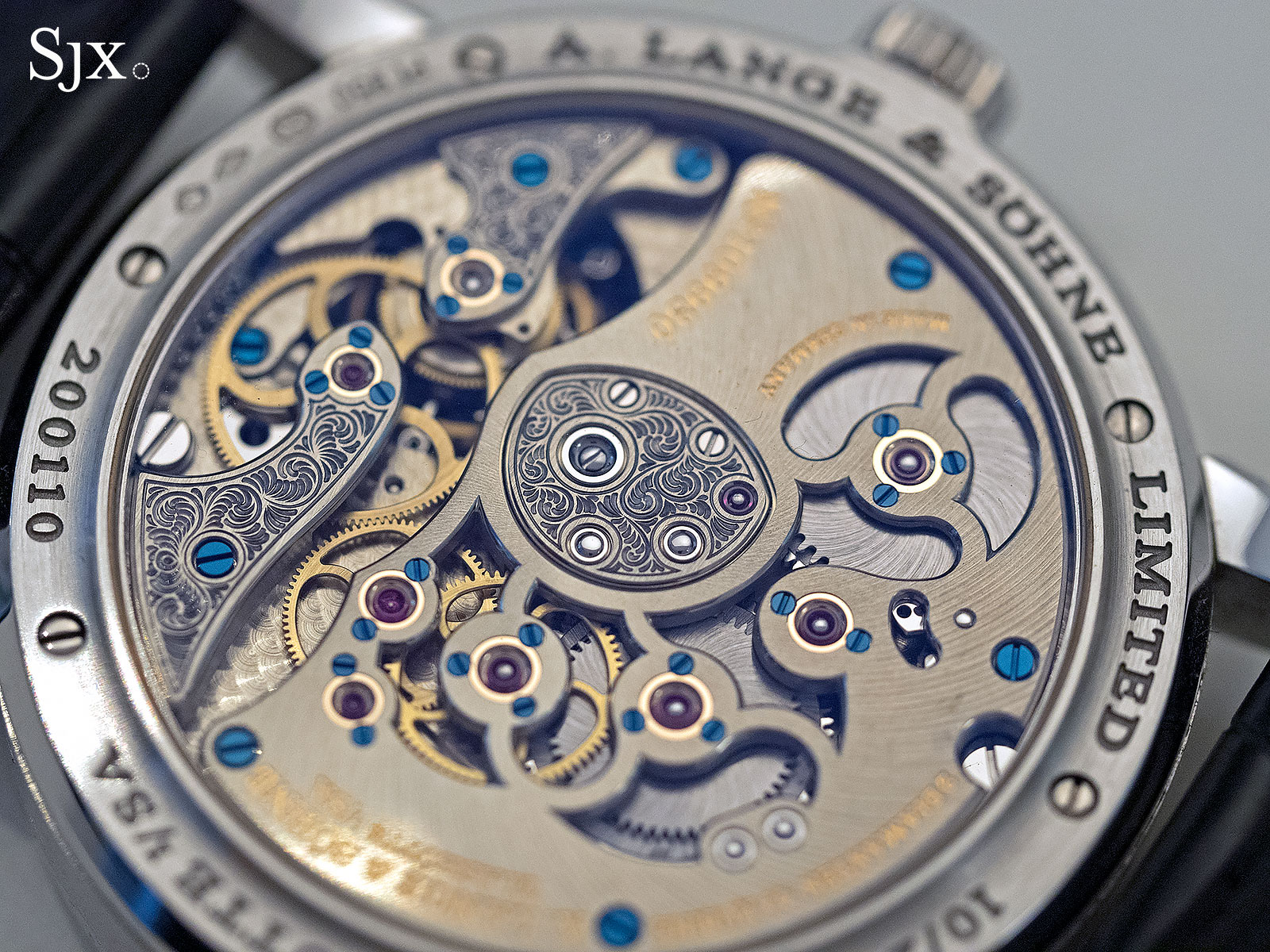
Note the exceptional finish, skeletonisation and sharp inward corners of the bevelled edges
The three-quarter plate is finished with solarization instead of striping and artfully skeletonised. Revealing the twin barrels of the movement, the apertures showcase the exquisite hand finishing that’s apparent from inward corners on the bevelled edges.
And besides the cocks for the tourbillon and fourth wheel, the crown-wheel plate is also beautifully engraved.
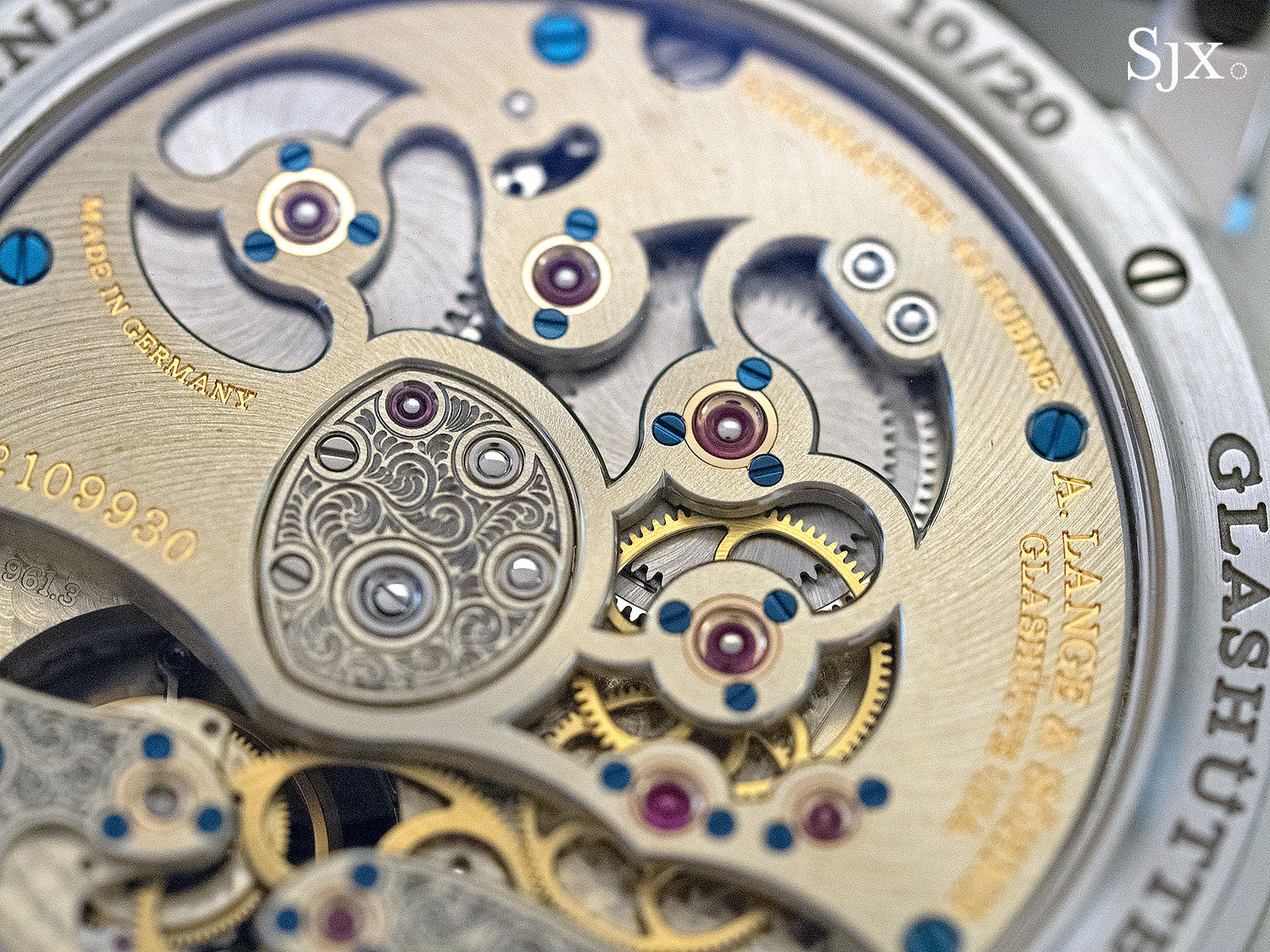
The market
The retail price at the time of the introduction was US$221,700. Since then, the watch has appeared twice at auction, both instances at Phillips. Numbers 10/20 and 18/20 were sold for US$224,000 and US$221,700 respectively.
Compared to other Lange 1 Tourbillon variants that are generally lukewarm on the secondary market, the Handwerkskunst edition selling for its original retail is a success for this extremely fine and rare beauty.
Two important factors help its desirability, one is the simple fact that is looks totally different from the standard models, with the glossy black enamel dial being striking even from a distance. And the other is is the heavily upgraded movement finishing, which is evident as soon as you turn the watch over.
2015 – 1815 Tourbillon Handwerkskunst (ref. 730.048)
Tourbillons are commonplace today, but Lange’s tourbillons, with their innovation and admirable finish, are amongst the few that deserve attention. Apart from the first-generation Lange 1 Tourbillon, the brand has never equipped a movement with a tourbillon without another serious complication.
Amongst other complications, Lange was the first brand to install the fusée and chain in a wristwatch with the Tourbillon Pour le Mérite in 1994. And in 2008, Lange managed to stop the “whirlwind”, becoming the first watchmaker hack a tourbillon with the introduction of Cabaret Tourbillon with its patented stop-seconds mechanism.
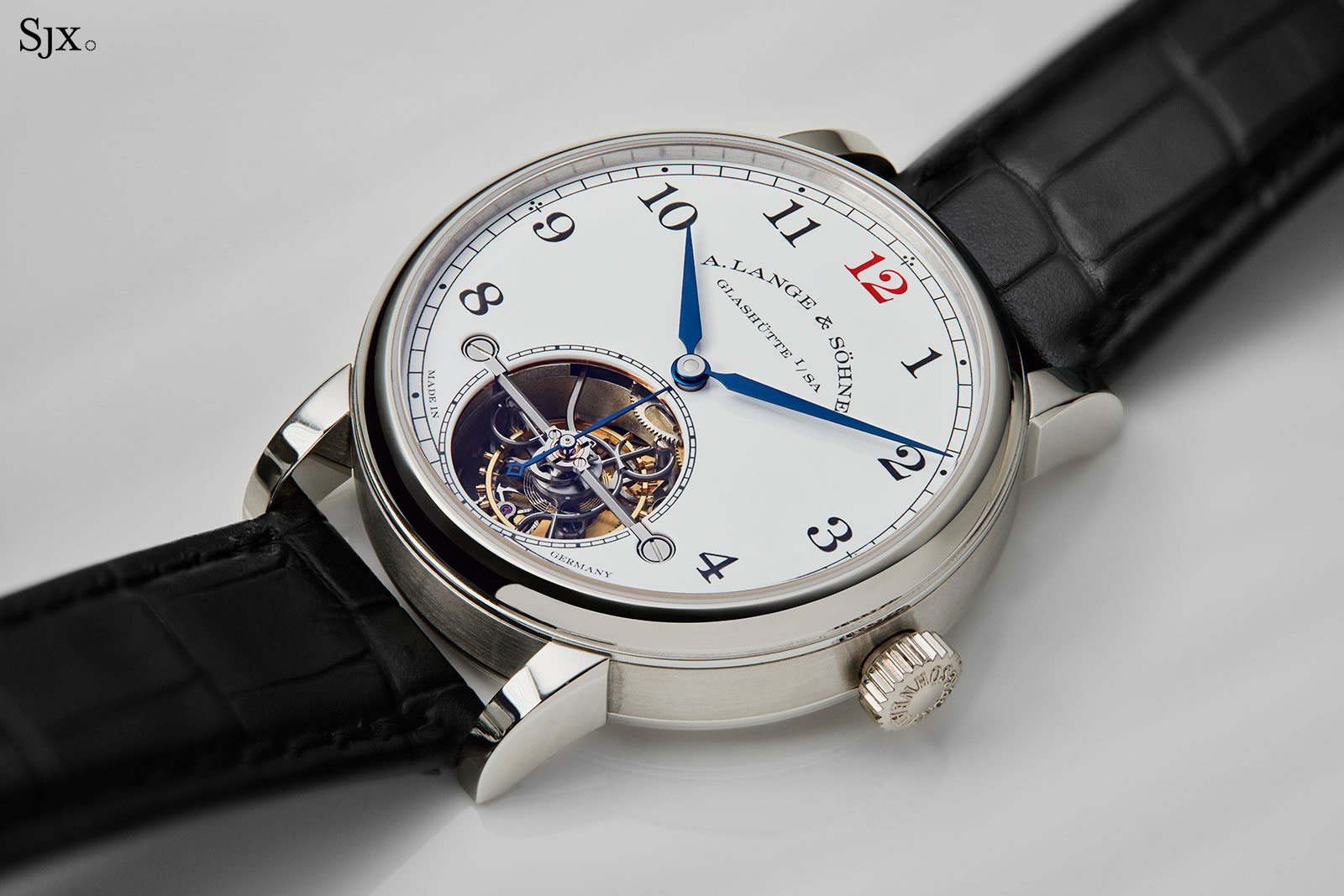
The 1815 Tourbillon with enamel dial
Six years later, Lange launched 1815 tourbillon that combined two patents: the zero-reset seconds of 1997 and the hacking tourbillon of 2008. The 1815 Tourbillon was launched in platinum as a 100-piece limited edition, and in pink gold as a standard model, with another limited edition with an enamel dial arriving in 2018.
But only a year after the introduction of the standard version in 2014, and just in time for the 200th birthday of Ferdinand Adolph Lange, the Handwerkskunst edition was unveiled as a limited edition of 30 pieces.
The dial
Made of black rhodium-plated pink gold, the dial is finished with the tremblage as is a habit for the Handwerkskunst.
The 1815 Tourbillon’s simplicity creates the perfect balance for the ostentatious Handwerkskunst decoration. Polished, relief pink gold numerals create a stunning contrast against the granular dial.
I feel the tremblage decoration works the best with this model. The logo as well as the Arabic numerals have the space to maximise the depth that results from the engraving technique.
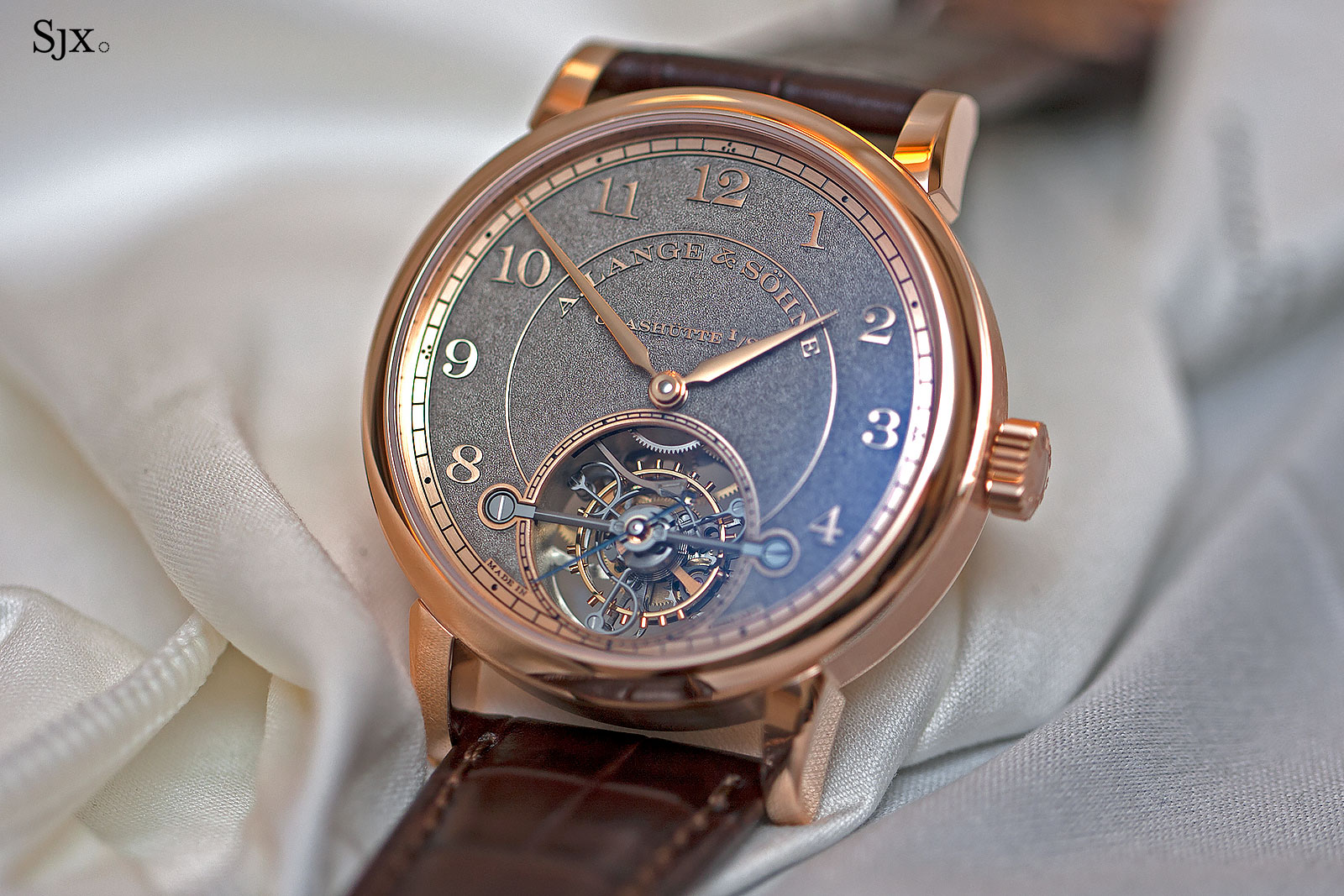
The 1815 Tourbillon Handwerkskunst
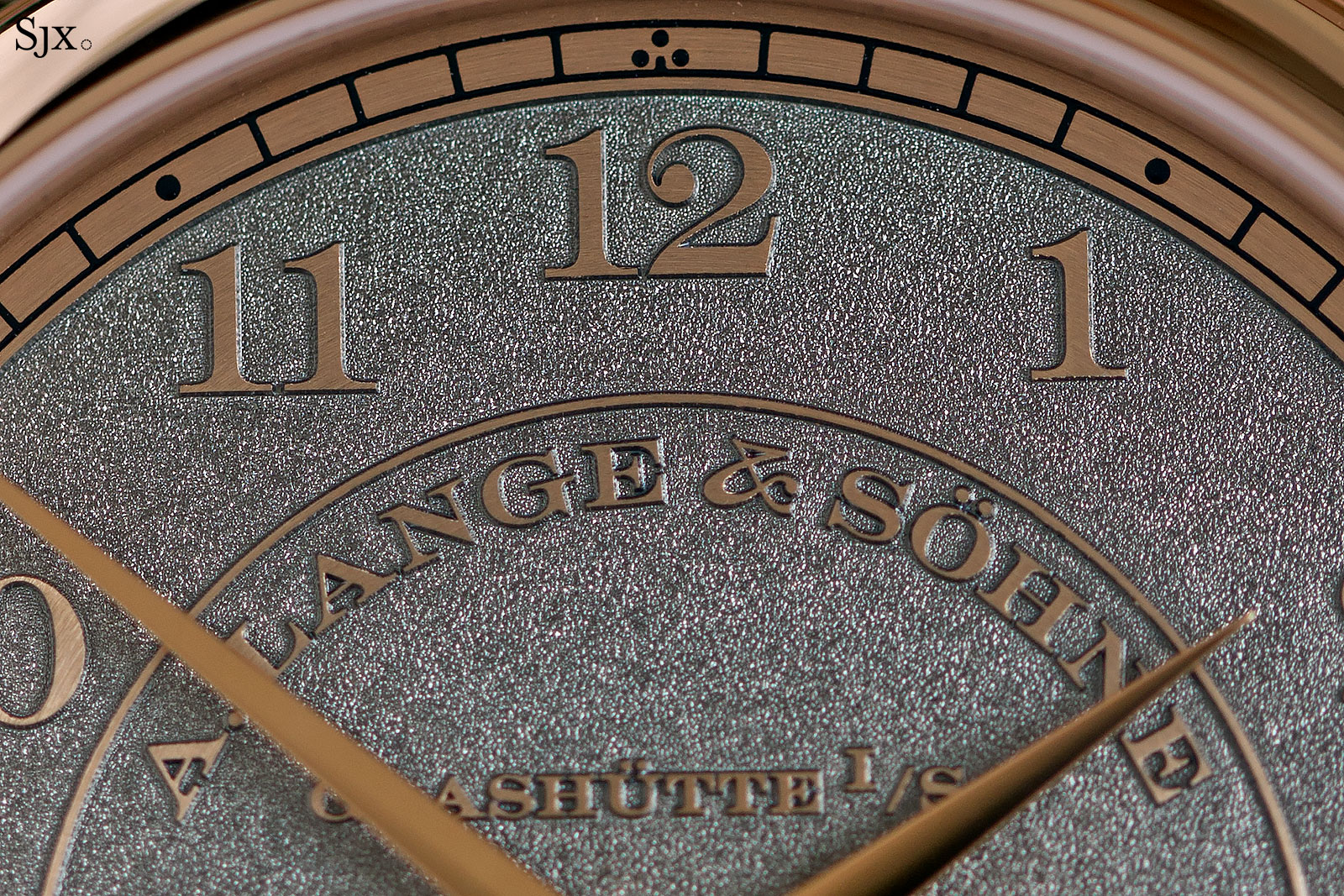
Far more complex than a standard tourbillon, the tourbillon regulator takes two days to assemble. It’s made up of 84 parts and weighs only 0.25 g. Visible just above the cage is the hacking lever that stops the tourbillon by touching the cage. And the exceptional construction of the tourbillon is accompanied by a praiseworthy finish on the bridge and cage.
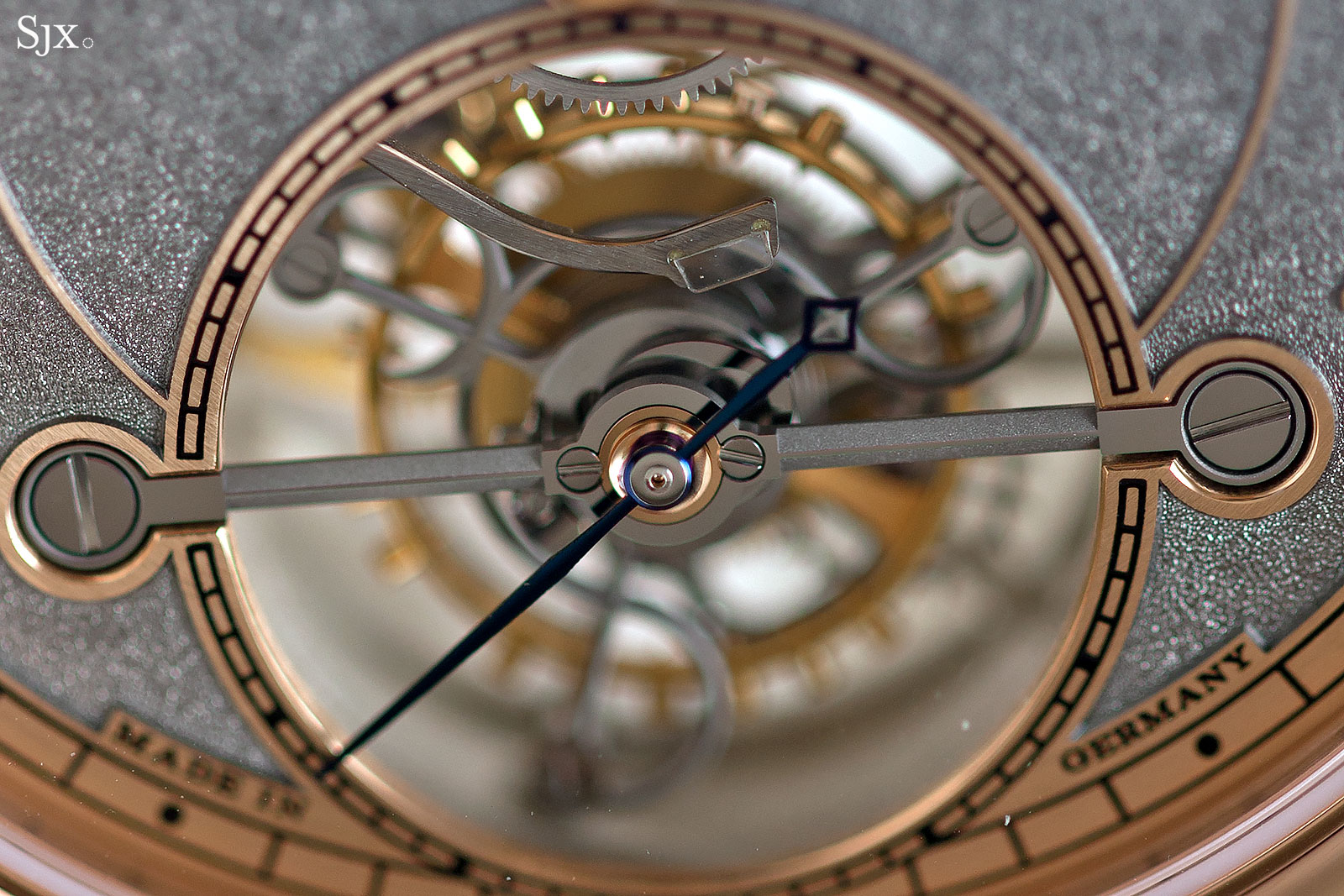
The black-polished tourbillon bridge is flawless, with a blued steel seconds hand that adds just right amount of colour
The L102.1
As with the Lange 1 Tourbillon Handwerkskunst, the difference in finishing between the movement variants is striking.
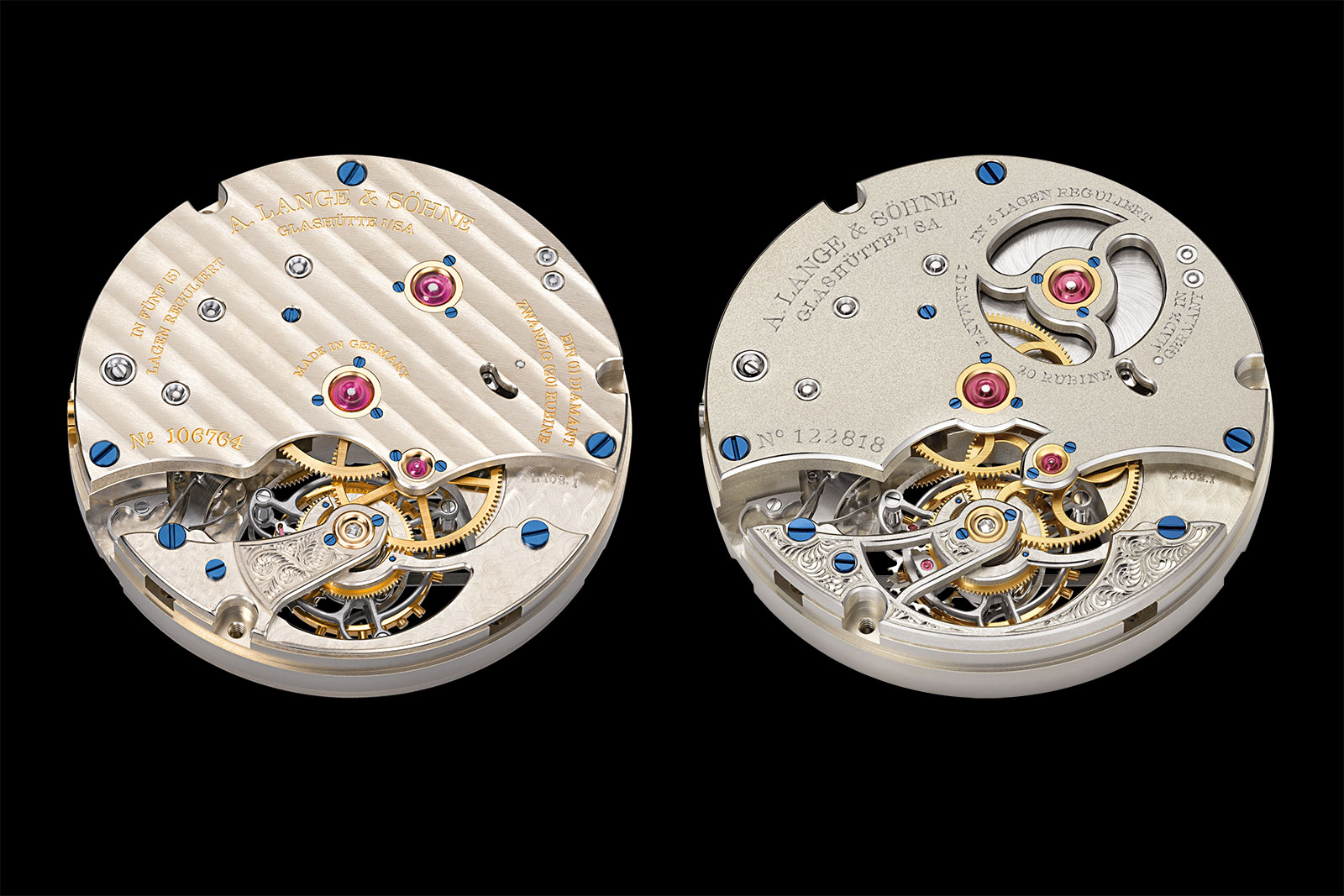
The standard L102.1 (left), and the Handwerkskunst version. Photo – A. Lange & Söhne
Instead of the standard three-quarter plate with striping, the Handwerkskunst movement features a frosted three-quarter plate with hand-engraved lettering done to perfection. It also features a spiral-shaped opening that reveals the sunray-finished barrels. The opening for the mainspring barrel is exceptionally finished with six sharp, inward corners on its bevelled edges.
Moreover, instead of the rounded outline found on the standard movement, the three-quarter plate has been carefully shaped to maximise the opportunities for astonishing hand decoration. Sharp inward angles on the perimeter of the three-quarter plate create a great contrast with the darkened, frosted plate.
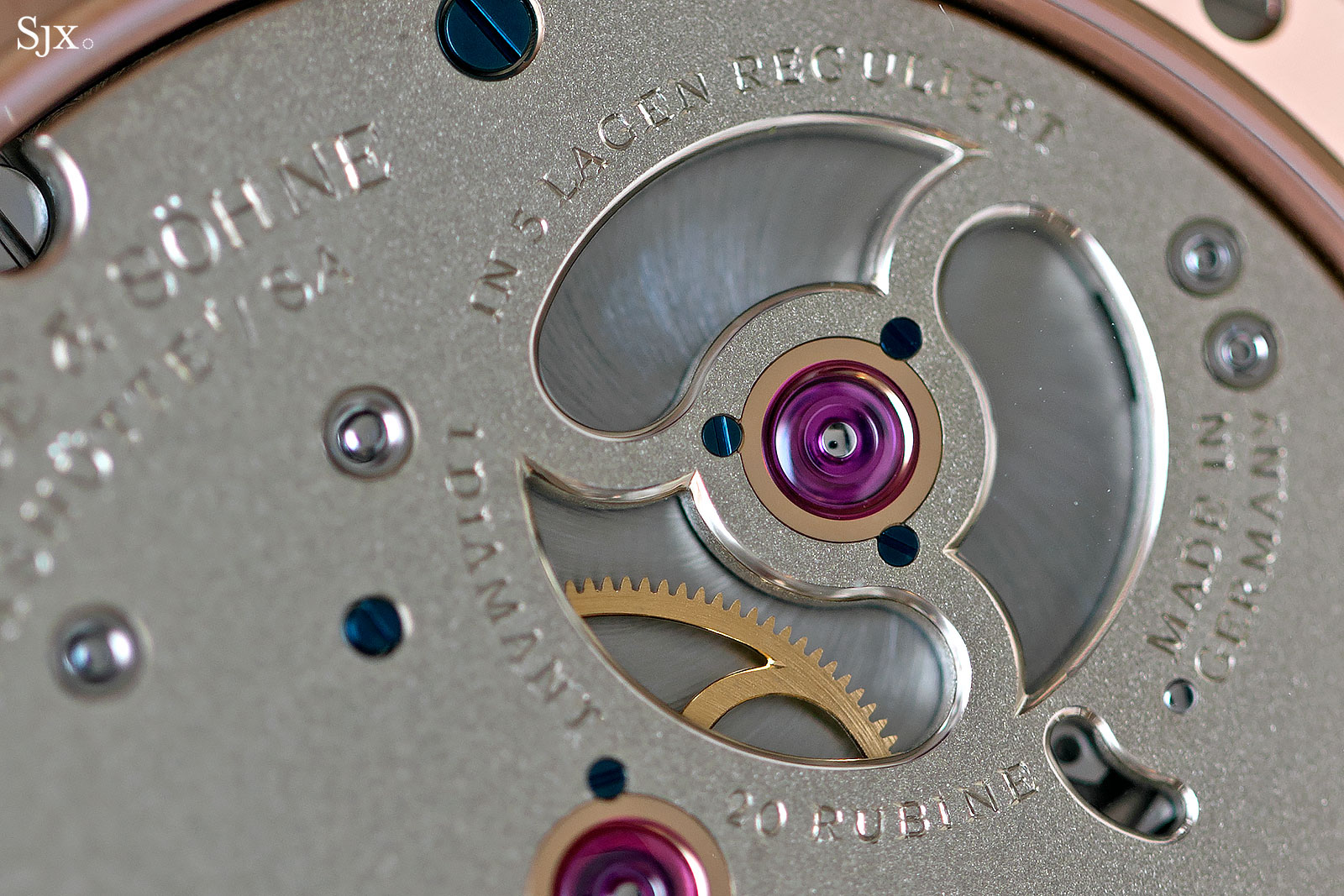
Wonderfully finished opening on the mainspring and its opening as well as hand-engraved lettering on the plate
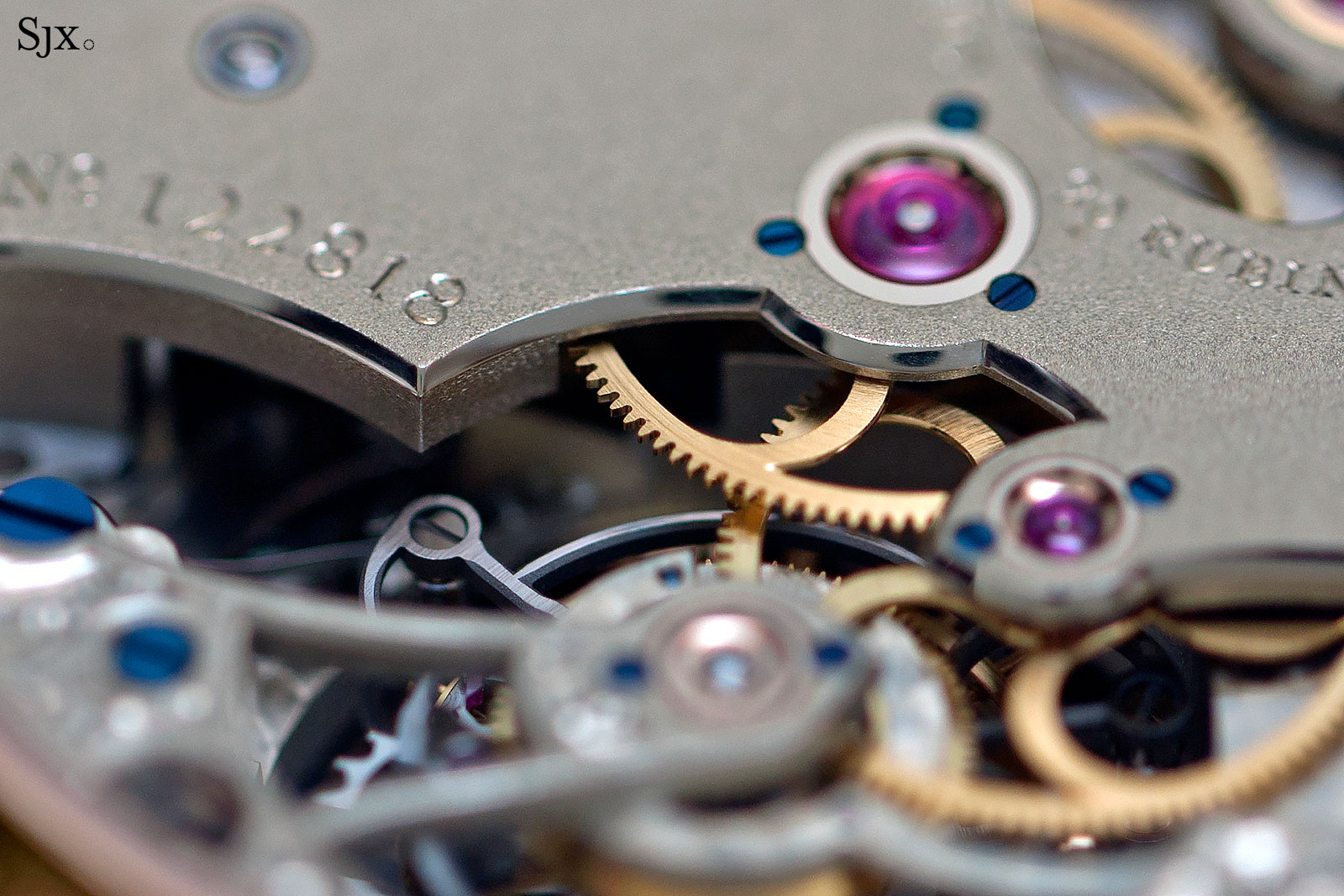
Note the extensively finished centre- and third wheels (centre), and the sharp, inward angles on the bevelled edge of the plate
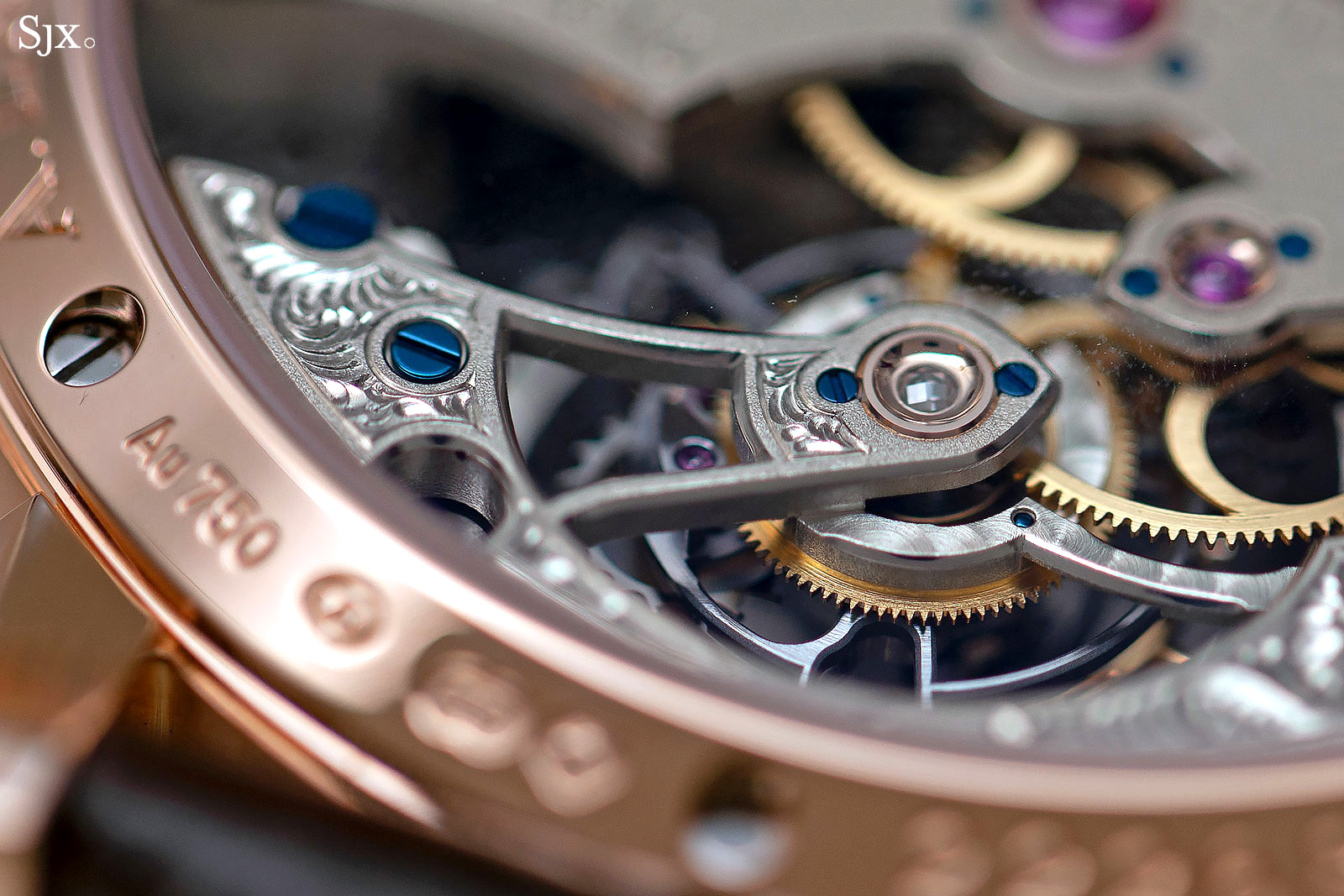
The skeletonised tourbillon cock
Featuring curved spokes that are unusual in Lange movements, the centre and third wheel also reveal extensive decoration. At the same time, tourbillon cock has been skeletonised for a full view of the gorgeous mechanism.
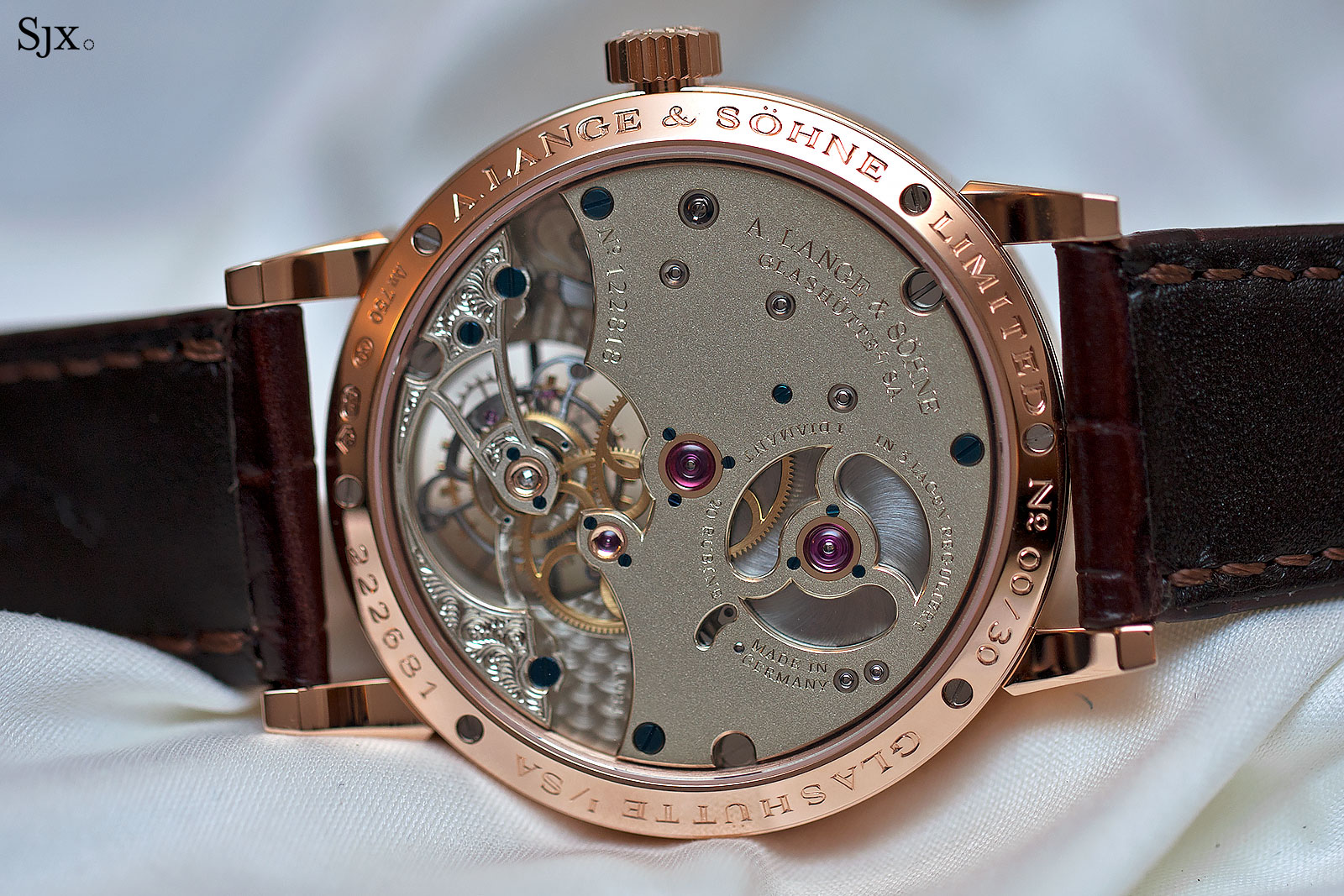
The gorgeous L102.1 seen through the case back
The market
There is no public data on the 1815 Tourbillon Handwerkskunst since the watch has never appeared at auction so far. In the last four year, I have only known of two examples changing hands, both at a considerable premium over the retail price of US$181,000.
Like the Lange 1 Tourbillon Handwerkskunst, the 1815 Tourbillon edition enjoys the same advantage of having a movement that is obviously superior in finish to the standard model, making it easy for collectors to quickly grasp why it is special, explaining why it remains sought after.
2017 – 1815 Rattrapante Perpetual Calendar Handwerkskunst
The 1815 rattrapante perpetual Calendar is one of the heavyweight champions in the Lange catalogue. As is typical of the 1815 line, the design is utterly traditional, reminiscent of a pocket watch from the 19th century.
Introduced in 2013 along with the Grand Complication, the 1815 Rattrapante Perpetual Calendar is second prize for those who cannot get the ultimate, multi-million euro Lange. In the year of its introduction, the watch won two awards at Grand Prix d’Horlogerie de Geneve (GPHG), in the categories of Grand Complication and Public’s Choice.

The 1815 Rattrapante Perpetual Calendar with its utterly traditional look
Four years after its introduction in platinum and pink gold, Lange introduced the 20-piece 1815 Rattrapante Perpetual Calendar Handwerkskunst in 2017 at an event in Florence, the brand’s first and only major launch event in Italy.
The dial
Imagine a multi-layered dial with four separate sub-dials – and each sub-dial is double stepped – along with 11 hands. If that were not enough, throw in relief engraving and enamelling on the main section of the dial, making it even more complex and cluttered than it already was.
In theory, such an elaborate combination would be a mess due to its exaggerated complexity; it simply wouldn’t work. I thought as much until I first laid eyes on the watch on a collector’s wrist at SIHH 2019.
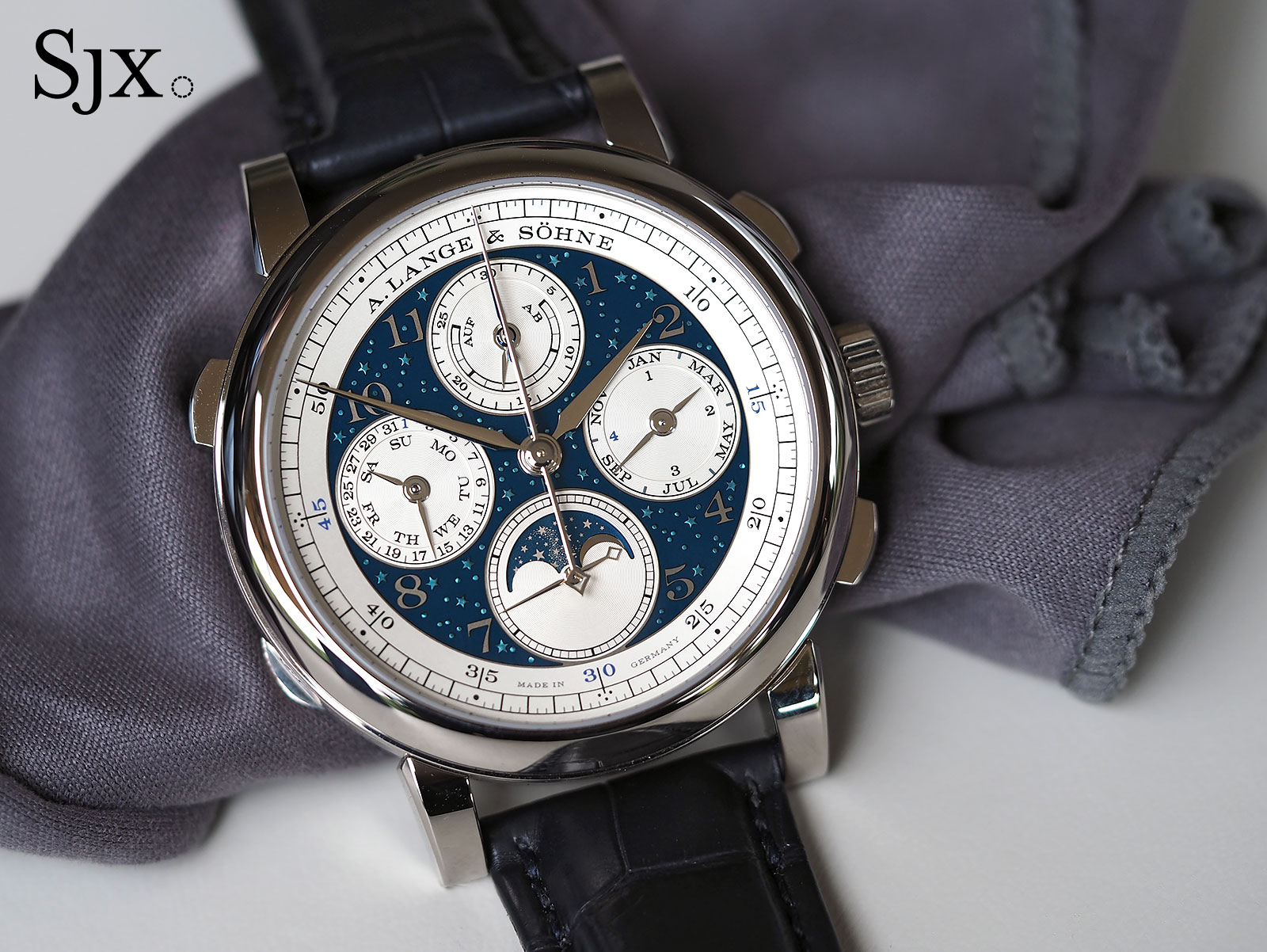
A cocktail of craft and complications
From concept to execution, the 1815 Rattrapante Perpetual Calendar Handwerkskunst is a piece of art and one of the best examples of the harmony between decoration and design. It is the first model in the series that combines enamelling and engraving – and manages to blend the two exceptionally well.
Known as champlevé, the enamel technique used for the dial translates as “raised field”, a literal description of the technique. Made of white gold, the dial is relief engraved with stars and then covered in translucent blue enamel.
The enamelled dial actually highlights out the sub-dials, and makes the entire look work better than on the standard model despite the seeming complexity. At the same time, the pocket watch-inspired style perfectly suits the blue enamel dial and astronomical decoration.
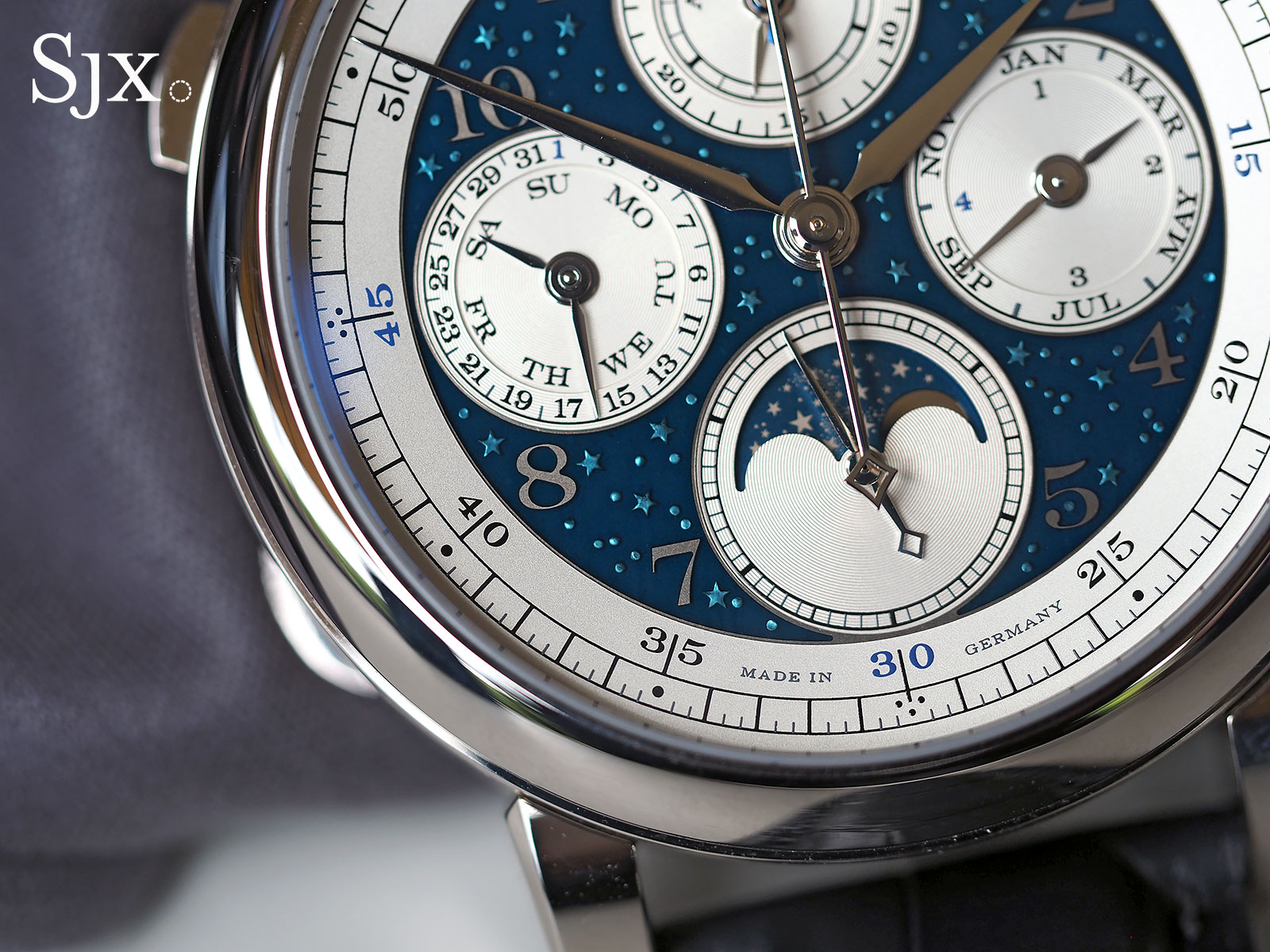
The L101.1
The theme of a starry sky continues on the back and inside.
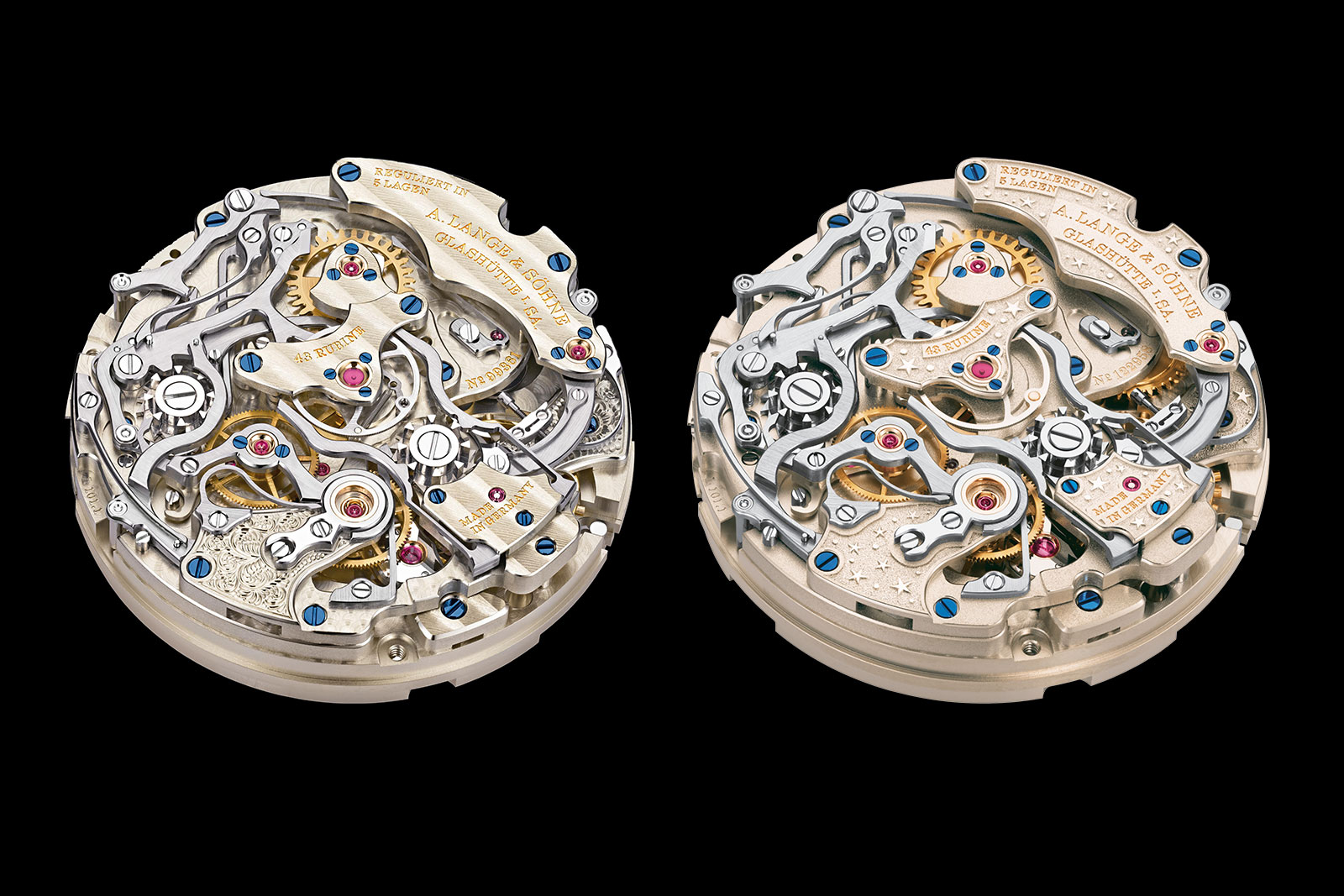
The standard L101.1 (left), and the Handwerkskunst version. Photo – A. Lange & Söhne
When you turn the watch over, you are greeted by a combination of tremblage and relief engraving, as well as enamelling, along with a grumpy face in the middle. It is the Roman goddess of the moon, Luna, who has been depicted unhappy for some reason.
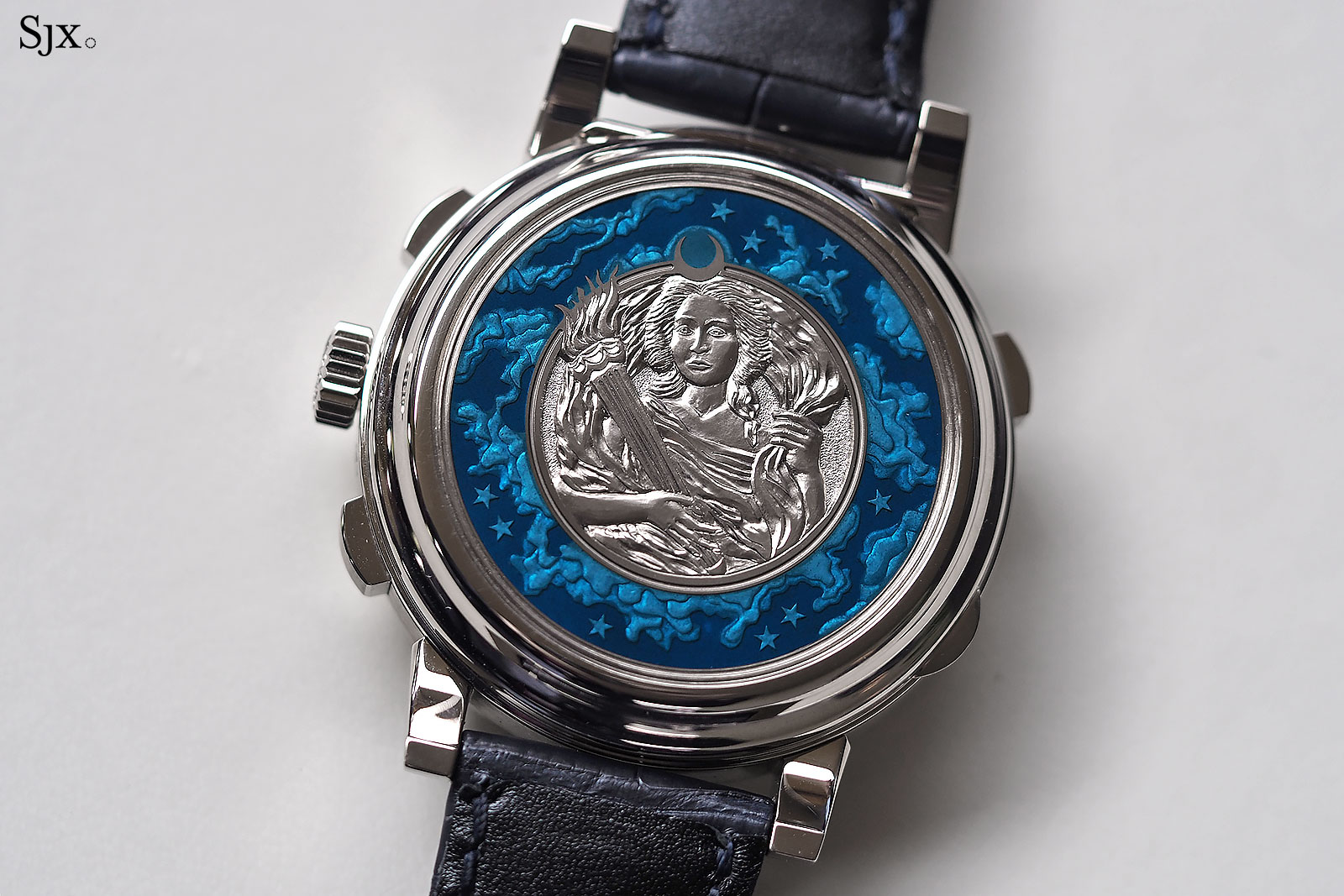
The crotchety Goddess of the Moon: Luna; with a torch which she lights up the darkness
All of that is on the hinged case back, lift it up and the marvellously decorated and complex movement presents itself.
The finely finished chronograph levers, twin column wheels and engraved bridges are a sight to behold. Star-motif relief engraving is found on the four bridges for the chronograph and split-seconds levers.
With all the complexity of the movement and a hinged case back that adds 1.1 mm to the total, the Handwerkskunst version measures 15.8 mm high.
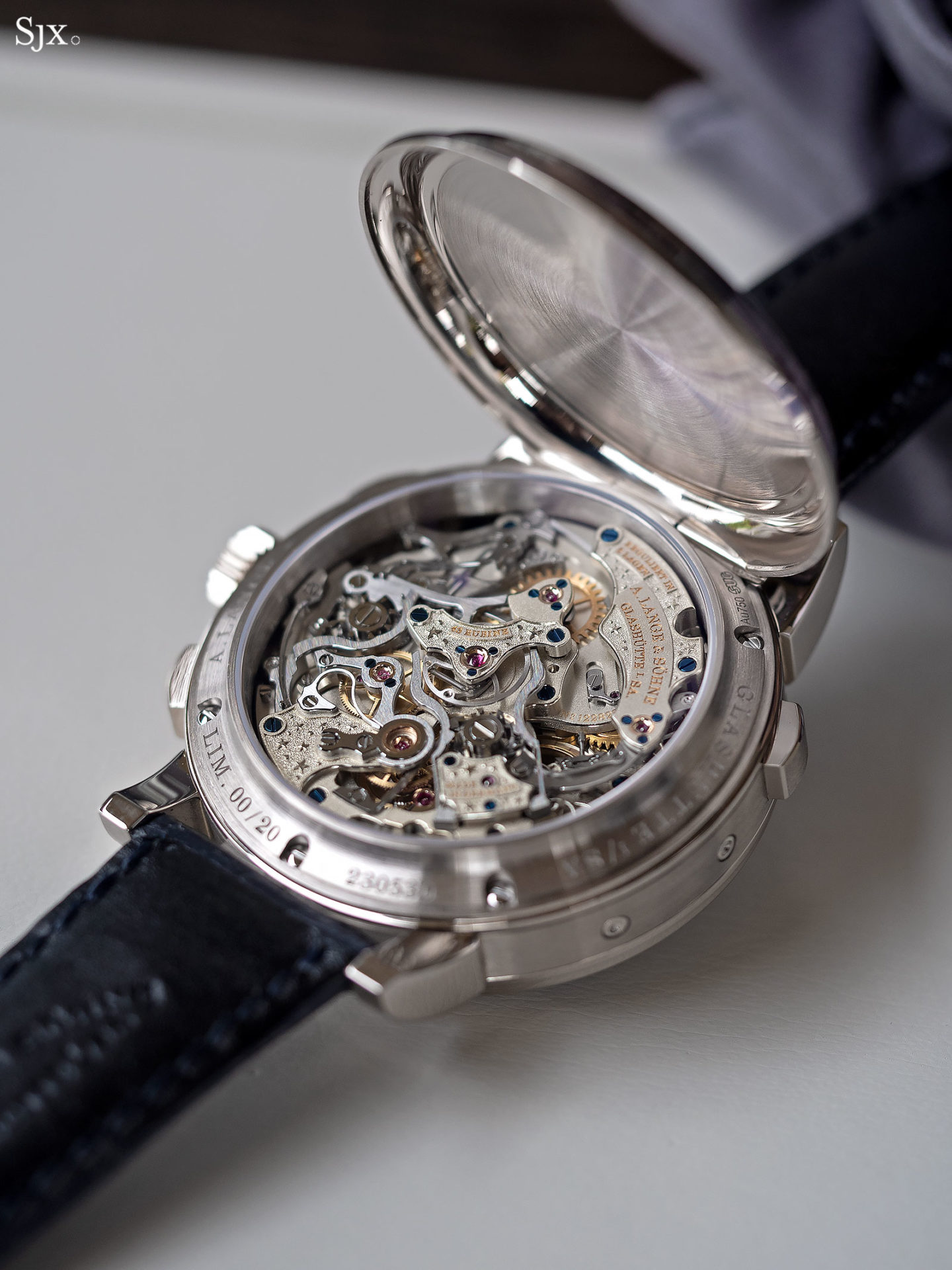
Lift the back and the movement is revealed
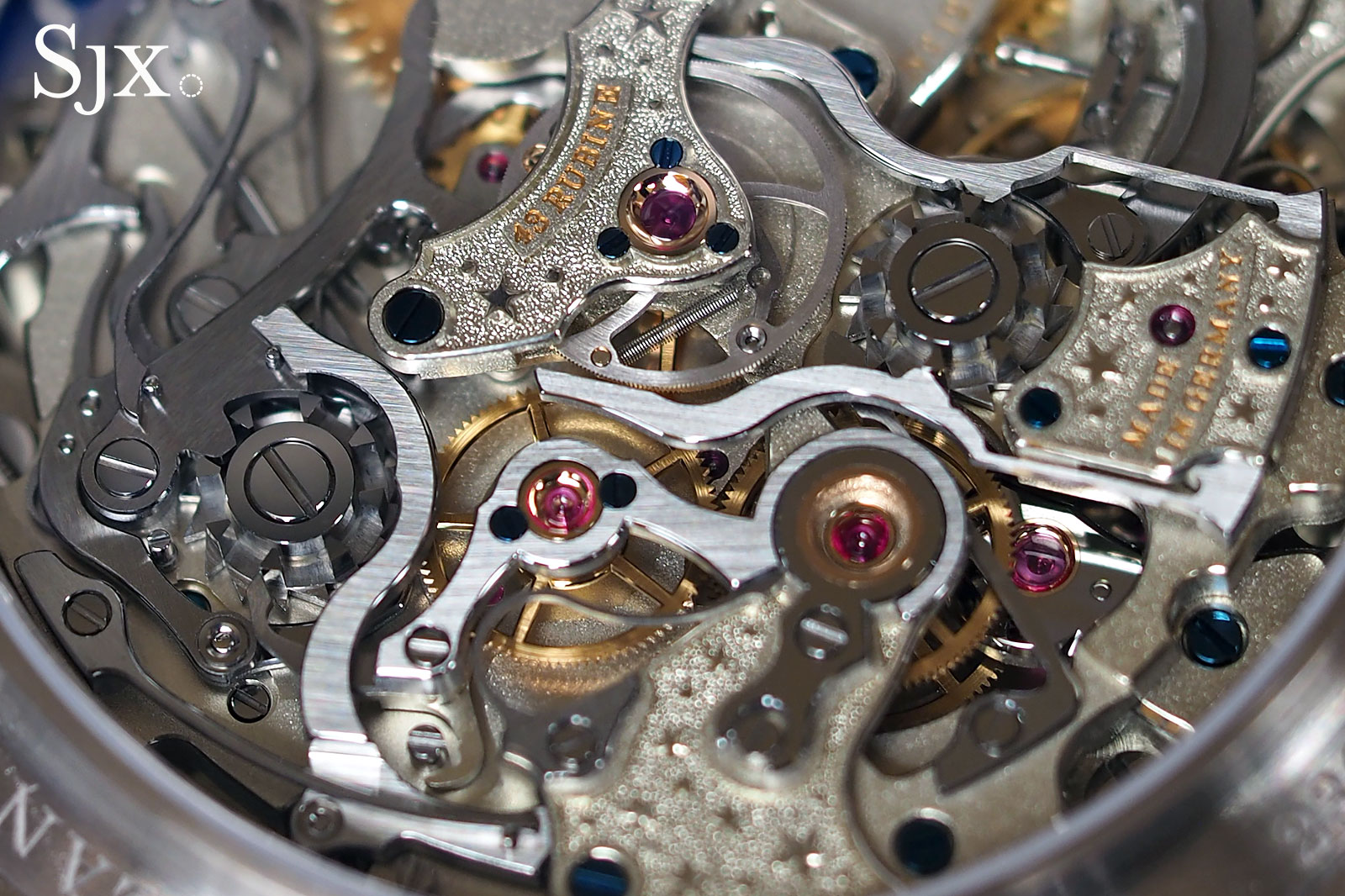
As superbly finished as in the standard version
Value
I do not know of any of the 20 examples of the 1815 Rattrapante Perpetual Calendar Handwerkskunst having changed hands since its launch three years ago, though I expect it will be desirable on the secondary market, given how special it is, compared to both the standard model and even other Handwerkskunst editions.
2021 – Cabaret Tourbillon Handwerkskunst (ref. 703.048)
Following a four-year hiatus for the Handwerkskunst series, Lange introduced the seventh instalment in July 2021. This time, the launch was even more special because for the first time, the Handwerkskunst treatment was applied to a discontinued model, creating the Cabaret Tourbillon Handwerkskunst.
The Cabaret Tourbillon was first introduced in 2008 with much ceremony – deservedly so because the majestic, rectangular case was housing an incredible feat of watchmaking – the first hacking tourbillon in a wristwatch. The launch price of US$265,400 was also suited to the importance of the innovation. In comparison, the Double Split in platinum retailed for around US$115,000 at the time.
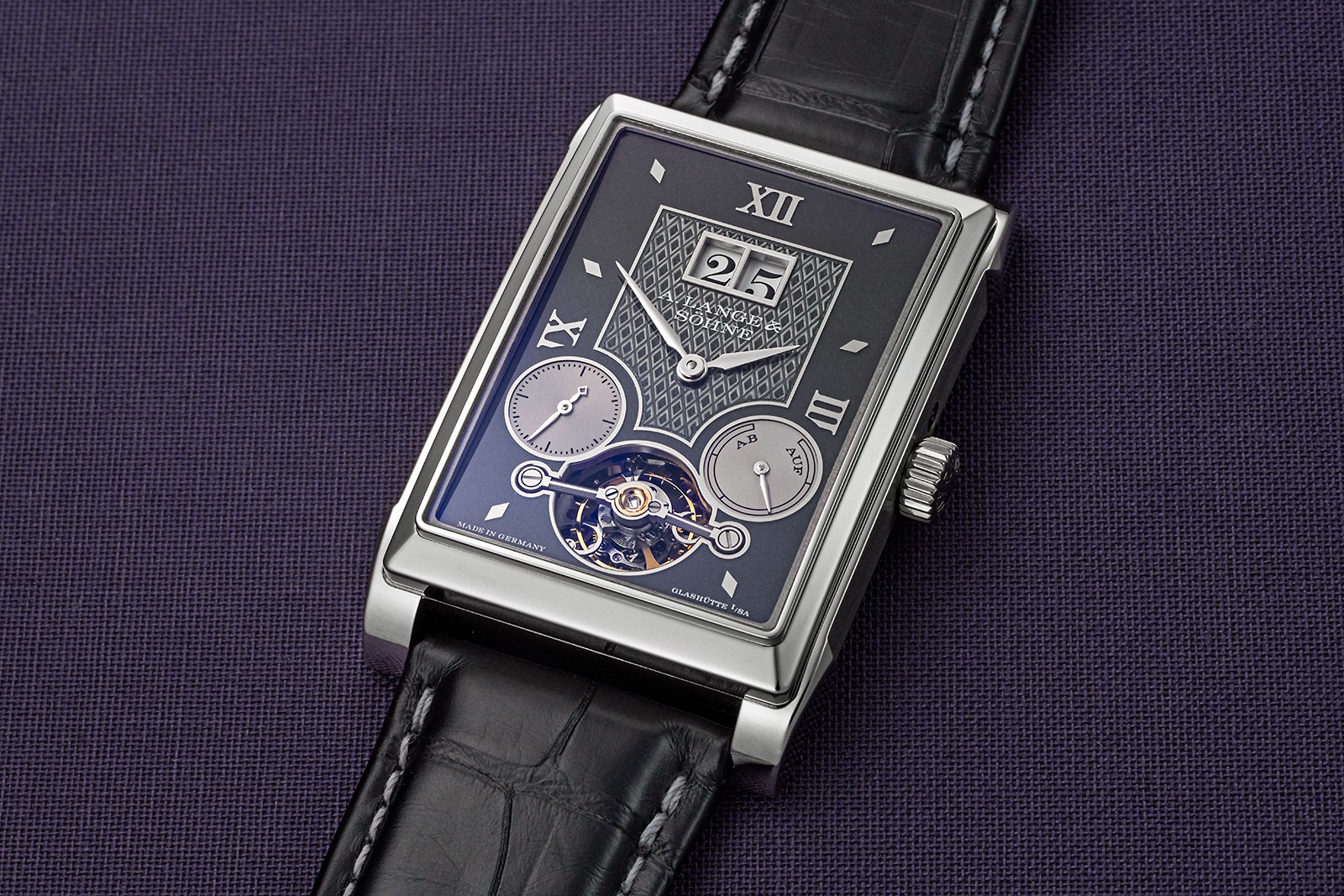
The platinum case is 39.2 mm by 29.5 mm and 10.3 mm in height
Alas, watches with such heavy focus on technical innovation and a less obvious complication visibility often run into the same problem: an audience that shrinks inversely to the price. As a result, some examples of the Cabaret Tourbillon (and the Cabaret line in general) gathered dust in boutiques and retailers for a decade. But now the model has been revived in majestic form.
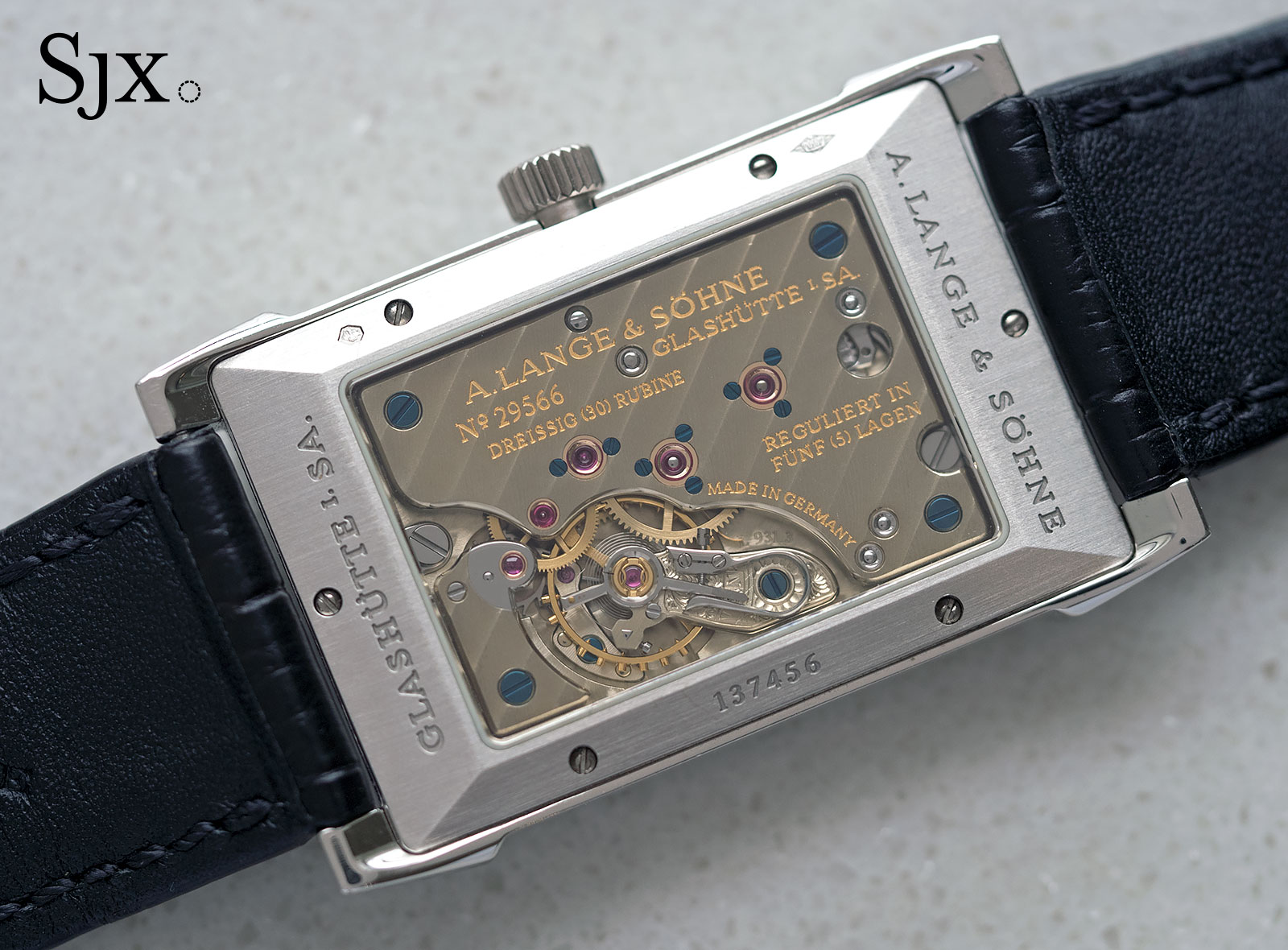
The movement in the original Cabaret with only time and date
The dial
For the first time, we see a geometric pattern on a Handwerkskunst dial, instead of the random tremblagé or fired enamel that is traditional for the series. It’s certainly a fitting choice, since the Cabaret is a watch that is all about on angular lines with a rectangular case.
Here the dial is finished with an engraved, repeating-diamond motif, with a diamond-shaped lattice – all done in 18k white gold.
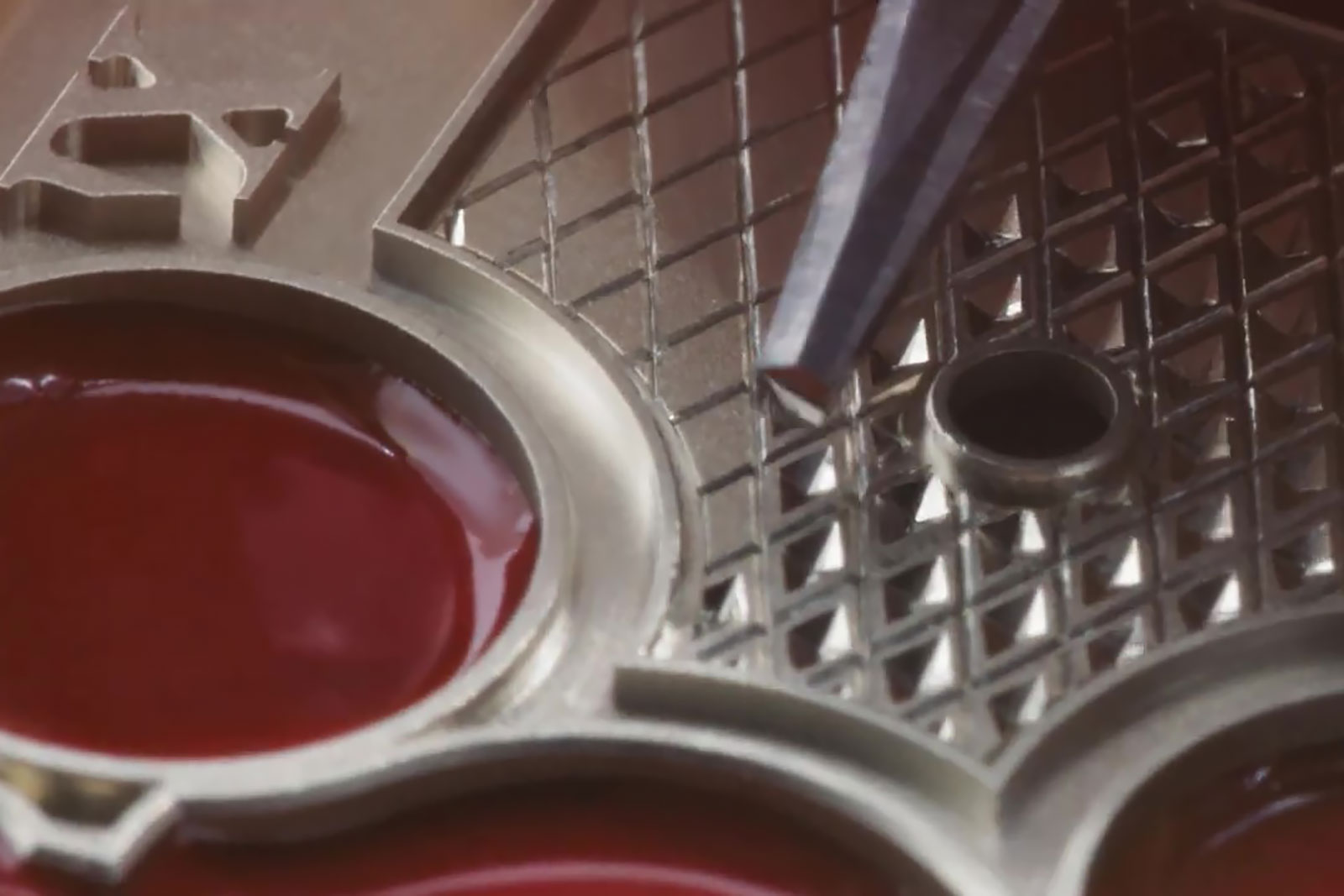
The engraving is naturally is done with a burin, a sharp-tipped tool that removes gold, done with a near-perfect depth and precision by the engraver
The familiar tremblagé surface, however, is not absent. It surrounds the relief portions formed by engraving, and splendidly contrasts against the geometric pattern in the centre of the dial.
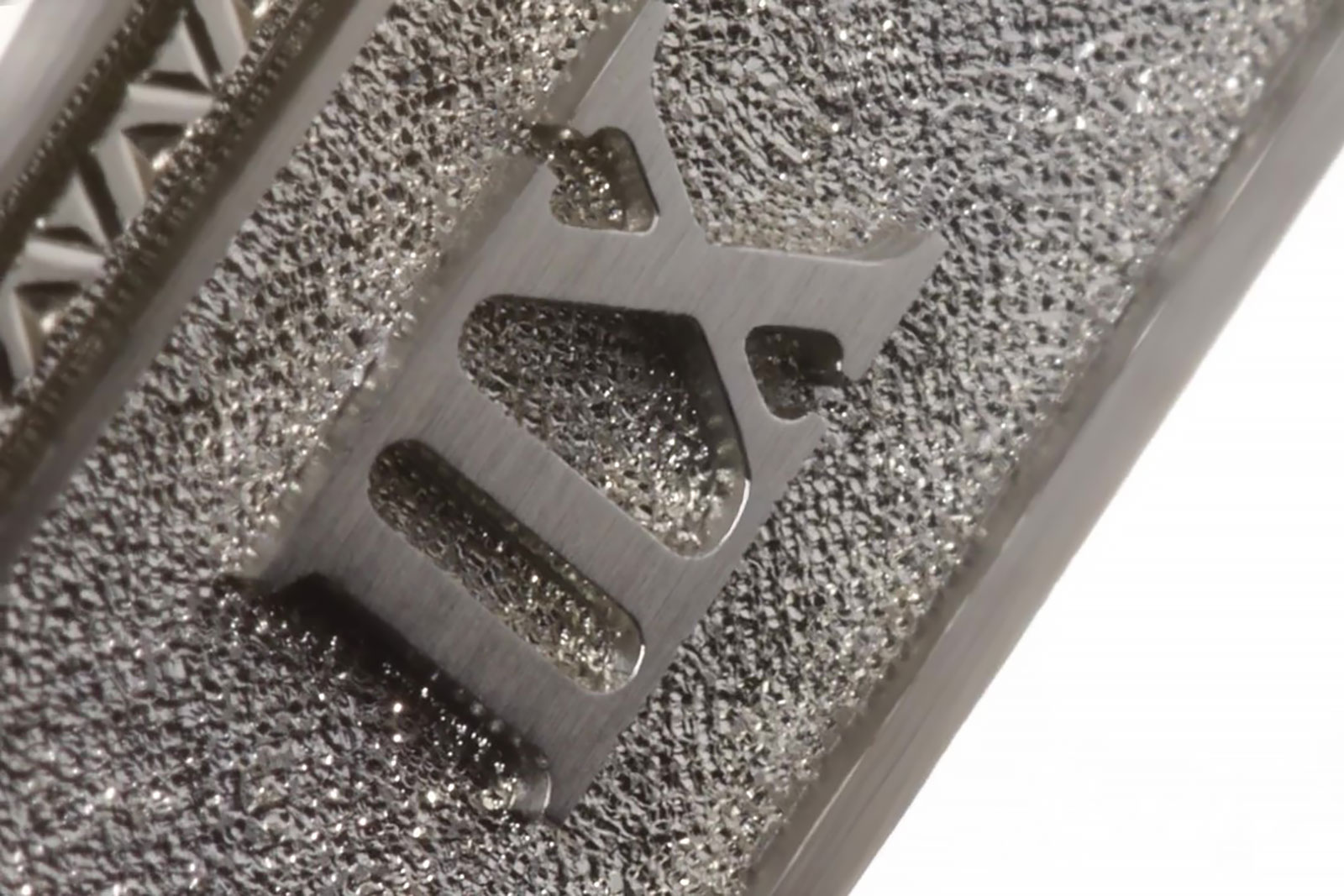
What’s more, in addition to the painstaking engraving, the dial is finished with fired enamel that has a translucent finish. Clearly this watch was conceived as a no-expense-spared showcase of Lange’s artisanal crafts.
The tourbillon carriage is identical to the one found in the Lange 1 Tourbillon, which is characterised by its open ends and distinct from the three-armed, closed version found on other Lange tourbillons that is modelled on the carriage found in Lange tourbillon pocket watches of the early 20th century.
Impressive with the immaculate black polish on both the carriage and faceted bridge, the tourbillon does not quite impress the same way as Lange’s other tourbillons that are larger, like the 1815 Tourbillon for example.
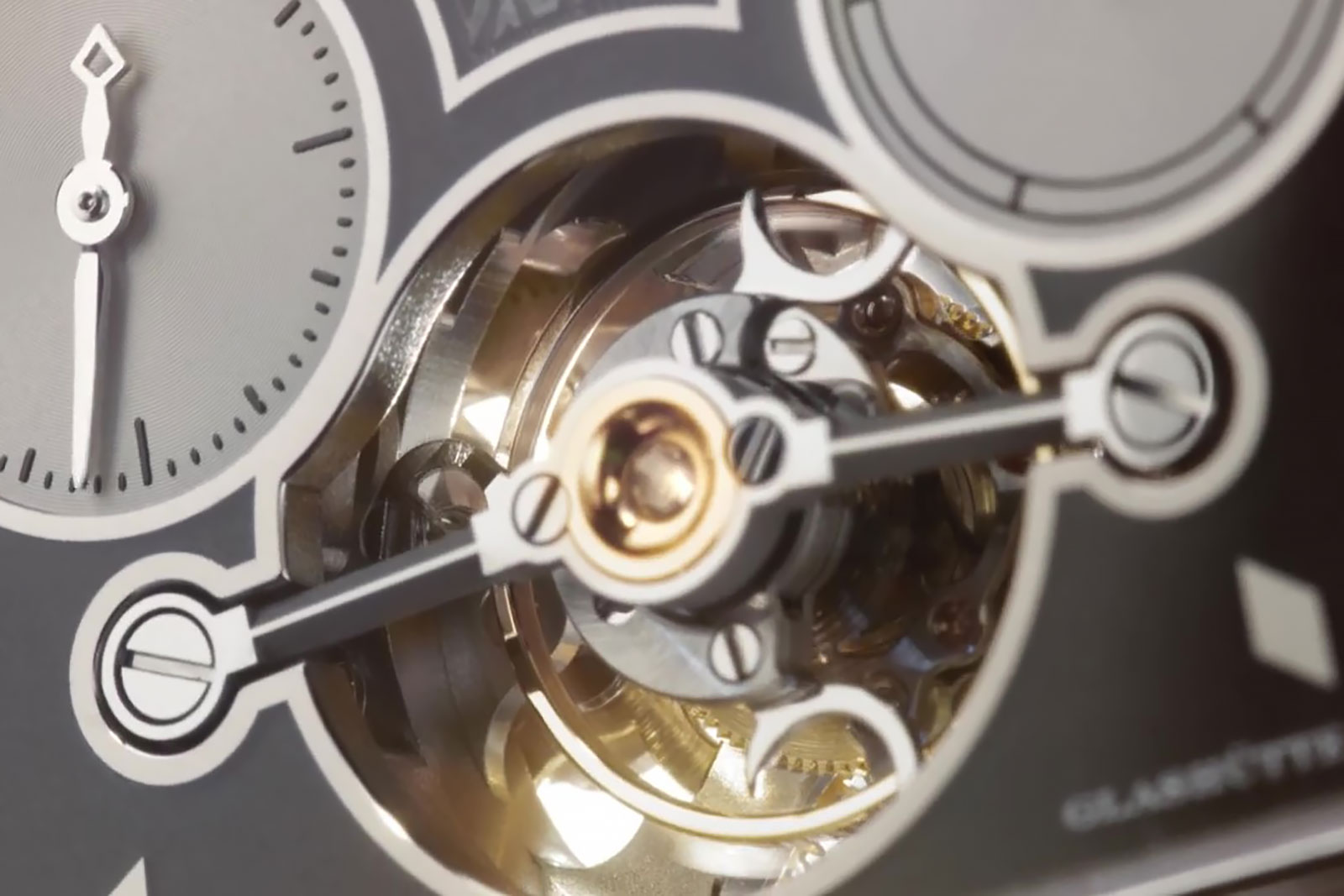
Overall, despite the array of patterns and decoration on the dial, the Cabaret Tourbillon Handwerkskunst is actually one of the most versatile Handwerkskunst editions. Its shades of grey match with the white metal brilliantly, and here the pairing is made even better with “panda”sub-dials and translucent enamel – it’s just a fantastic design.

L042.1
Lange is synonymous with engineering and finishing – movements have been of paramount importance for the brand since its founding. As a result, nearly all Lange watches are equipped with movements developed specifically for the model. When Lange launched the Cabaret in 1997, the brand endowed its first rectangular with a rectangular, form movement – a feat for a brand just a few years old.
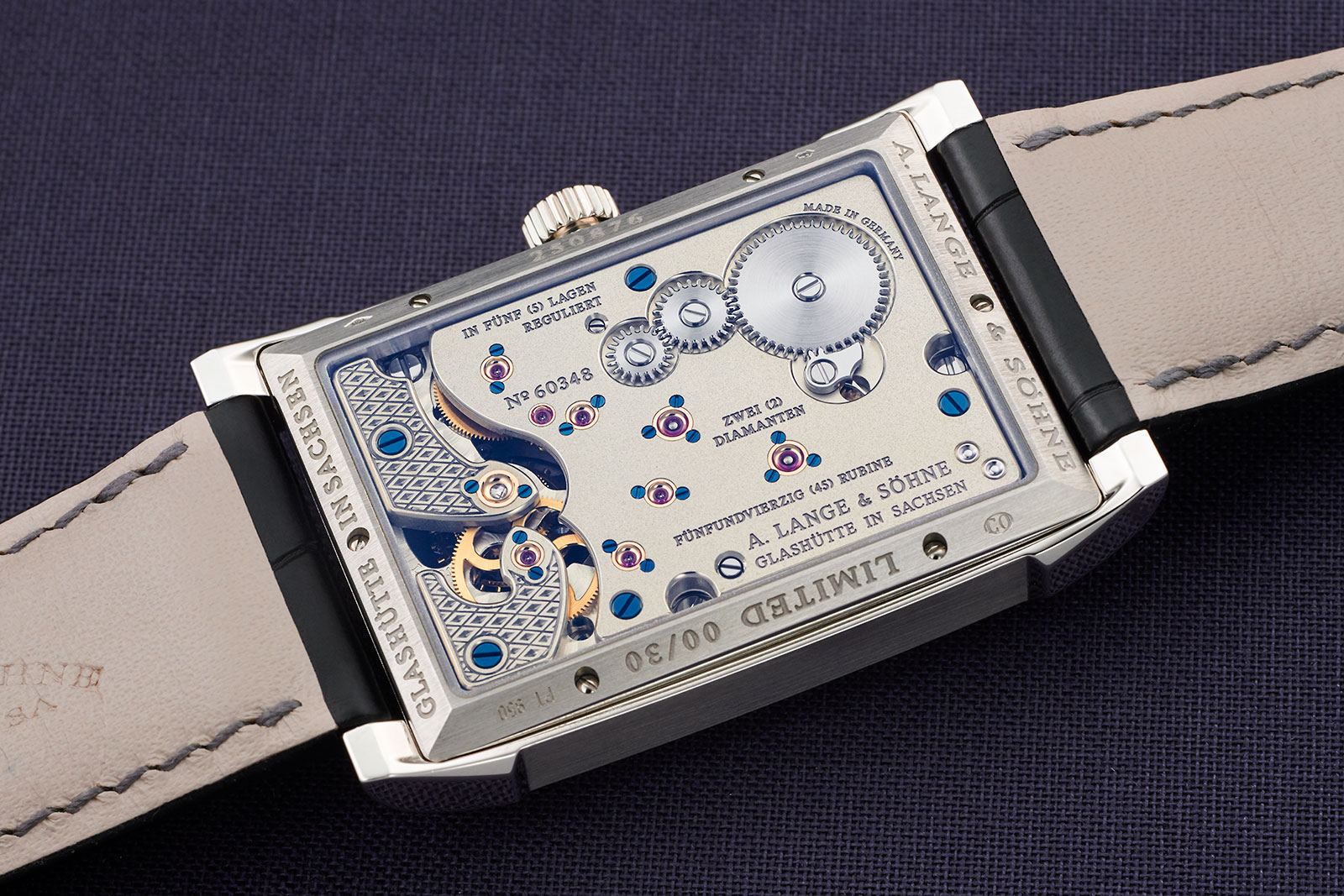
Over the years, Lange improved on the Cabaret calibre and in 2008, it culminated with the hacking-tourbillon mechanism found in the L042.1 of the Cabaret Tourbillon. It finished in typical Lange fashion – not overly ostentatious, but still offering some impressive hand finishing, especially with the numerous sharp, outward angles around the winding wheels.
While the Cabaret Tourbillon Handwerkskunst delivers on the dial side, I think it fails on the back. It falls into the same trap as both Handwerkskunst editions of the Richard Lange Tourbillon Pour le Mérite and Lange 1 Tourbillon Perpetual Calendar – the movement is just not different enough.
The key differences between this and the regular edition are a diamond-motif engraving like that on the dial; circular graining on the winding and barrel ratchet wheels, polished teeth for the same wheels; and a frosted finish on the bridges as like found on the 175th anniversary pieces.
There is no extra skeletonisation or additional sharp angles on the bevelling – features that would match the handwerkskunst appellation, which is German for “craftsmanship”. The 1815 Tourbillon Handwerkskunst on the other hand, is a brilliant example on how to improve on the regular model, even though the movement is largely covered with a big, three-quarter plate.
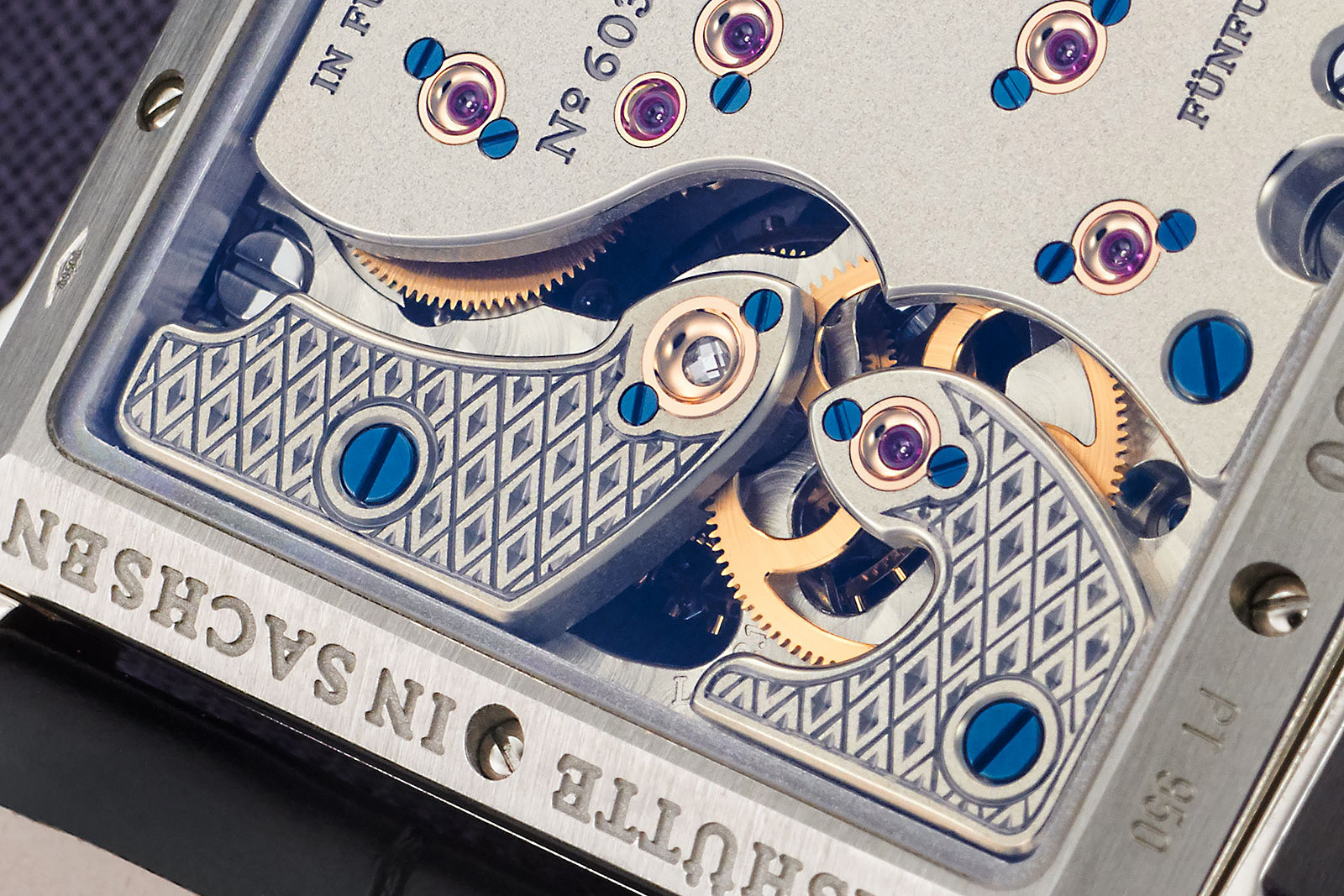
And from a technical perspective, the L042.1 is dated – it is not as revelatory as it was in 2008. Today, one can find hacking-tourbillon mechanisms in the watches of Moritz Grossmann as well as Glashütte Original – both are the neighbours of Lange. Indeed, the transfer market in Glashütte is always hot, and products like this prove that.
The value
Some collectors think that Cabaret Tourbillon Handwerkskunst is merely recycling. Indeed, up to a couple of years ago, you might have seen a platinum Cabaret Tourbillon in the showcase at the rather illogical retail price. So, it would make sense for Lange to taken some of those examples and dressed them up – accompanied by a higher retail price, justified in part by the incredible craftsmanship.
The Cabaret Tourbillon Handwerkskunst is limited to 30 pieces, with a retail price of a stratospheric €315,000 (or about US$370,000). Considering the fact that the 1815 Tourbillon Handwerkskunst retailed for US$181,000 in 2016 – with similar technical qualities and a bit less decoration – I think that the Cabaret Tourbillon Handwerkskunst is steeply priced – just like the regular version.
However, putting the market into perspective, the price becomes more understandable. As of September 2021, the values for Lumen and Handwerkskunst editions have gone through the roof, illustrated by the recent sale at Sotheby’s of a Zeitwerk Luminous for US$308,000 and the 1815 Rattrapante Perpetual Calendar Handwerkskunst that sold for US$600,000 at Phillips.
All in all, the Cabaret Tourbillon Handwerkskunst is certainly a unique watch and would sit right in any established A. Lange & Söhne collection.
2024 – Datograph Handwerkskunst (ref. 405.048F)
Conceived to mark the 25th anniversary of Lange’s trademark chronograph, the Datograph Handwerkskunst is a limited edition of 25 pieces in yellow gold with a tremblage dial along with a movement featuring additional decoration.
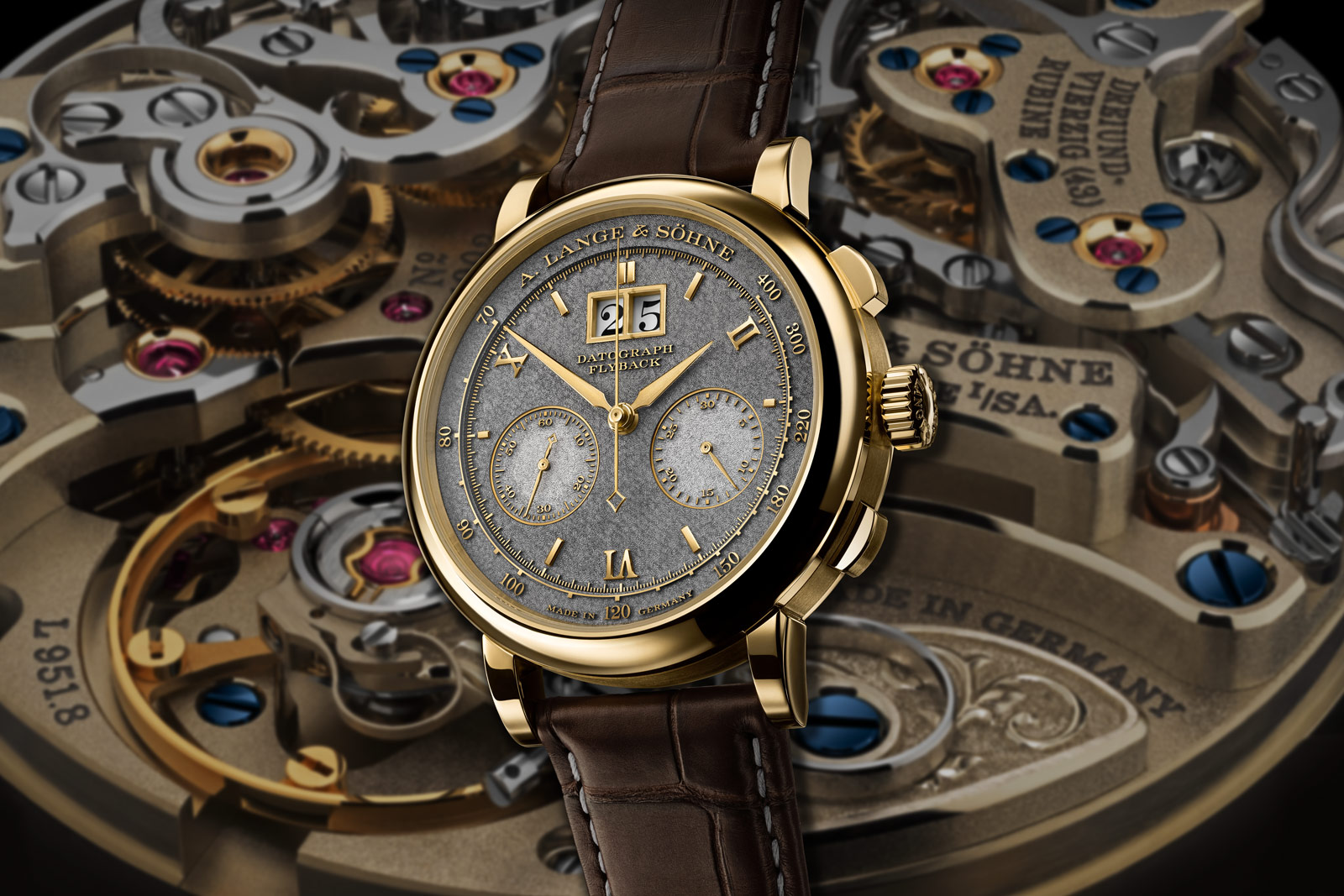
More details can be found in our story on the watch.
Conclusion
The Handwerkskunst line is, without a doubt, one of the brand’s most special collections. It is always delightful to see that there are many connoisseurs who appreciate more than just the tangible qualities of these art watches.
Because apart from the tangible beauty, what resounds about the Handwerkskunst is the story behind each one; the concept, philosophy and people that made them possible. Every Handwerkskunst watch tells us about the brand’s respect for the past and the region, as well as a passion to go one step further. It’s the reason for my admiration for the passionate people in Glashütte.
Author’s note: I would like to express gratitude to my watchmaker friends, Anthony de Haas in particular, and the helpful and passionate public-relations team in Glashütte, for providing information and anecdotes that were invaluable for this article.
Better known as Langepedia on Instagram, the author is a lifelong fan of A. Lange & Söhne. True to his passion, he joined the brand straight out of school, and was a trainee in the marketing and public relations department in Glashütte from April 2019 to February 2020.
Update September 19, 2021: Addition of Cabaret Tourbillon Handwerkskunst.
Update September 11, 2024: Addition of Datograph Handwerkskunst.
Back to top.